
From Duncan to Chickasha and OKC to Fairview and Elk City, the Byford Auto Group does things the Cowboy way! We stand by our word and treat people right. Whether you need a hard working half-ton or a work horse diesel, an SUV or car, Byford has you covered with a great selection and unbeatable prices. Come see why NOBODY TREATS YOU BETTER THAN BYFORD.



BYFORD CHRYSLER DODGE JEEP RAM 8703 N. Hwy. 81 • 580-701-4760 BYFORD CHEVY BUICK GMC 7755 N. Hwy. 81 • 580-255-0550 BYFORD NISSAN 114 Access Road BYFORD CHRYSLER DODGE JEEP RAM 3121 S. 4th St. • 405-455-8098 BYFORD BUICK GMC 2099 S. Hwy. 81 • 405-224-0475 BYFORD CHRYSLER DODGE JEEP RAM 2204 Commerce St. • 580-227-4405 BYFORD FORD 2204 Commerce St. • 580-227-4405 BYFORD MOTORS I-240 & SHIELDS • 405-996-2600 GOLDKEY SERVICE CENTER MacArthur & Memorial • 405-603-4545 DUNCAN ELK CITY CHICKASHA FAIRVIEW OKC

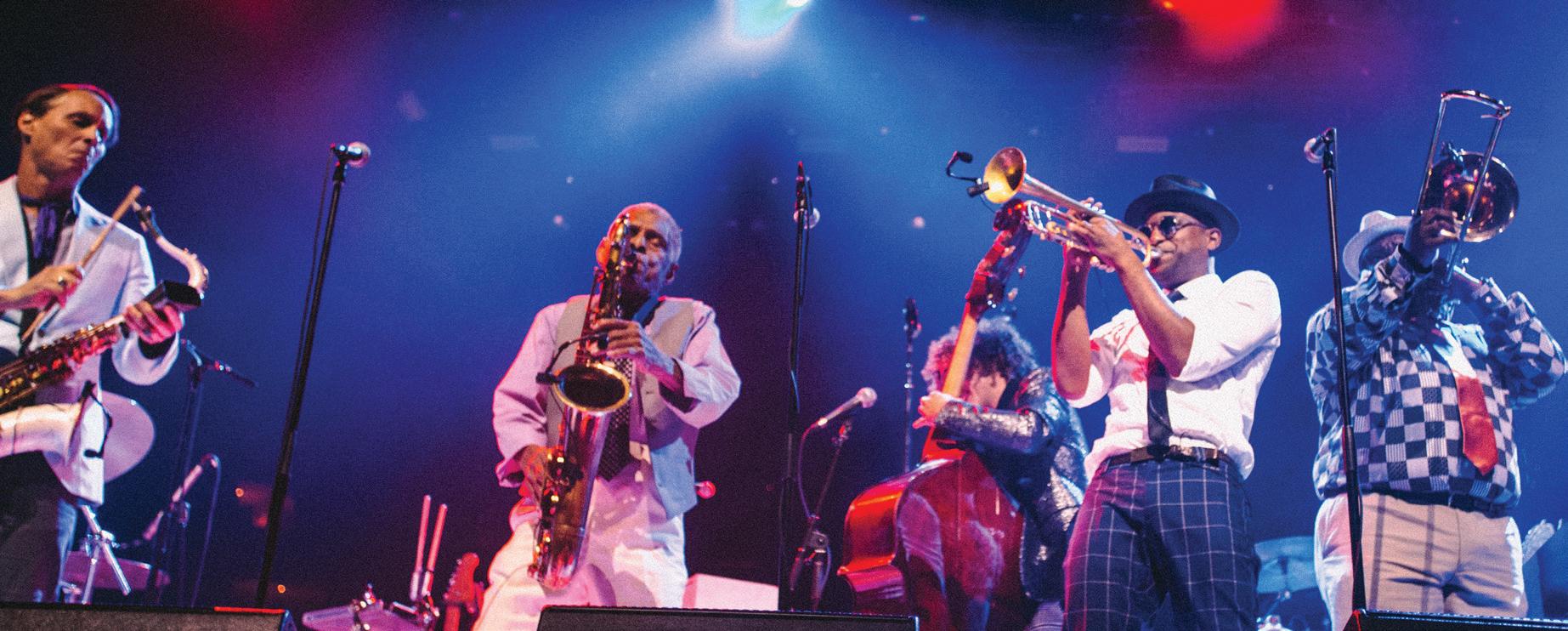


View the full Inaugural Season lineup at McKnightCenter.org Box Office: (405) 744-9999 Your newest home for the arts The curtain goes up at this fall at The McKnight Center for the Performing Arts in Stillwater. Performances are selling out – order your tickets today! New York Philharmonic with Kelli O’Hara | OCTOBER 11-13 The Phantom of the Opera | OCTOBER 31 Chamber Music Festival | NOVEMBER 9-10 Cirque Mechanics | NOVEMBER 22-23 Rudolph the Red-Nosed Reindeer | DECEMBER 12

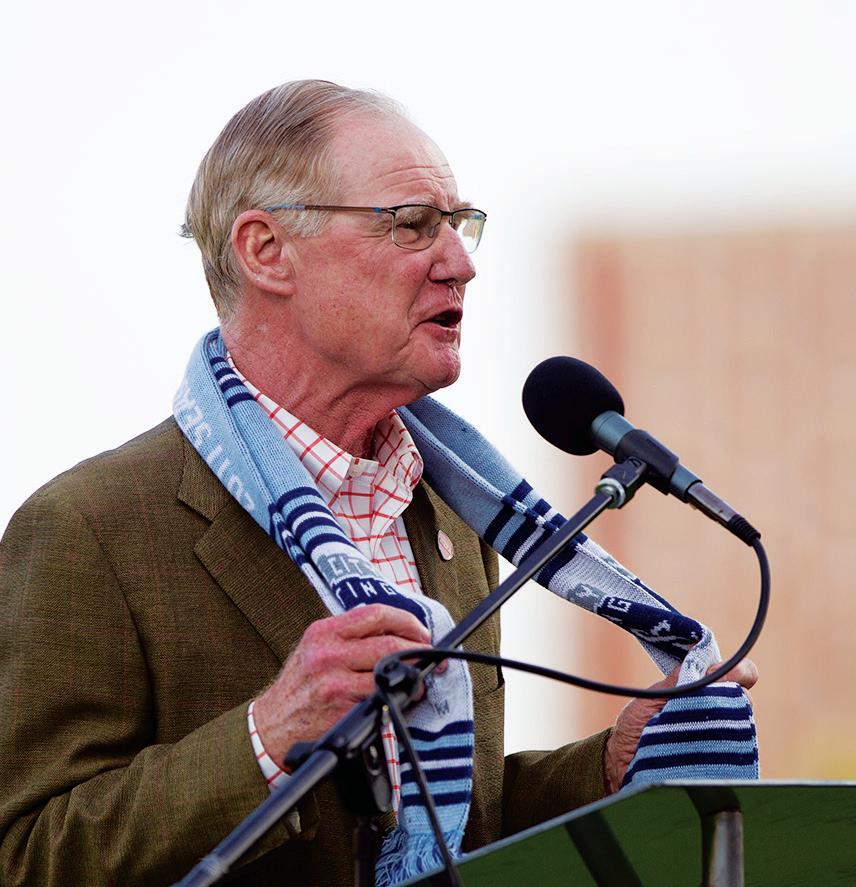



The 150 62 The Honor Roll 72 WRAVINGS watch it or feel it? 82 DEPARTMENTS SINCLAIRE JOHNSON Fast Forward 16 LINDY WATERS III Carrying the Name 26 DATON FIX The Latest Greatest ... 34 VIVIAN GRAY Gray Matters 44 BURNS HARGIS A Leader and a Teammate 50 JIM CLICK All-Around Cowboy 74 FEATURES COVER PHOTO BY COURTNEY BAY 5 POSSE
DEFINING MOMENTS
BY KEVIN KLINTWORTH Senior Associate Athletic Director
There are many ways to define the modern era of college athletics. Some think the modern era of college football started in 1900. Others say it was after World War II. A third precinct insists it all began in the 1950s and 1960s as first radio and then television showcased the sport to a broader audience, breaking its history of existing only in the form of regional rivalries.
College basketball is different. There has been an NCAA Tournament champion every year since 1939, without debates, multiple national champions or hypothetical winners. It’s all simple and bracket-like.
In the eyes of many, Oklahoma State’s basketball history can also be categorized. There are the Iba years (decades actually) and the “modern era” that most think kicked in with the arrival of Eddie Sutton . Those are broad strokes and not meant to diminish the exciting teams of Paul Hansen (1983 Big Eight Tournament champs), the Leonard Hamilton building years, which included several foundational pieces left for Sutton, nor the men who had the unenviable task of following in Mr. Iba’s immediate footsteps.

But it was Sutton who reignited the basketball spark in the eyes of OSU fans. His first five teams lost a total of four games in Gallagher-Iba Arena. OSU recorded one NCAA Tournament win from 1959 until 1990. Sutton had two his first season in Stillwater.
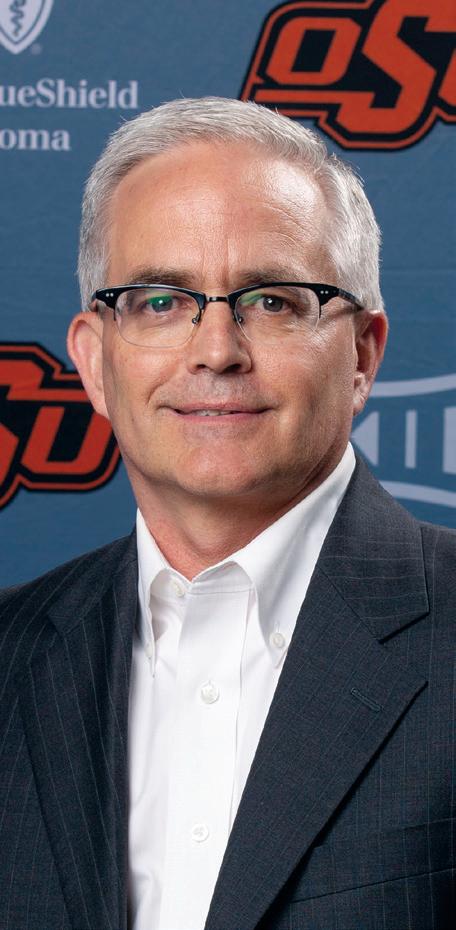
But it was the 1994-1995 team, 25 seasons ago, when the Cowboys truly re-emerged on the national scene with a magical run to the Final Four.
That team had a hall of fame coach, a legendary player known nationwide not only by his name, but also his nickname. There was an all-conference shooter with biggame buckets, a freshman not afraid of the big stage, the “Toothless In Seattle” t-shirt and a fan base that grew more delirious with each passing round of the tournament. March Madness truly engulfed the OSU faithful.
In an earlier POSSE Magazine piece, Gary and Claudia Humphreys, whose names you might recognize from the Boone Pickens Stadium video board, described not having the finances in place to attend the 1995 Final Four in Seattle. They decided to throw caution to the wind and head northwest anyway.
There was an OSU student, the son of a preacher, who “borrowed” his father’s fourseat Cessna and then hired another OSU student to fly him to Seattle for the Final Four. He paid for the trip by selling the back seats of the plane to two more OSU students. You now know him as Gov. Kevin Stitt .
In many ways that 1995 Final Four team, led by Bryant “Big Country” Reeves, and shooter extraordinaire Randy Rutherford, paved the way for the Oklahoma State we know today. The expansion of Gallagher-Iba Arena from just over 6,000 seats into today’s 13,611 came in part due to the waiting list for Cowboy season tickets.
An athletic department which had always prided itself on the success of its entire portfolio, suddenly saw its brand expanded by those three weeks in March.
Under Eddie Sutton, there would be lots of successes. A trip to the Elite Eight in 2000, another Final Four run in 2004 and a total six appearances in the Sweet 16.
But in many ways it was that 1995 team, a quarter of a century ago, that showed it could happen, again, at Oklahoma State. The biggest achievements in the history of the school didn’t have to be viewed on old black and white film. The size of the building didn’t matter. Neither did the budget, or the location. There was life in the OSU basketball program after Mr. Iba.
All things were possible, even in the modern era. Thanks, 1995 Cowboys!
FALL 2019 4
POSSE Magazine Staff
VICE PRESIDENT OF ENROLLMENT AND BRAND MANAGEMENT
KYLE WRAY
EDITOR-IN-CHIEF / SENIOR ASSOCIATE ATHLETIC DIRECTOR KEVIN KLINTWORTH
SENIOR ASSOCIATE ATHLETIC DIRECTOR / EXTERNAL AFFAIRS
ART DIRECTOR / DESIGNER
PHOTOGRAPHER / PRODUCTION ASSISTANT
ASSISTANT EDITOR
CONTRIBUTING PHOTOGRAPHERS
CONTRIBUTING WRITERS
JESSE MARTIN
DAVE MALEC
BRUCE WATERFIELD
CLAY BILLMAN
GARY LAWSON, PHIL SHOCKLEY
COURTNEY BAY
CLAY BILLMAN, RYAN CAMERON
HALLIE HART, JOHN HELSLEY
GENE JOHNSON, KEVIN KLINTWORTH
ROGER MOORE, KYLE WRAY
Athletics Annual Giving (POSSE) Development Staff
ASSOCIATE ATHLETIC DIRECTOR / ANNUAL GIVING
PUBLICATIONS COORDINATOR
ASSISTANT DIRECTOR, ANNUAL GIVING
ASSISTANT DIRECTOR, ANNUAL GIVING / EVENT COORDINATOR
DONOR RELATIONS AND GIFT PROCESSING SPECIALIST
Athletics Major Gift Development Staff
SENIOR ASSOCIATE ATHLETIC DIRECTOR / DEVELOPMENT
ELLEN AYRES
CLAY BILLMAN
RYAN SEVERSON
ALEXA ABLE
ADDISON UFKES
LARRY REECE
ASSISTANT ATHLETIC DIRECTOR, DEVELOPMENT
OSU POSSE
102 ATHLETICS CENTER STILLWATER, OK 74078-5070 405.744.7301 P 405.744.9084 F OKSTATEPOSSE.COM @OSUFANEX POSSE@OKSTATE.EDU
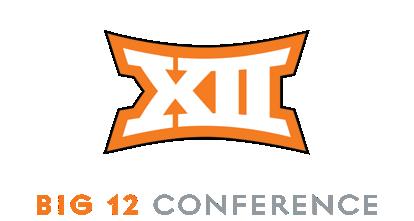
ADVERTISING 405.744.7301 EDITORIAL 405.744.1706
SHAWN TAYLOR
MATT GRANTHAM ASSISTANT ATHLETIC DIRECTOR, DEVELOPMENT
At Oklahoma State University, compliance with NCAA, Big 12 and institutional rules is of the utmost importance. As a supporter of OSU, please remember that maintaining the integrity of the University and the Athletic Department is your first responsibility. As a donor, and therefore booster of OSU, NCAA rules apply to you. If you have any questions, feel free to call the OSU Office of Athletic Compliance at 405-744-7862 . Additional information can also be found by clicking on the Compliance tab of the Athletic Department web-site at okstate.com
Remember to always “Ask Before You Act.”
Respectfully, BEN DYSON ASSOCIATE ATHLETIC DIRECTOR FOR COMPLIANCE
Donations received may be transferred to Cowboy Athletics, Inc. in accordance with the Joint Resolution among Oklahoma State University, the Oklahoma State University Foundation, and Cowboy Athletics, Inc.

POSSE magazine is published four times a year by Oklahoma State University Athletic Department and the POSSE, and is mailed to current members of the POSSE. Magazine subscriptions available by membership in the POSSE only. Membership is $150 annually. Postage paid at Stillwater, OK, and additional mailing offices. Oklahoma State University, in compliance with Title VI and VII of the Civil Rights Act of 1964, Executive Order 11246 as amended, and Title IX of the Education Amendments of 1972 (Higher Education Act), the Americans with Disabilities Act of 1990, and other federal and state laws and regulations, does not discriminate on the basis of race, color, national origin, sex, age, sexual orientation, gender identity, religion, disability, or status as a veteran, in any of its policies, practices or procedures. This provision includes, but is not limited to admissions, employment, financial aid, and educational services. The following have been designated to handle inquiries regarding non-discrimination policies: Director of Equal Opportunity, 408 Whitehurst, OSU, Stillwater, OK 74078-1035; Phone 405-744-9154; email: eeo@okstate.edu.
This publication, issued by Oklahoma State University as authorized by the Senior Associate Athletic Director, POSSE, was printed by Royle Printing Company at a cost of $1.136 per issue. 9.5M/October 2019/#8166. POSSE
paid at Stillwater, OK, and additional mailing offices.

magazine is published four times a year by Oklahoma State University, 307 Whitehurst
The magazine is produced by OSU Athletics and University Marketing, and is mailed to current members of the POSSE
Membership starts at
benefits such as the POSSE Magazine and member auto decals. POSSE annual funds
to student-athlete
operating expenses, which are critical to helping our teams stay competitive. Gifts of all
all
of athletics. Postage
Stillwater, OK 74078.
Association.
$150/year and includes
contribute
scholarships and
sizes impact
areas
POSSE MAGAZINE FALL 2019 FALL 2019 6

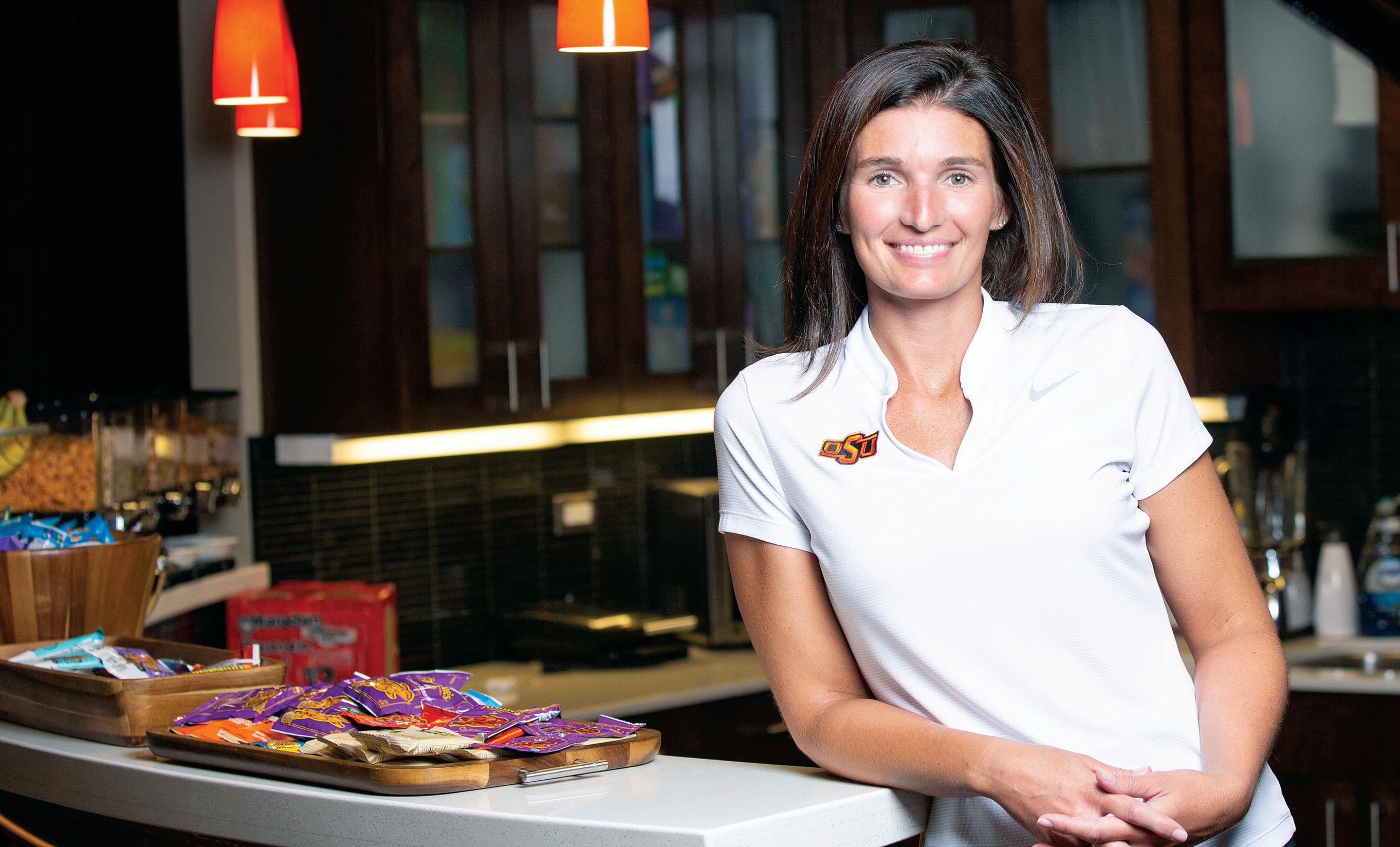

IT’S ABOUT ESTABLISHING HABITS THAT WILL BENEFIT THEM FOR THE REST OF THEIR LIVES.
CHARLES HEWITT
9 POSSE
JENNY BOYNTON
Here’s the thing about working with college students: They aren’t always the healthiest of eaters. They have schedules that are different than say the rest of the civilized world. They eat at different hours. They eat in different ways. They are making their own choices for the first times in their lives. It’s about establishing habits that will benefit them for the rest of their lives.
OSU Athletics, for the first time, has a blossoming staff of nutritionists who are on the front lines when it comes to the eating habits of student-athletes.


The short version is that the nutritionists help the student-athletes eat better. But that is a very simplistic view of their job. Some athletes are trying to gain weight. Some are trying to lose. Some are rearranging their bodies. Some have bad habits. Some have unique challenges due to nothing but the body chemistry they inherited.
They are all different. And they are all surrounded by peers who order pizza at 1:30 a.m.
For OSU’s staff, it’s about helping student-athletes in one of the most important ways possible.
In other words, no one is making them eat their vegetables. ALMOST NO ONE.
FALL 2019 8
IN OTHER WORDS, they are surrounded by people who don’t eat their vegetables.
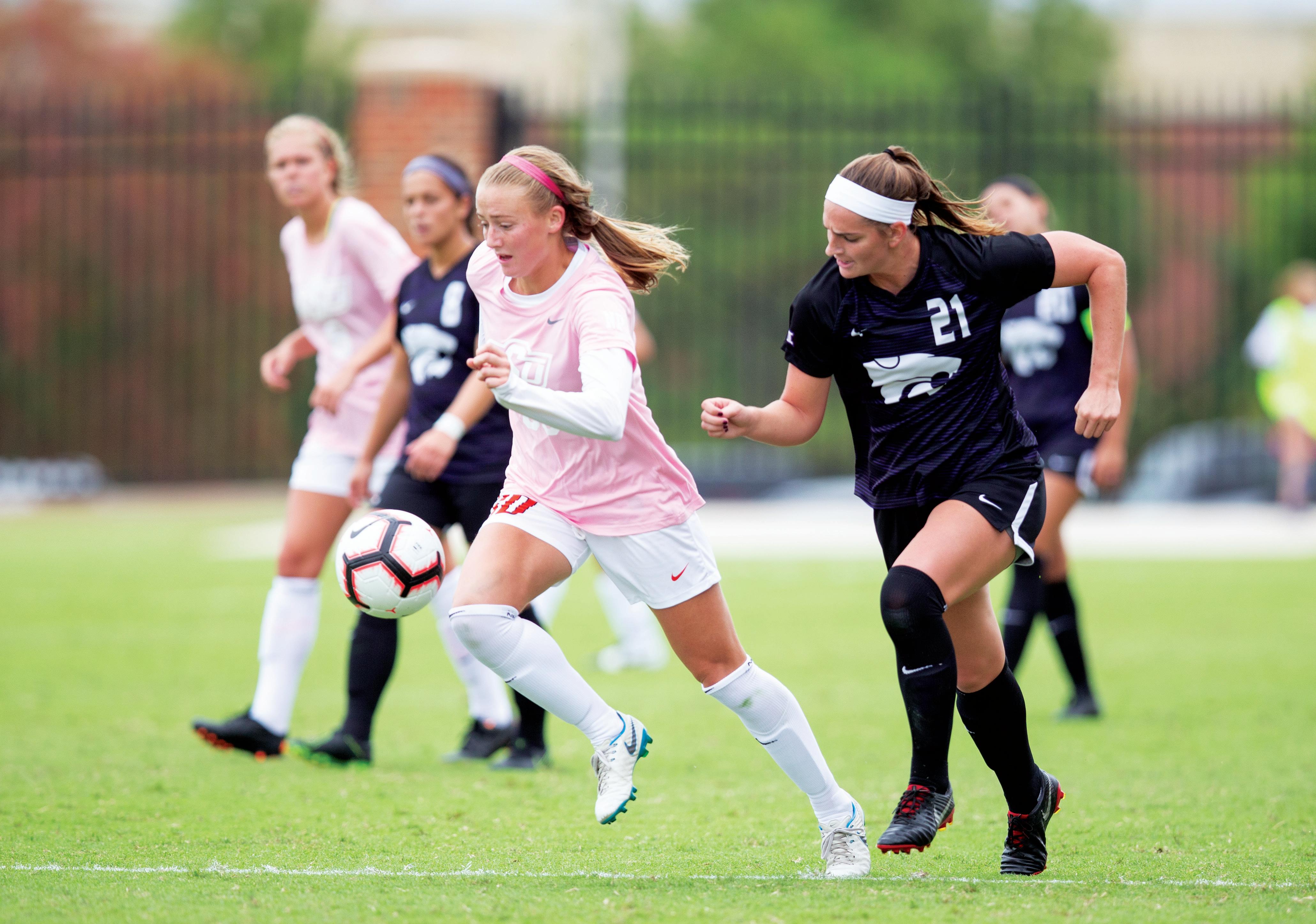
FALL 2019 10
THINK PINK
Wearing pink jerseys for Breast Cancer Awareness month, the Cowgirls knocked off Kansas State 2-1 at Neal Patterson Stadium.
PHOTOBYBRUCEWATERFIELD

11 POSSE
CANADA'S COWBOY
The NCAA's leading rusher, Chuba Hubbard, sprinted into the (inter)national spotlight this season.
PHOTOBYBRUCEWATERFIELD

FALL 2019 12

13 POSSE
A FINAL MESSAGE
Boone Pickens reflected on his life, legacy and advice before he passed

If you are reading this, I have passed on from this world — not as big a deal for you as it was for me.
In my final months, I came to the sad reality that my life really did have a fourth quarter and the clock really would run out on me. I took the time to convey some thoughts that reflect back on my rich and full life.
I was able to amass 1.9 million LinkedIn followers. On Twitter, more than 145,000 (thanks, Drake). This is my goodbye to each of you.
One question I was asked time and again: What is it that you will leave behind?
That’s at the heart of one of my favorite poems, “Indispensable Man,” which Saxon White Kessinger wrote in 1959. Here are a few stanzas that get to the heart of the matter:
Sometime when you feel that your going Would leave an unfillable hole, Just follow these simple instructions And see how they humble your soul; Take a bucket and fill it with water, Put your hand in it up to the wrist, Pull it out and the hole that’s remaining Is a measure of how you’ll be missed.
You can splash all you wish when you enter, You may stir up the water galore, But stop and you’ll find that in no time It looks quite the same as before.
You be the judge of how long the bucket remembers me.
I’ve long recognized the power of effective communication. That’s why in my later years I began to reflect on the many life lessons I learned along the way and shared them with all who would listen.
Fortunately, I found the young have a thirst for this message. Many times over the years, I was fortunate enough to speak at student commencement ceremonies, and that gave me the chance to look out into a sea of the future and share some of these thoughts with young minds. My favorite of these speeches included my grandchildren in the audience.
What I would tell them was this Depressionera baby from tiny Holdenville, Oklahoma — that wide expanse where the pavement ends, the West begins and the Rock Island crosses the Frisco — lived a pretty good life.
In those speeches, I’d always offer these future leaders a deal: I would trade them my wealth and success, my 68,000-acre ranch and private jet, in exchange for their seat in the audience. That way, I told them, I’d get the opportunity to start over, experience every opportunity America has to offer.
It’s your shot now.
If I had to single out one piece of advice that’s guided me through life, most likely it would be from my grandmother, Nellie Molonson. She always made a point of making sure I understood that on the road to success, there’s no point in blaming others when you fail.
FALL 2019 14
The following message from T. Boone Pickens was written prior to his passing on Sept. 11, 2019. Mr. Pickens’ website and social media accounts are now being maintained by T. Boone Pickens Foundation team members.
Here’s how she put it:
“Sonny, I don’t care who you are. Someday, you’re going to have to sit on your own bottom.”
After more than half a century in the energy business, her advice has proven itself to be spot-on time and time again. My failures? I never have any doubt whom they can be traced back to. My successes? Most likely the same guy.
Never forget where you come from. I was fortunate to receive the right kind of direction, leadership, and work ethic — first in Holdenville, then as a teen in Amarillo, Texas, and continuing in college at what became Oklahoma State University. I honored the values my family instilled in me and was honored many times over by the success they allowed me to achieve.
I also long practiced what my mother preached to me throughout her life — be generous. Those values came into play throughout my career, but especially so as my philanthropic giving exceeded my substantial net worth in recent years.
For most of my adult life, I’ve believed that I was put on Earth to make money and be generous with it. I’ve never been a fan of inherited wealth. My family is taken care of, but I was far down this philanthropic road when, in 2010, Warren Buffet and Bill Gates asked me to take their Giving Pledge, a commitment by the world’s wealthiest to dedicate the majority of their wealth to philanthropy. I agreed immediately.

I liked knowing that I helped a lot of people. I received letters every day thanking me for what I did, the change I fostered in other people’s lives. Those people should know that I appreciated their letters.
My wealth was built through some key principles, including:
• A good work ethic is critical.
• Don’t think competition is bad, but play by the rules. I loved to compete and win. I never wanted the other guy to do badly; I just wanted to do a little better than he did.
• Learn to analyze well. Assess the risks and the prospective rewards, and keep it simple.
• Be willing to make decisions. That’s the most important quality in a good leader: Avoid the “Ready-aim-aimaim-aim” syndrome. You have to be willing to fire.
• Learn from mistakes. That’s not just a cliché. I sure made my share. Remember the doors that smashed your fingers the first time and be more careful the next trip through.
• Be humble. I always believed the higher a monkey climbs in the tree, the more people below can see his ass. You don’t have to be that monkey.
• Don’t look to government to solve problems — the strength of this country is in its people.
• Stay fit. You don’t want to get old and feel bad. You’ll also get a lot more accomplished and feel better about yourself if you stay fit. I didn’t make it to 91 by neglecting my health.
• Embrace change. Although older people are generally threatened by change, young people loved me because I embraced change rather than running from it. Change creates opportunity.
• Have faith, both in spiritual matters and in humanity, and in yourself. That faith will see you through the dark times we all navigate.
Over the years, my staff got used to hearing me in a meeting or on the phone asking, “Whaddya got?” That’s probably what my Maker is asking me about now.
Here’s my best answer.
I left an undying love for America and the hope it presents for all. I left a passion for entrepreneurship and the promise it sustains. I left the belief that future generations can and will do better than my own.
Thank you. It’s time we all move on.
15 POSSE
SINCLAIRE JOHNSON CAN’T SLOW DOWN. WON’T SLOW DOWN.
All Johnson has done in the last six months is win a national championship, shatter two school records, earn ALL-AMERICA HONORS indoors and outdoors, claim THREE BIG 12 TITLES … and oh yeah … RUN WORLD CHAMPIONSHIP QUALIFYING TIMES IN TWO EVENTS!

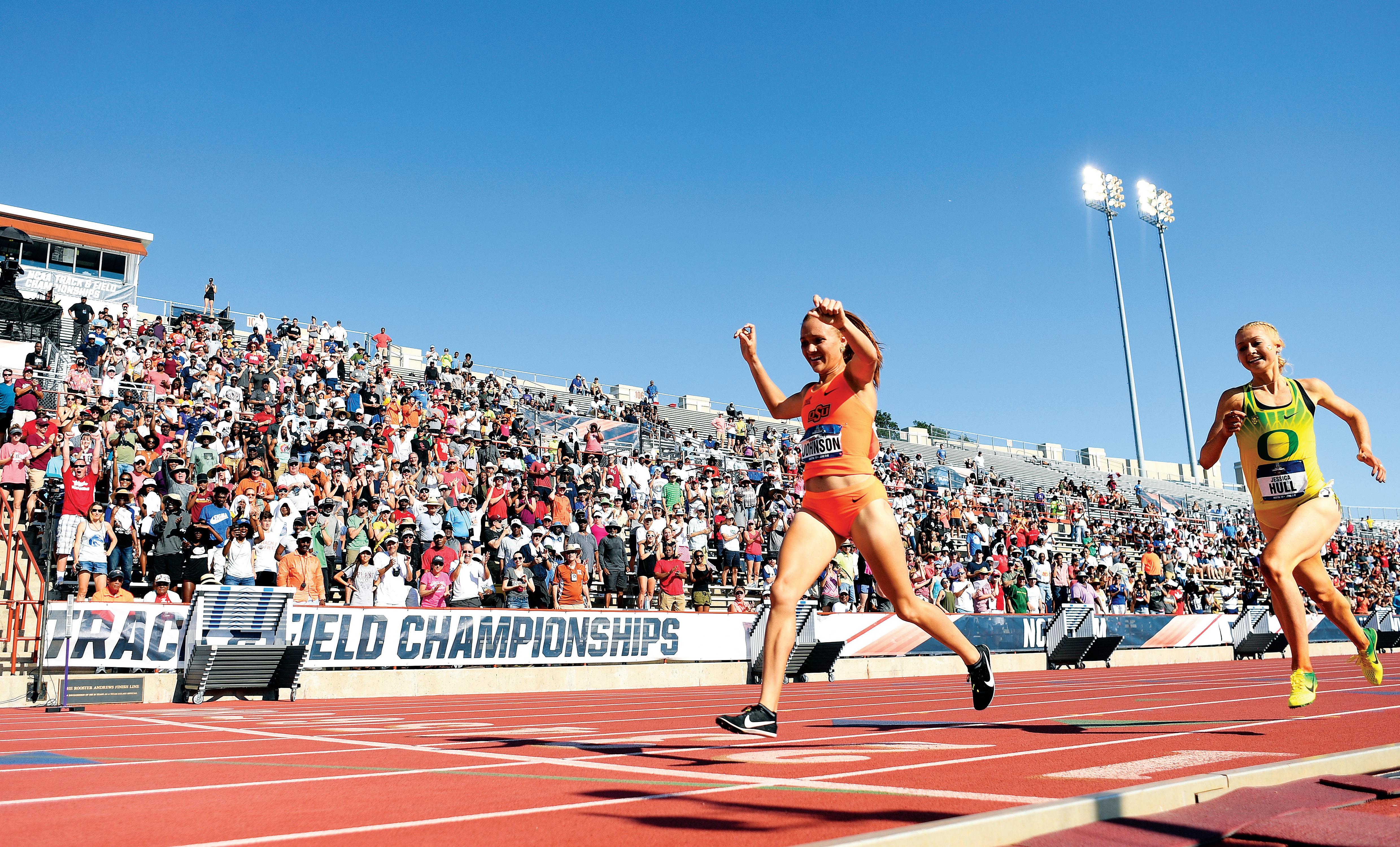
FAST
FORWARD
AT LEAST THAT’S HOW IT SEEMS FOR THE CONFIDENT COWGIRL RUNNER.
STORY BY CLAY BILLMAN | PHOTO BY JAMIE SCHWABEROW, NCAA PHOTOS
FALL 2019 16
FORWARD


17 POSSE


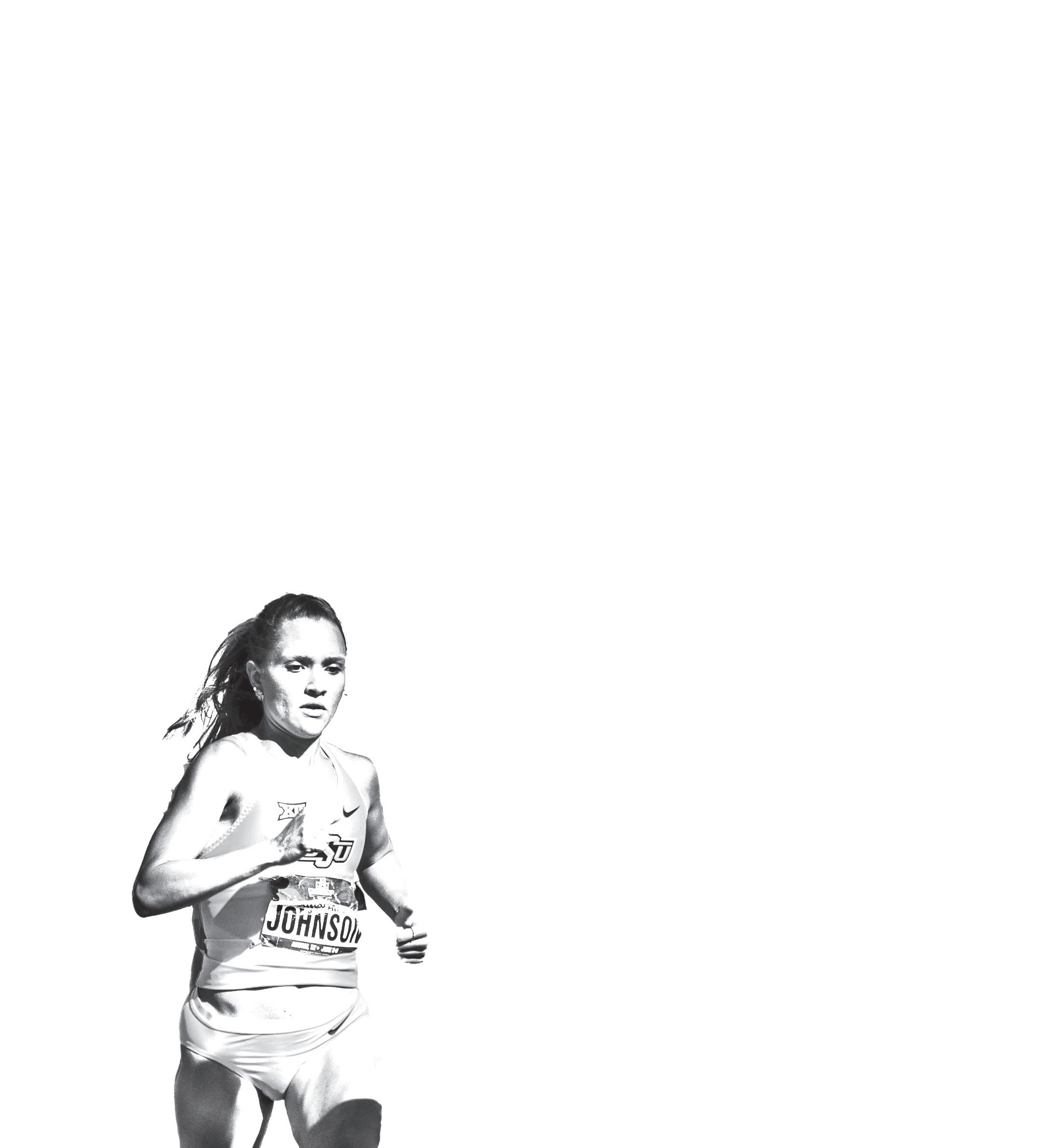
IN WHAT HAS BEEN CALLED THE GREATEST 1,500M RACE IN WOMEN’S NCAA HISTORY, A COWGIRL CLAIMED THE CROWN.
FALL 2019 18
PHOTOS BY CLAY BILLMAN
The junior from Longwood, Fla., burst onto the scene in 2019 after showing flashes of her potential on the track and cross country course last year.
A coveted recruit with five state championships under her belt, Johnson had expectations of immediate success in Stillwater, but her first two years on campus were marked by injury, setbacks and personal disappointment, she says. Johnson admits she even thought of hanging up the spikes.
Now she’s a rising star in the track and field world, pursuing opportunities many runners dream of but only a select few are afforded.
Johnson says she weighed the plusses and minuses of turning professional versus another year competing as a collegian, and decided the time was right.
“I just feel ready to take that next step in my career,” Johnson explains. “It’s exciting. I obviously didn’t think it was going to happen this soon, but I feel like I need to take advantage of this opportunity.
“I feel like I belong (at the next level),” she says.
The clock doesn’t lie. Johnson belongs among the nation’s best. That was proved at the recent USA Track & Field National Championships in Des Moines, Iowa, where Johnson toed the line against a field of decorated professionals, including Olympians Jenny Simpson, Shelby Houlihan and Kate Grace.
With a trip to the World Championships at stake for the top three finishers, Johnson held her own against America’s best 1,500meter runners, finishing fourth by a narrow margin of two-tenths of a second. Her time of 4:03.72 was a personal best and the thirdfastest ever by a collegian. It also beat the 2020 Olympic qualifying standard (4:04.20), a huge step ahead of next year’s U.S. Olympic Team Trials.

Like many competitive runners, Johnson says she has dreams of making the Olympic team … but in 2024. Her successes over the past few months have accelerated that goal. The 2020 Tokyo Games are within reach.
Johnson’s whirlwind 2019 began on the indoor track. Sharing the baton with seniors Molly Sughroue, Nicolette Dixon and Kaylee Dodd, Johnson anchored the women’s distance medley relay team to a school record at their first meet of the year. The women’s DMR squad would go on to capture a Big 12 championship and third place at indoor nationals (breaking their previous best time). At the NCAA Championships, Johnson simply ran out of track chasing down Oregon’s Jessica Hull and BYU’s Erica Birk to the line. Her 4:30.22 split over the 1,600m leg turned some heads and was a sign of things to come outdoors.
Hull, the defending 1,500-meter outdoor champ, also won the 3,000 meters indoors. She was the odds-on favorite to repeat in June. By the time the 2019 NCAA Championships rolled around, Hull hadn’t lost a finals race in over a year.
Meanwhile, in Stillwater, Johnson was continuing to improve.
In April, the Cowgirls swept the distance relay events at the heralded Drake Relays, with Johnson anchoring both the 4x1,600 and 4x800.
She only ran the 800 meters at the Big 12 Outdoor Championships in May, taking the title with a decisive 2:04.79. Teammate Sughroue claimed the 1,500m conference crown.
At the NCAA West Regional meet, when most top athletes are just hoping to survive and advance, Johnson led the 1,500m final wire to wire, breaking Natalja Piliusina’s school record by one-hundredth of a second with a time of 4:09.50.
The NCAA Outdoor Track and Field Championships were held in steamy Austin, Texas, with June temps approaching 100 degrees — not ideal running conditions by most accounts.

The 1,500m finals were stacked, with Hull, as expected, along with East regional champ Jessica Harris of Notre Dame. The talented field of 12 athletes was one-fourth bright orange, with Cowgirls Jenny (Celis) Martinez and Sughroue joining Johnson on the starting line.
Before the race, OSU head coach Dave Smith calmly reassured the three Cowgirls that they belonged.
“I’m not a big rah-rah guy,” Smith says. “When you’re approaching a big competition, a lot of coaches want to be rah-rah, but I honestly think that just adds anxiety and stress and distraction … I just said, ‘Hey, you earned this spot. You deserve to be here. Remember that.’”
“Honestly, I don’t really like much pep talk before a race,” Johnson admits. “I feel like I know what I need to get done … We had watched Jessica Harris and Jessica Hull race many times, and we knew that it was going to come down to those two. We were just kind of playing out how the race was going to go. As we were walking to the team area before the race, Dave laid it out: Harris is going to make a big move at 800 meters to go, and Hull is going to make her move at 300 meters to go — basically telling me I need to go with them and weather both of those storms.”
A year earlier, Johnson had earned a trip to the NCAA Championships by winning the West regional in 4:11.57 but finished a disappointing last in her semifinal heat with a bewildering time of 4:27.72. Since that setback, she had vowed that 2019 would be different.
“You go through all these rounds, you can get injured, a lot of things can happen,” she said.
Despite the sweltering conditions in Austin, the contenders took the race out quickly. The first 300 meters was covered in 50.29 by BYU’s Whittni Orton , followed closely by Hull and Johnson, sitting just off Hull’s shoulder in third. With successive laps of 1:06.55 (led by Harris) and 105.72 (Hull) the pace quickened in the Texas heat as the four leaders separated themselves from the pack. At the bell, Johnson was in prime position.
19 POSSE
4:05.98
RUNNING ON THE OUTSIDE OF LANE ONE, JOHNSON MADE HER MOVE ON THE FINAL CURVE WITH ABOUT 100 METERS TO GO.

FALL 2019 20
PHOTO BY JAMIE SCHWABEROW, NCAA PHOTOS
“I had a feeling that we had been moving at a pretty consistent pace and were only getting faster,” Johnson said.
On the backstretch, Hull found another gear, passing Harris to take the lead. Johnson followed on the Duck’s heels. Known for a strong finishing kick, Johnson knew she just needed to be in the mix at the end to have a chance to make history.
“Throughout the race, I kept telling myself to weather those storms. I got through that move Jessica Harris made, and when Jessica Hull made her move I weathered that storm. With about 200 meters to go I thought, ‘The race is mine now,’” Johnson said.
Running on the outside of lane one, Johnson made her move on the final curve with about 100 meters to go.
“The way we envisioned the race almost went to script,” Smith says. “Sinclaire is big into visualization, and I think the tape she played in her mind repeatedly was exactly what happened in the race … If you pass Jess Hull, make it the last 50 meters, and don’t let her see you before then.”
Johnson powered past the defending champ on the straightaway and briefly punched the air in victory as she crossed the line, winning by a stride. Her 4:05.98 time was the second fastest of all time in a collegiate meet, breaking the previous NCAA Finals record.
“When I crossed the line, it was all just really surreal,” Johnson said. “I couldn’t really comprehend what had happened. It was something that I had been striving for the entire year. Winning nationals was my goal, and for it all to come together on one particular day … it was a very exciting moment.”
In what has been called the greatest 1,500m race in women’s NCAA history, a Cowgirl claimed the crown.
“Honestly, to be a part of something like that was pretty cool,” Johnson said. “Racing Jess Hull, I just knew she was going to make it really, really tough for me to beat her, and that’s exactly what happened. I’m just glad that we were both pushing each other to the best of our abilities.”

Moments later, an exhausted Johnson fell to her hands and knees on the infield grass, just as ESPN reporter Larra Overton approached to do a live interview with the new NCAA champion.
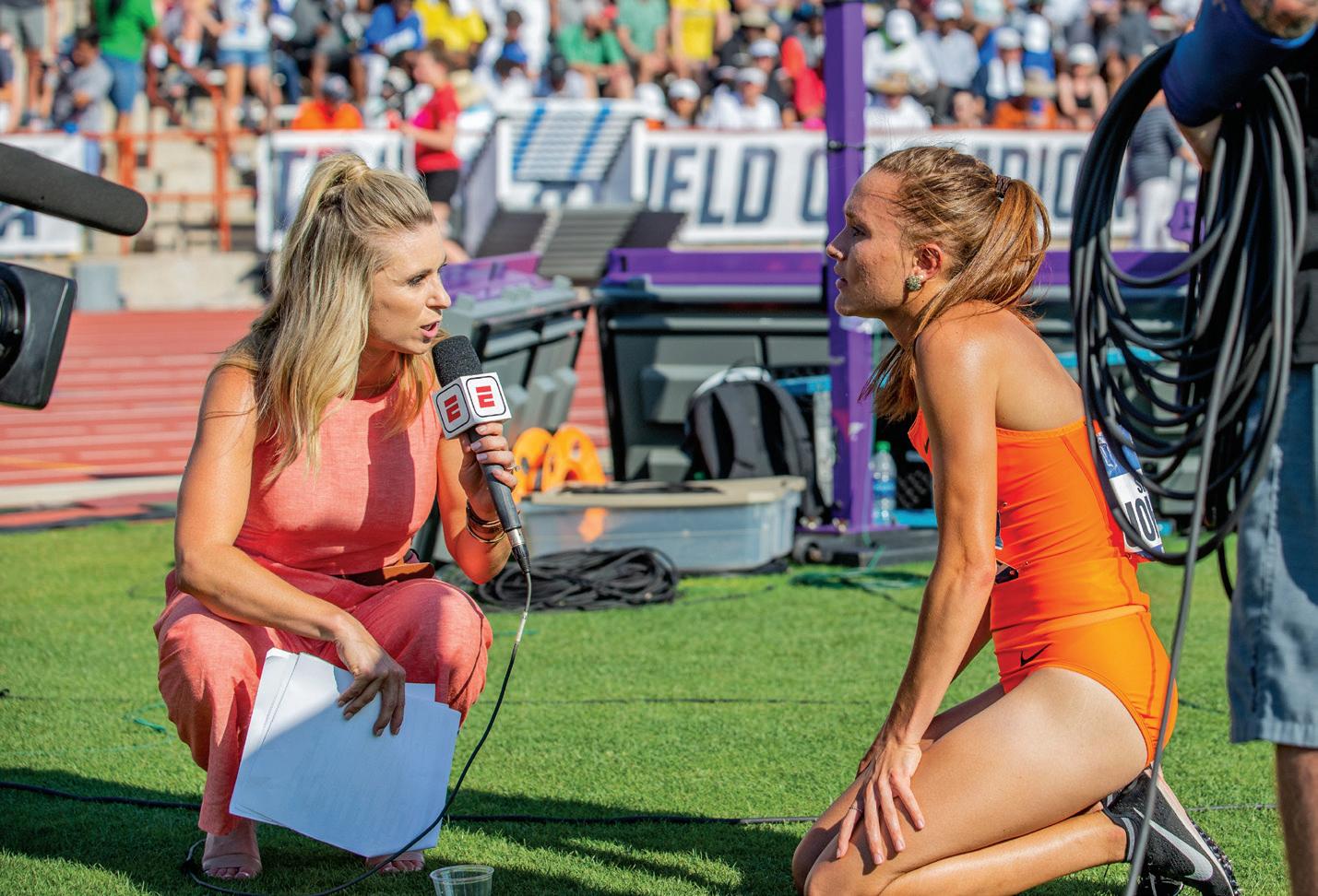
“In the interview, I couldn’t even stand up. I had lost it,” Johnson recalls. “By the end of that race, I was completely depleted. I was exhausted. I was dehydrated. It was 98 degrees that day with a heat index of 103 or 104. We had been warming up in that heat prior to our race, running and doing drills — even just standing out there dripping sweat — becoming more and more exhausted by the minute. After an hour of doing all that, let’s go out and run the fastest you’ve ever run before.”
(And then immediately talk to a worldwide television audience.)
Overton knelt to Johnson’s level and held out the microphone as the telecast came back from commercial break. It was all Johnson could do to put her thrilling — albeit agonizing — victory into words.
Martinez finished in seventh place, earning the OSU senior first-team All-America honors in her final collegiate race. Sughroue secured second-team honors by finishing 11th.
“We might not have a Sinclaire Johnson without Molly or Jenny,” Smith said following the race.
“I was fortunate enough to have two classes I looked up to,” Johnson said. “When I was a freshman, the fifth-year seniors that I really looked up to were Savannah Camacho, Kaela Edwards, Clara Nichols, Anna Boyert and Natalie Baker. That was a very strong class, and I have taken away something from each individual. I think that was special to come in and have so many women who were really good in all different aspects, not only on the track, but off the track. They taught me a lot. Unfortunately, I only got a year with them before they graduated.”
This year’s senior class has also had an impact on Johnson.
21 POSSE
PHOTO BY CLAY BILLMAN
“Then I had (2019 graduates) Molly Sughroue, Abbie Hetherington , Jenny Martinez and Kaylee Dodd,” she said. “So having that class to kind of fill their shoes was also really special. Like Dave said, without those girls, the things I’ve done wouldn’t have been possible. I believe that 100 percent … They came in and raised the bar. I was very fortunate to be able to experience those two classes in just a matter of three years at Oklahoma State.”
The legacy of elite runners continues to grow at Oklahoma State. Johnson joins Piliusina and Edwards as Cowgirl middle distance NCAA champions under Coach Smith.

“Her development came a little bit later in her career than Natalja or Kaela,” Smith says, “but where Sinclaire is right now, she’s obviously among the best that have ever come to Oklahoma State.”
They say records are made to be broken, and Smith believes Johnson’s stellar season has elevated the ceiling for the OSU program.
“Sinclaire has expanded the realm of possibility at Oklahoma State,” he says. “Someone’s going to come along and break those school records, because she changed our collective subconscious, our mentality and our belief system. Sinclaire raised the bar, and future athletes will find a way over it.”

Johnson’s journey from promising recruit to national champion wasn’t without setbacks — and it almost didn’t happen. There were days when she considered giving up running for good.
“My first year was absolutely rough,” Johnson recalls. “My freshman year I came in as a pretty decent runner. I was 2:08 (800m) and 4:57 in the 1,600 so I had been recruited pretty heavily. But I didn’t make the cross country team my freshman year. I struggled a lot.
“We do three-and-a-half-mile tempos every Tuesday. I never finished a tempo workout. I kid you not. I was the No. 1 girl on my high school team all four years, and to come in and I couldn’t even finish a workout … It was just all so new to me and really hard to navigate my first year. I definitely had to be more patient.”
To add injury to insult, Johnson got a stress reaction in her right tibia that winter.
“That held me back a lot,” she said. “I came back for the indoor season and had heartbreak after heartbreak in races. I was running 2:19 in the 800 at one point, which
FALL 2019 22
PHOTOS BY BRUCE WATERFIELD
“Terrible, terrible, terrible races,” she said. “I started not liking running, honestly. I was like, ‘Why am I doing this? I’m dreading going to practice. I’m dreading racing. No one is forcing me to be out here.’ I started to think maybe this isn’t something that I want to do.”
Johnson credits that senior class with keeping her on track, literally and figuratively.

“I think being around those fifthyear seniors helped me so much that year,” she said. “Honestly, if it weren’t for them, I don’t think I would be, one, back at Oklahoma State and two, still running. I would’ve moved back home closer to family and just given it up altogether.”
A small victory in her last race of 2017 also provided a spark.
“At the Big 12 meet I made the 800 meter final because someone got disqualified. I was the last one in and then in the final I beat one person so that was a huge step for me. That was something I really needed — to end the season on a high note,” Johnson said.
“I went home and honestly did not do much training over the summer. I probably ran every day, but I can’t tell you that I ran fast. I was just trying to get my love for running back again.”
By her sophomore cross country season, Johnson says she was finally finishing those dreaded tempo runs.
“I was feeling great,” she said. “I made the cross team. Workouts were going well. Races were going pretty well, although not as good as I wanted them to go. By the end of the season I finished almost dead last at nationals, and I felt like that was a huge step back.
DAVE SMITH, HEAD COACH
“Then over winter break I got injured again. I had the same stress reaction in my tibia, and I think coming back indoors I had to make a real decision. ‘Is this something that you want to continue on doing or not?’ I think I was just so disappointed with the sport.”
Unable to run, Johnson hit the water.
“I cross-trained my butt off that winter,” she said. “I redshirted indoor, and I was swimming in the pool probably two hours a day every day for weeks. I came back and was the fittest I’ve ever been. Fast forward: I ran 4:11 at regionals and qualified for nationals. I didn’t make the final. That was hard, but I knew that I had so much more. I think that just springboarded me into what happened this past season. It was a completely different year than it was last year — that mentality of wanting to be the best runner I can possibly be.”
A confident competitor, Johnson believes it’s her mental toughness that sets her apart.
“I think that a lot of people have physical talent but don’t necessarily have success because they don’t have the mental and emotional capacity that running requires,” she explains. “Dave always tells me that my superpower is my emotional stability. It is true that 90 percent of running is mental.
“There are obviously moments in my career that have been terrible, but I’ve learned to not get so down about those or let that determine who I am as an athlete or as a person. The same goes for the highs in my career because you’re only as good as your last race, and every time you step on the line you’re going to have to prove yourself. It’s definitely important not to get too up and down in this sport.”
“I think her emotional ballast is as good as anybody I’ve ever met,” Smith says. “It’s hard to rock her boat. She doesn’t get too up or too down. And she doesn’t have the anxiety that a lot of runners deal with. So going into a race, she’s carrying less baggage. She’s not carrying the fear of failure or doubt.
“Even during a race, something bad could happen and she doesn’t panic, doesn’t overreact. She stays calm. I think that’s where Sinclaire is better than almost everybody she runs against.”
Johnson will graduate in May with a degree in economics from OSU’s Spears School of Business. In the meantime, she plans to train under Smith leading up to next summer’s Olympic trials. Stillwater has become a second home for Johnson, and her team has become family.

“Oklahoma State was actually my very first recruiting trip so I had no idea what to expect from an official visit,” Johnson said. “I came here and felt like I was at home. I felt like I already had a family here, and I had just met these people. They made me feel like I belonged. I still feel like that about my teammates. They are going to be my brothers and sisters for life.
“The athletic department has been nothing short of amazing in my time here,” she adds. “The amount of opportunities and resources we’ve been given and all the amazing donors that Oklahoma State has, it’s really awesome. I don’t think people from the outside realize how great of a community we do have in Stillwater, and that is very, very important to me.
“The school and this community have given me so much, I honestly want to find a way to give as much as I can back to them. I think for right now, the best way I can give back is by making all of them proud and doing big things and representing the school on the biggest stage.”
“SINCLAIRE HAS EXPANDED THE REALM OF POSSIBILITY AT OKLAHOMA STATE.”
23 POSSE


Bridal Party? Weekend Getaway? Business trip? We’ve got you covered.


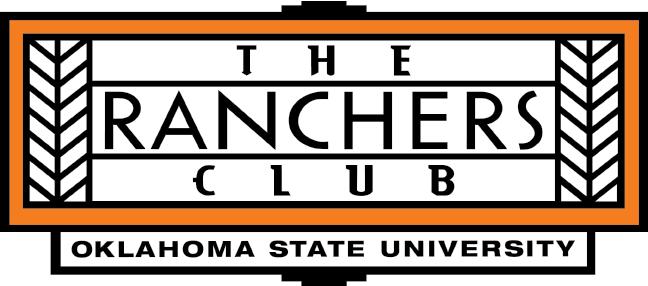


LINDY WATERS III BUILDS ON FAMILY LEGACY AS HE FORMS HIS OWN

Carrying The Name
STORY BY HALLIE HART | PHOTOS BY COURTNEY BAY
FALL 2019 26
Lindy Waters III inhabits two roles.
The Roman numerals at the end of his name are a bridge between the past and the future. They are a reminder of his grandfather, whom he never met, and his father, who is showing him the humility passed through generations of Kiowa citizens. The three identical “I’s” also represent a unique identity, the potential for him to go places his namesakes haven’t been.
Waters, a senior on the Oklahoma State men’s basketball team, said he thought of carrying the name as a weighty responsibility when he was younger.

“Once I got older, it was really realizing that I’m making my own name at the same time,” Waters said. “So it’s like two different legacies being filled, making sure my father and my grandfather’s name lives on the right way as well as my name.”
At 22, he is intertwining those legacies and building them. Waters, from Norman, has played three seasons as a Cowboy guard, but his name is familiar to many beyond his
home state. People across Oklahoma and in other states, from Washington to Arizona to Nebraska, ask for him to work with their children on the basketball court. Fans of other teams tell his dad they support Waters and watch his games because they are proud to see him represent Native Americans as an athlete with Kiowa and Cherokee heritage. His face appears on the broadsheet pages of newspapers and in Cowboy basketball videos peppered throughout Twitter and Facebook feeds, putting him in the spotlight as a leader not only for his team but also for aspiring athletes.
27 POSSE
“It’s been surprising,” Lisa Waters , his mother, said. “It’s not something I could have foretold, that he was gonna be where he’s at today and being such an influence.”
Waters, who was named Indian of the Year at the 2018 American Indian Exposition, hasn’t always planned to do this. He grew up as an introverted, modest kid, largely the same person he is today.
His father, Lindy Jr., remembered someone’s advice that he paraphrased as this: “Don’t talk about yourself. Let other people talk about you, and that’s when you know you’re doing something.”
They have been talking.
In many Native American cultures, Lindy Jr. explained, leaders often aren’t boastful or loud. Waters’ humble personality has made this role-model persona fit him like a perfectly tailored shirt. Realizing he could guide others to where he stood, he embraced it.
Confidence on the Court
Waters started leading the basketball clinics after his sophomore season.
When he and his dad arrived at a high school gymnasium near Anadarko, they couldn’t begin to predict how the experience would go. About 30 children joined them for their Kiowa Tribe basketball clinic, and after that successful day, Waters and his dad decided to continue their new program.
During summer breaks, the duo has led nine basketball clinics for Native American youth — four in 2018 and five this year when Waters had time off from OSU workouts. Some of these sessions split into two based on age range. In the span of each three-hour clinic, kids sharpened their basketball skills, and Waters aspired to build their confidence.
“When I see a picture that someone took of him working with another kid, I can just see that passion that he has to pass on any little improvement to their game so that they can keep taking another step toward success,” Lisa said. “I feel like that’s what speaks to me, speaks to my heart.”
The motive for his mission is rooted in personal experience. Growing up, Waters competed in Native American basketball tournaments in which participants were required to have tribal enrollment cards. Waters noticed some of his opponents and teammates had incredible shooting skills, making basket after basket.
Unlike him, most didn’t advance to Division I teams. In 2018, Waters was one of only 14 Native American players in Division I basketball, according to the NCAA’s Demographics Database.
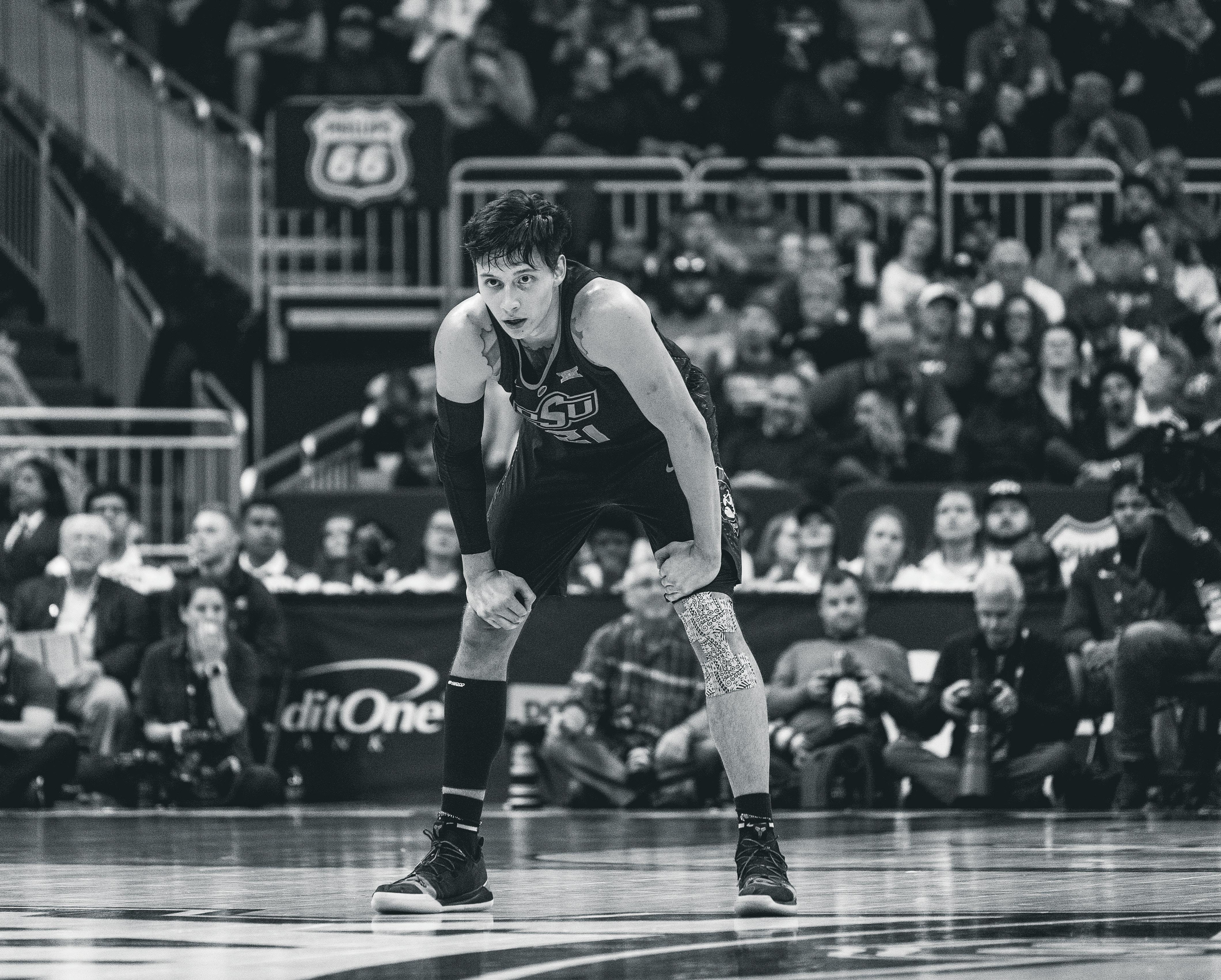
“There’s a lot of kids that can play out there, but they get overlooked,” Waters said. “Because one, they will be too scared to step out from the reservation and step away from their families into a different world. It will be a whole culture shock for them. And two, sometimes they just don’t believe that they can make it.”
Waters has traveled across the region to instill self-determination in young Native athletes, telling them to refuse to let people doubt their abilities while teaching them about the game. This summer, he worked with members of the Kiowa Tribe, Wichita and Affiliated Tribes and the Osage Nation. He and his dad also conducted a clinic open to members of all tribes at Haskell Indian Nations University in Lawrence, Kan.
Typically, Waters and his dad received assistance from only two or three people, who were usually in charge of tasks such as enrolling children and distributing t-shirts and basketballs. At the two Osage clinics, which had the most participants and included nonNative students, they had an extra helper.
FALL 2019 28

— MIKE BOYNTON
29 POSSE
“He’s a kid from this state who wants to leave a legacy of success.”
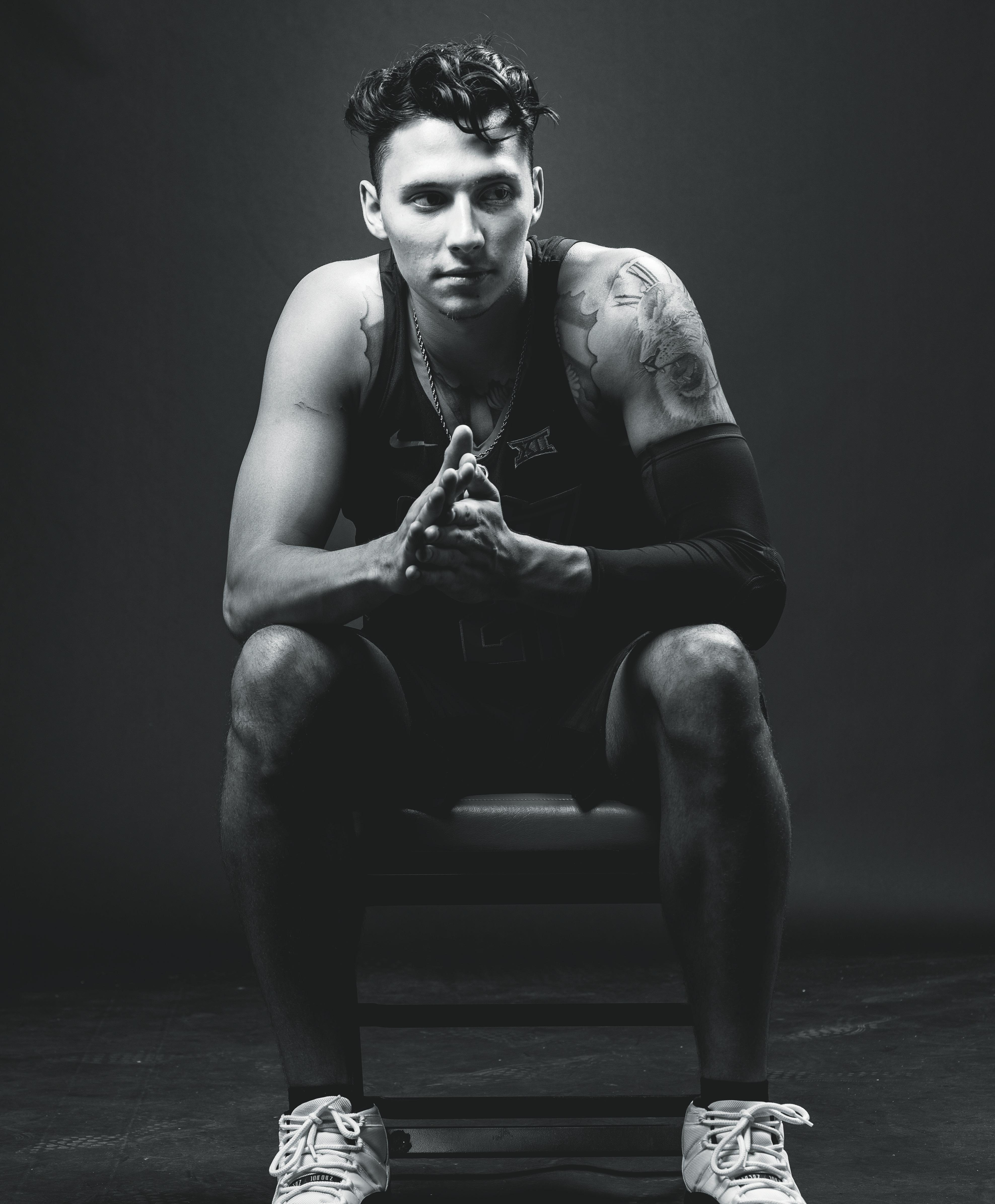
LINDY
—
WATERS JR.
FALL 2019 30
“I wanted, hopefully, Lindy to carry his name and fill his shoes. And he’s done that and more.”
J.K. Hadlock , Waters’ OSU teammate and an Osage Nation citizen, joined them in leading those sessions. Just as the Cowboys did throughout the past season, Hadlock looked to Waters as an example.
“You can’t really tell (the kids) what to do but kind of just show them,” Hadlock said. “And he did a really good job in that. He interacted with them really well, made jokes, made them laugh. It was fun.”
Each kid received a Pistol Pete sticker and could choose another OSU item, tying Waters’ love for his university into the basketball clinics. Waters and his dad worked with athletes ranging from pre-K to 12th grade, and they tailored their teaching styles to individuals.
With eager young children, they used quirky words and phrases to help them remember basketball techniques. With teenagers who were more reluctant to learn, Waters and his dad bluntly asked them whether they wanted to get better at basketball, using an assertive coaching style that incited them to pay attention.
One child, a small boy Waters guessed might have been a sixth grader, concentrated on everything Waters told him and quickly responded with adjustments.
“Kids like that, they give me hope that there’s other kids out there that really want to work for something,” Waters said.
Family Inspiration
Unlike the children who surrounded him with hugs and asked for his autograph, Waters didn’t have a Native American basketball role model.
As a kid, he watched his favorite NBA players, but he couldn’t recall noticing one guy who shared the heritage his parents raised him to embrace. During Waters’ freshman year at OSU, he began considering how he had the potential to change that status.

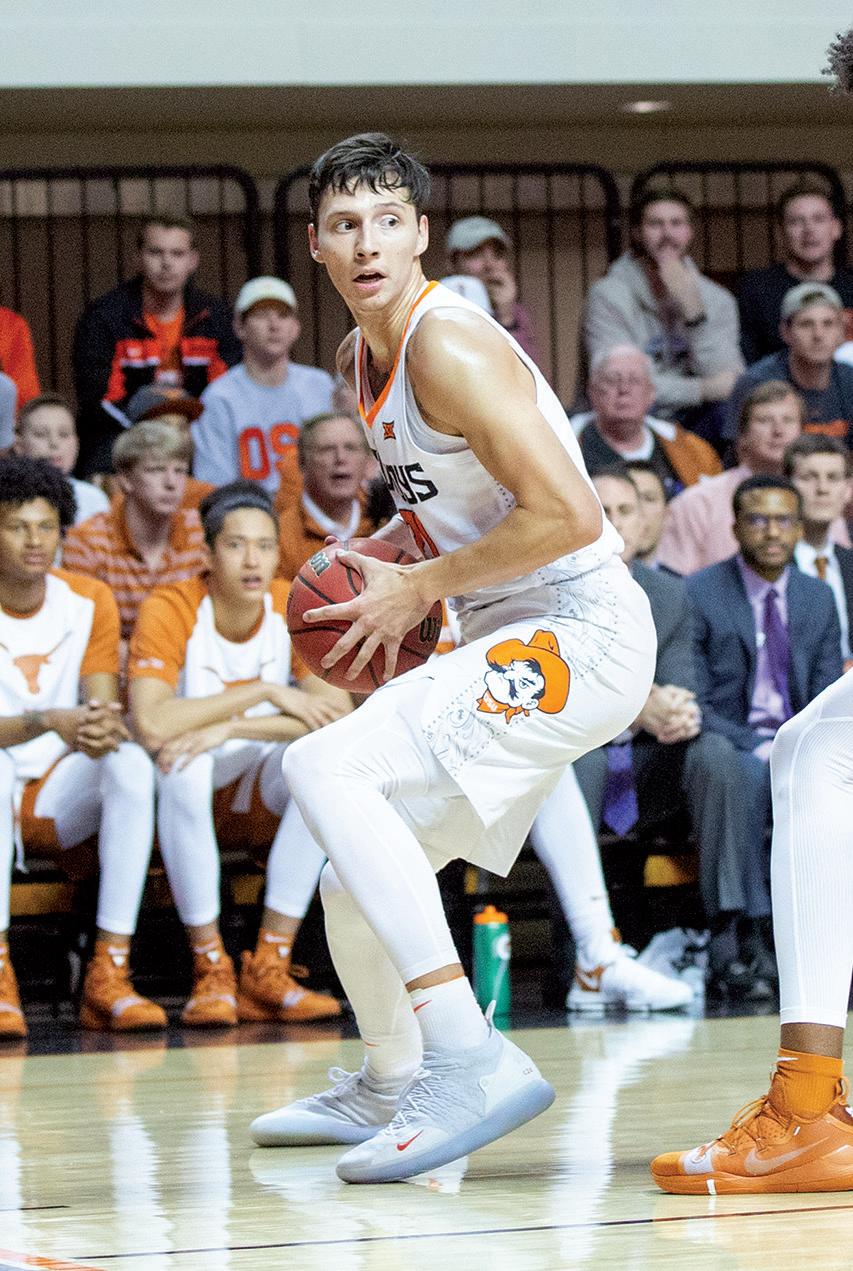
“Someone had asked me a question about being Native American,” Waters said. “And then I really started to think about my position.”
He would have to blaze his own path, but it wasn’t anything new for his family.
Lindy Jr. didn’t choose his son’s name so he could keep his legacy alive. Instead, he wanted to pay homage to his father, Waters’ grandfather, the Rev. Lindy B. Waters Sr.
Although the eldest Lindy died at 51, before his grandson was born, Waters heard stories about him. He learned his grandpa was a talented softball catcher, but made a name for himself in the pulpit.
During the 1960s, Lindy Sr. dedicated himself to serving others as a minister in Dallas. He shared his Christian faith and the altruistic, giving ways of his Kiowa culture. Those who met Lindy Jr. told him how his dad inspired them and gave them a new perspective about the adversity Native American communities faced in society, breaking down the prejudiced beliefs many people had.
“He was a huge servant and was a role model in a way,” Lindy Jr. said. “Helping (people) be successful and get steady jobs and develop families and focus on our culture, our families, our learning system.”
Lindy Jr. kept those unselfish values in the family, and his son has noticed. Waters’ parents have educated their children about their roots, going to Kiowa and Cherokee celebrations to immerse them in Native American culture instead of only telling them about it. Before Waters learned to dribble and shoot, his father became his first coach.
“He’s always put other people first,” Waters said. “He takes care of our family no matter what. He always makes sure I’m OK, my sisters are OK and my mom’s OK before he does anything for himself.”
31 POSSE
PHOTO BY BRUCE WATERFIELD
Only The Beginning
With his father’s guidance, Waters waited to establish the 3-pointer as his signature shot.
“My dad didn’t let me shoot a three until eighth grade,” Waters said.
It’s a striking statement from a guy who, along with Thomas Dziagwa , cemented his role as one of the Cowboys’ “Splash Brothers” during the past season. His 44.8 percentage beyond the arc ranked second in the Big 12 and fourth in the OSU record books. The skill developed from the strategy his dad gave him — and the patience Waters needed for it to work.

Careful to keep his son from developing sloppy form, Lindy Jr. advised a young Waters to master close shots first. Near the hoop, then from midrange, Waters watched basketballs swish through the net. As he improved, his feet gradually edged away from the basket until eventually, he stood beyond the arc.
Waters and his dad used this principle in their basketball clinics. In the first hour of each
“Once they get a little comfortable with that, we always try to put them out of their comfort zones,” Waters said. “We make it a little bit tougher.”
As the challenges progressed, Waters didn’t worry about perfecting his students’ form. Families train kids with a variety of methods, and he was careful not to interfere with what they knew. Instead, they practiced fundamentals to help their games grow.
As word spreads about Waters’ influence, he and his dad are flooded with requests from across the country. People have urged him to expand his clinics to different regions, reaching more aspiring basketball stars.
Although Waters works with children in Oklahoma and Kansas, he hasn’t had time to tour the United States to impart his wisdom. Kids might treat him like an NBA idol, but he is still a college student working toward a sports management degree and conditioning
“He feels a responsibility to this program,” coach Mike Boynton said. “He’s a kid from this state who wants to leave a legacy of success.”
Whether Waters plays professional basketball or pursues a different career, he plans to stay connected to the game through a program that will allow him to impact young athletes nationwide.
He and his dad have decided to start a basketball foundation. They are working out the details, but Lindy Jr. said he would like to make sure it is active by the end of his son’s senior season. It’s the beginning of a legacy that can last long after Waters hangs up his jersey, when he watches the kids he mentored take on leadership roles and fulfill their athletic dreams.
This is the legacy that belongs to his father and grandfather, because it is his, and he has only begun building its framework.
Whether Waters leads his teammates or a group of elementary-aged rookies, his father stops to tell him how proud he is. Through his actions, Waters honors his grandfather each day.
“I wanted, hopefully, Lindy to carry his name and fill his shoes,” Lindy Jr. said. “And he’s done that and more.”
FALL 2019 32

33 POSSE
The Latest Greatest …
They come along from time-to-time at Oklahoma State. Those who rip up golf courses, smash baseballs into the stratosphere, win Heisman Trophies and hit half-court shots.
In regard to wrestling, they just happen to come along a little more often. From the days of Edward Gallagher molding rural Oklahomans to Myron Roderick building relationships with Japanese, Oklahoma State wrestling has built a sport dynasty unrivaled, collegiate or professional, and one that is recognized worldwide.
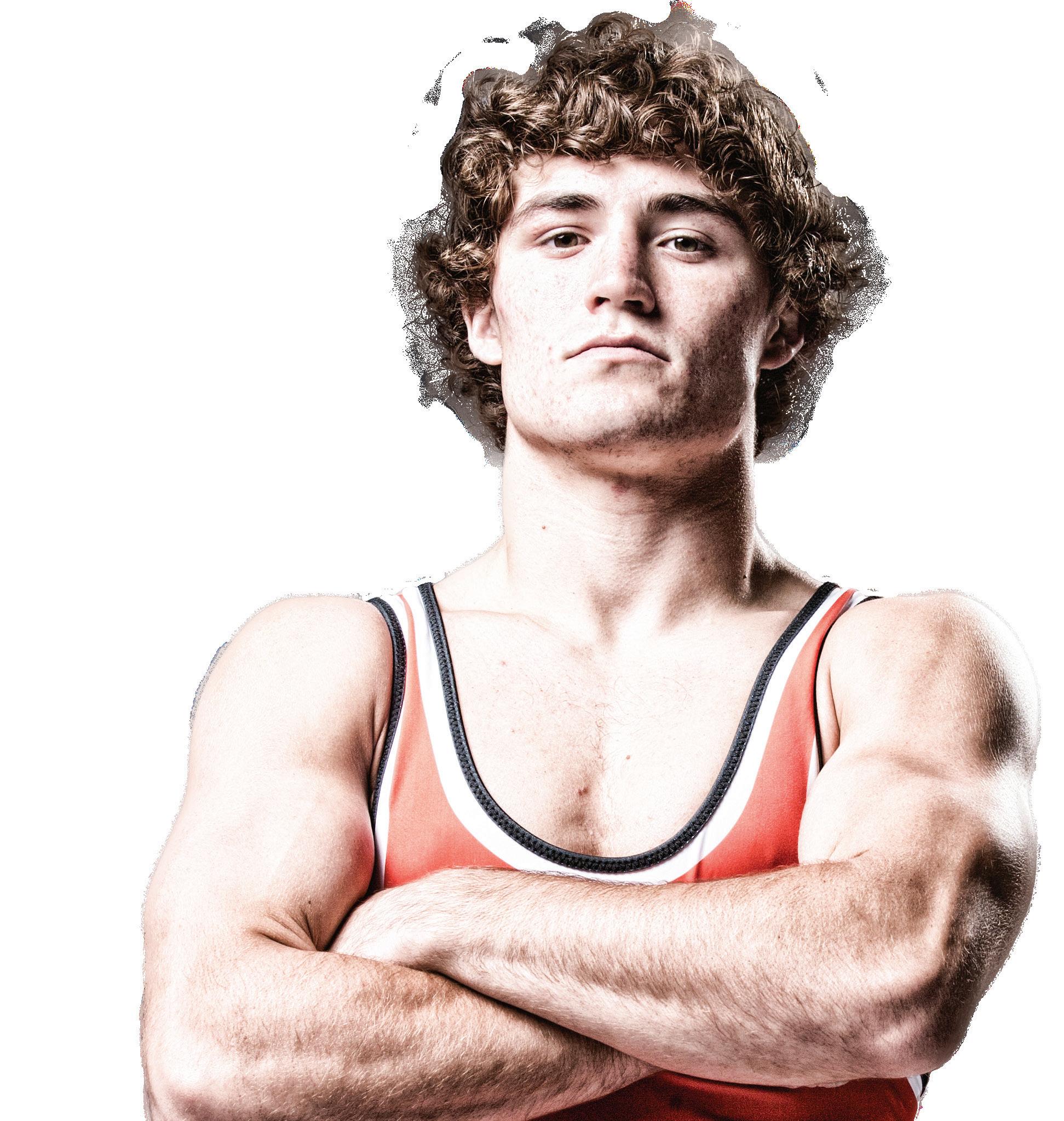
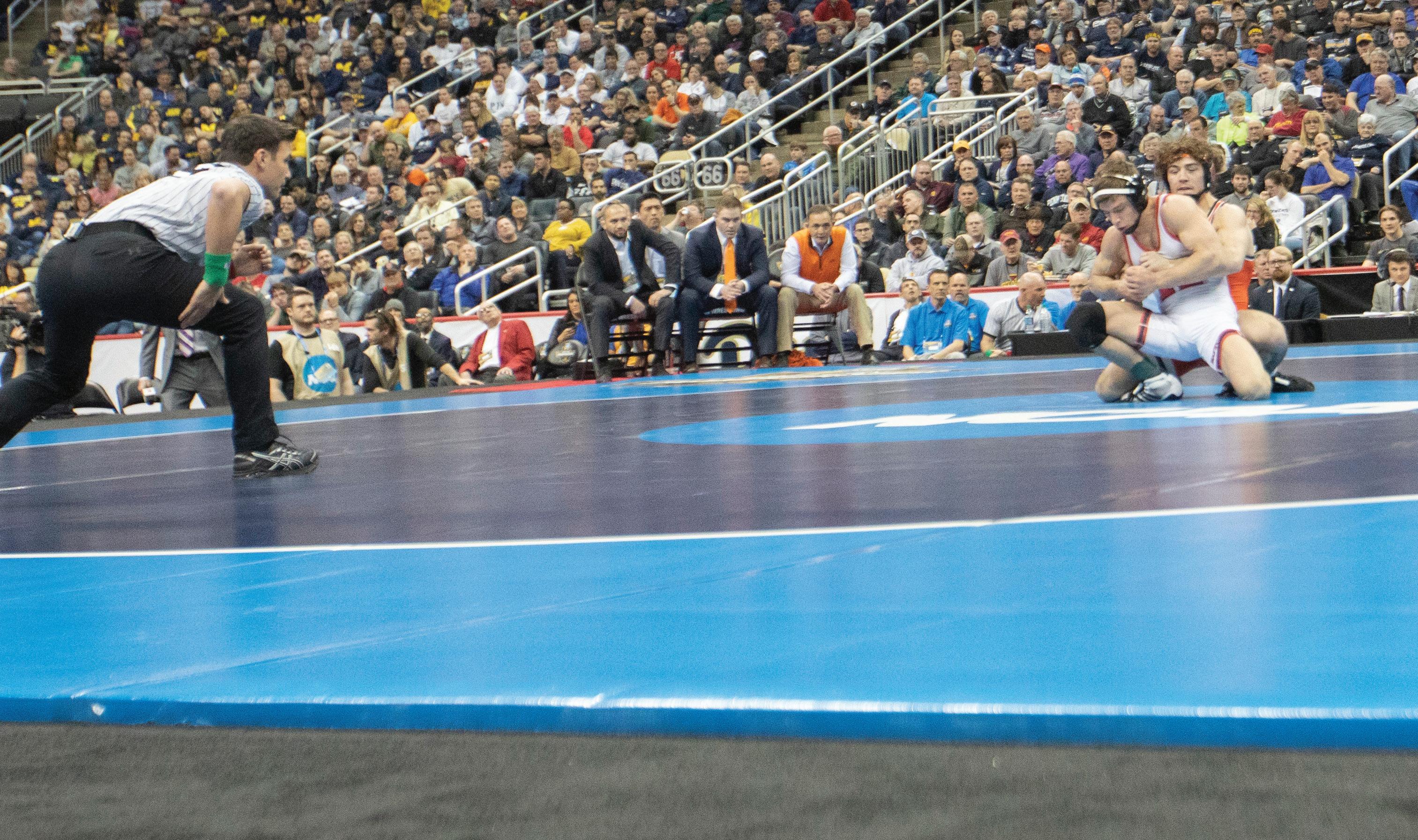
Cowboy mat fans have grown accustomed to NCAA championships, individual and team, and Olympic medals since Bobby Pearce and Jack VanBebber each claimed gold in Los Angeles at the 1932 Summer Games. The bar
has been very high since, and that standard continues 100 years later.
A century’s worth of champions has been built through countless hours of drilling, of a daily, monthly, yearly grind that is hard to put into words for those who have not experienced it. John Smith lived it, winning two Olympic gold medals and four World Championships from 1988-92; as OSU’s head coach, he continues to seek out those individuals of like mind, those who take things very seriously on a wrestling mat.
STORY BY ROGER MOORE | PHOTOS BY BRUCE WATERFIELD
Daton Fix is of like mind. Has been for a long time.
FALL 2019 34


35 POSSE
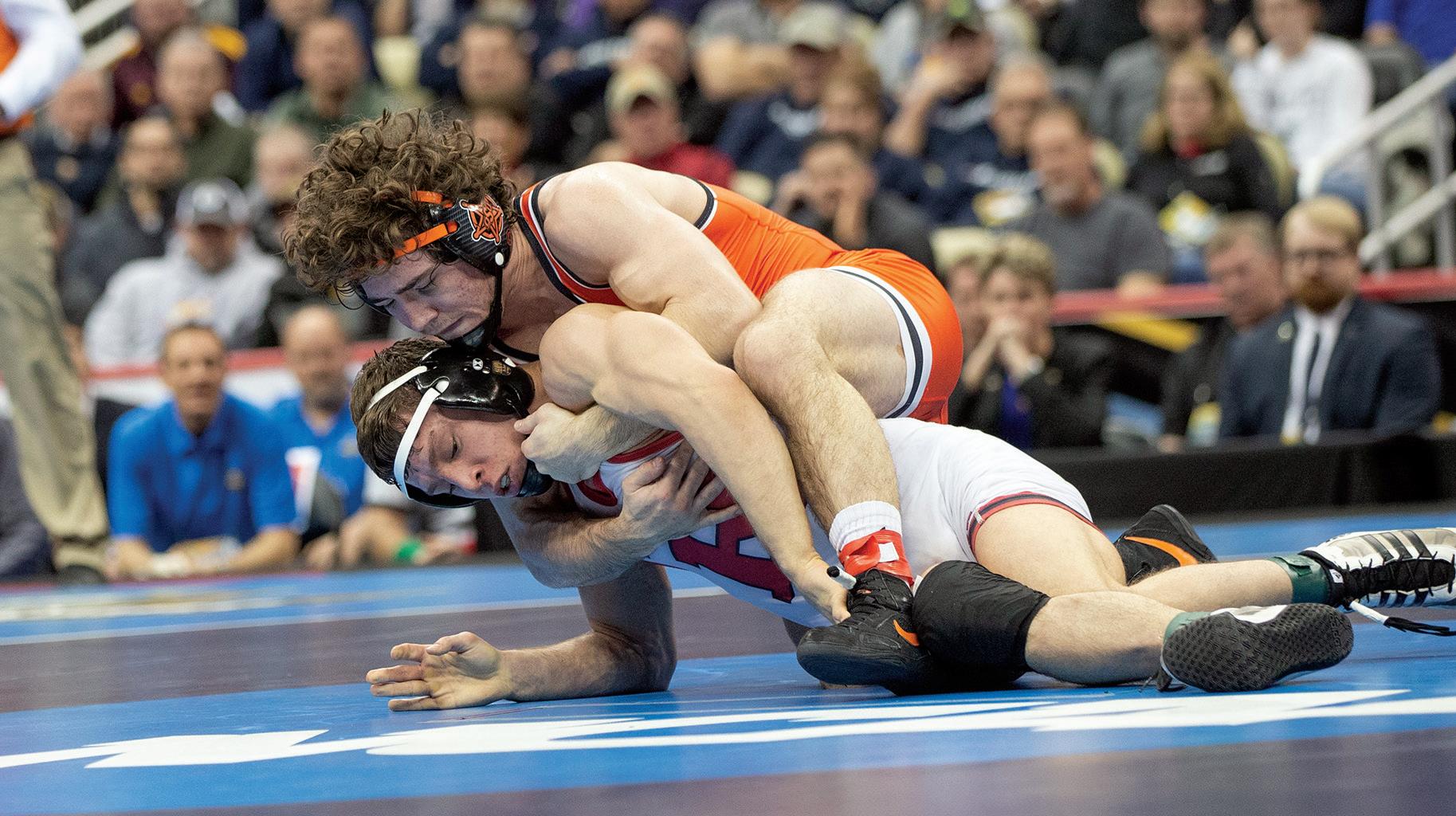

FALL 2019 36
Stacee Karstetter Fix, a long-time school teacher, perhaps received a small hint of things to come when Daton was an infant. A co-worker, possibly a clairvoyant, once stopped her in the hallway and told her that she could tell God was going to use (Daton) to change the world.
“It was really odd at the time,” Stacee said. “I had worked with her at a few other schools; she is a very spiritual person, and there was this strange, serious feeling when she talked about Daton. But I’ve watched Daton throughout this journey, watched him develop as a person, and I have to think, through wrestling, he has a platform to do great things.”
The journey has not been perfect — they never are — but considering it started in a Sand Springs garage and found the NCAA championship finals stage and a spot on the United States World freestyle team in 2019, it’s been rather impressive.
Perhaps he is the reward for two families who have given so much to this unforgiving sport. Their sacrifices, the amount of time and energy put into wrestling, has maybe created a large amount of karma that has its physical form in a special young man. It’s been said that you get wat you give. The Fix and Karstetter clans have given substantial effort.
Daton’s grandfather, Dave Fix of Wray, Colo., wrestled at Northern Colorado and is credited with those first few rides to wrestling practice. It was he who told his son Derek that Daton needed some personal handling, someone who knew the game and could help him develop in a positive way. Derek, a top recruit, signed
with Oklahoma State in 1989, but his career was cut short by injury. After some time away he returned, coaching parttime and working as an NCAA official until the 2008 NCAA Championships in St. Louis.
Alan Karstetter, Stacee’s father, is a member of the National Wrestling Hall of Fame’s Oklahoma Chapter, inducted in 2003 after 24 years as head coach at Charles Page High School in Sand Springs.

“It’s helped having so many (in my family) who have been a part of wrestling because they understand what it takes to be successful,” Daton said. “The sacrifices they have made to help me get here … I wouldn’t be here without them.”
Derek made a lifealtering decision in 2008.
“Daton started a little later than most, and we knew he was going to lose matches because he was behind the other kids,” Derek said. “I told him to forget about wins and losses, but to watch the one who got his hand raised. Already knew he was tough, but instead of letting other people coach my kid I decided I wanted to coach my kid. I started coaching the Sand Springs junior high, and there were a bunch of kids Daton’s age. It started really small in the garage with Adam (a classic wrestling takedown dummy) and a small mat and built from there.”
37 POSSE
“Competing against the world’s best prepared me for Oklahoma State.”
As a high school star at Charles Page, Daton Fix did not lose a match. He won four Oklahoma state titles and compiled a 168-0 record. He was coached by Kelly Smith and Derek, who helped the Sandites, in 2017, win the program’s first state title since 1971.
While dominating Oklahoma opponents, Daton also took his talents worldwide. In 2015, he won a bronze medal at the Cadet World Championships in freestyle; a year later it was bronze at the Junior level. In 2017, in Slovakia, Fix claimed a Junior World title, and in 2018 he added another bronze to his growing résumé.
“Competing against the world’s best prepared me for Oklahoma State,” Daton says. “That’s what I want, to compete against the best whenever I get the opportunity. It’s made for some long summers, a lot of matches and a lot of traveling, but I would not have done it any other way. I’ve always tried to wrestle bigger guys, and that’s helped me when I’m at my natural weight. I also really like freestyle.”
“Daton has always been focused,” Stacee said. “He was obsessed with learning the alphabet, wouldn’t go outside and play until he had it. That’s the way he has been — he’s not going to stop until he reaches his goals. He’s a good student, just driven in everything he does.”
As a collegian, Fix has become one of the nation’s best. A redshirt season in 201718 created plenty of buzz in and around the practice room. And then, as a first-year starter in perhaps the nation’s toughest weight class, with his curly locks and pre-match leap on full display, Fix was fantastic.

Just one regular season loss gave him the No. 1 seed at 133 pounds for the NCAA Championships last March in Pittsburgh. A Saturday night slugfest with Rutgers’ Nick Suriano ended in controversy and a loss that will not soon be forgotten.
“One of my goals, to be a four-time national champion, was taken away from me,” said Daton, who finished 34-2. “But, after a few weeks, I knew I needed to put it behind me and focus on what was coming up because I still have a lot of goals out there.”
“Knowing that there are bigger things out there for Daton helped me sleep at night (after the Suriano loss),” Stacee said. “It was tough for a lot of us. I think Daton took it better than all of us, and that shows where he is right now as a young man.”
“I think it’s obvious that (Daton) is special,” John Smith said. “He’s suffered some disappointment but has bounced back quickly, which is what champions do. The last year has been as tough as any he’s experienced in wrestling, and he’s just going to keep getting better because he loves what he’s doing. One of his goals was taken away, but he got back on the mat, put it behind him and changed his focus to freestyle.
“Daton brings the right attitude to the room every day.”
On another Saturday night just under three months after the head-gear-induced nightmare in Pittsburgh in the national championship match — this time in Lincoln, Neb. — Fix squared off with former Iowa Hawkeye Thomas Gilman for a spot on the United States World Team. Making World teams at 21-years-old does not often happen, and the opponent was a brash and confident man who bested Fix for the 2018 Team USA spot.
Eighteen minutes of physical and violent hand-fighting mixed with a Houdini-like defensive display by the Cowboy sophomoreto-be produced Oklahoma State’s first World team member since Coleman Scott in 2012. Fix won the best-of-three series in three highlightreel bouts; it took some of the sting off the loss in Pittsburgh and qualified him for the 2019 World Championships in Kazakhstan. The 2020 Olympics are set for Tokyo, Japan, the home to one of OSU’s all-time greats, Yojiro Uetake, who came to Stillwater thanks to the efforts of Roderick a half century ago.
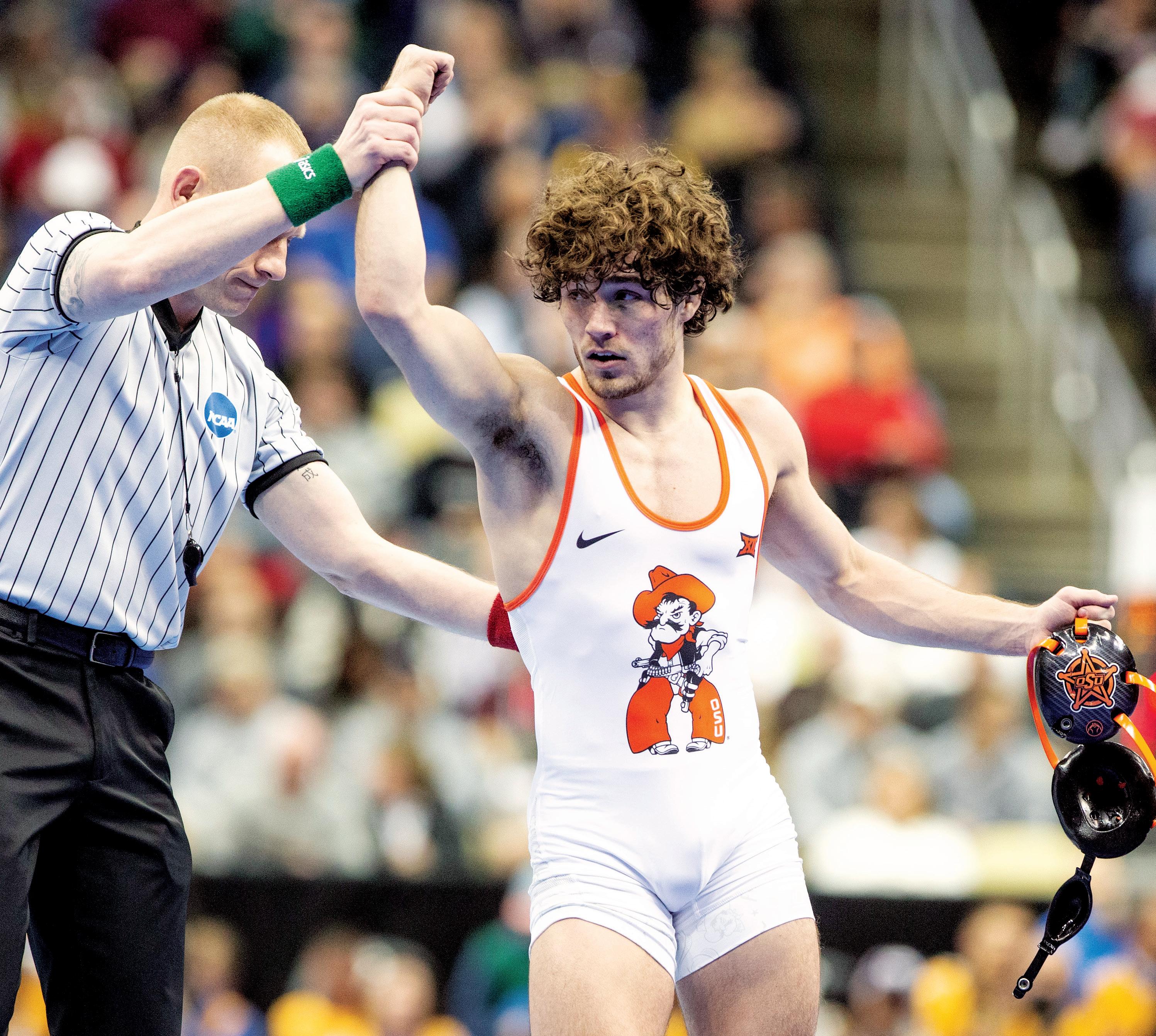
FALL 2019 38

39 POSSE
PHOTOS BY
“It was a battle. I knew it was going to be against a guy like Gilman because he is never going to quit,” Daton said. “I love those type of matches, especially when something like that is on the line. To make the World team, it’s the first step in making the Olympics next year.”


Chris Perry won two national titles for Oklahoma State, comes from a wrestling-obsessed family and has watched and worked with Daton from the beginning. Like Perry rolling around with Tyrone Lewis, Daniel Cormier, Jamil Kelly, and Teague Moore, Fix rolled around with Perry as a youngster. One might think that someone with this list of credentials in a family with wrestling in its fabric would have started stepping on the mat just out of diapers. But it wasn’t until the fifth grade that Daton got serious about the sport.
“You could just tell that he was naturally gifted, really put together,” said Perry, who was in Fix’s corner in Lincoln. “He was more like a gymnast and hadn’t really dug into wrestling yet. You could tell, that if he got serious, he was going to be special.

“To make the World team, it’s the first step in making the Olympics next year.”
FALL 2019 40
EMILY LINGENFELTER
“What stuck out to me was that he was having fun. Sometimes it’s do or die with the kids and the parents, and Daton enjoyed the sport, still does.”
Bouncing back from losses, although rare in regard to Fix, has also caught Perry’s attention.
“I think what’s really surprised me is the way he bounces back from adversity. I think that is why he’s where he’s at, not necessarily the talent, but to come back the way he has as a 21-year-old is pretty special. The last yearand-a-half he hasn’t come in and said that ‘I need a break, to get away from things, I need to regroup.’ He’s like, ‘What’s next?’ You just don’t see that very often.”
Fix certainly looked up to John Smith, Perry, Alex Dieringer and other former Cowboys before arriving in Stillwater. Another one of those idols, mentors and sports heroes for Fix is Jordan Burroughs, an Olympic and world champion who earned another U.S. Team spot in Lincoln. At 31, the former Cornhusker, in wrestling terms, is closer to the end than the beginning of his career.


“We talked about being on the same team, representing the U.S.,” said Fix, who rolled around with Burroughs a time or two at various camps and meetings. “He kind of joked about getting old and that I had better hurry up and make a team. Being around those guys, learning from them, watching them, shows what it takes to be the best.”
A quick search of YouTube and one can find video of Fix not just learning from the likes of Burroughs, but also sharing some of his technique with the world’s best. Birds of a feather flock together it seems.
“Daton wants to be the best of all-time,” Derek said. “That’s the type of goals he’s set for himself. So I think the loss to Suriano did not set him back like it might have for some others. There have been wrestlers who disappeared after tough losses like that, dropped off the grid for a while. Daton has bigger goals than NCAA championships so I think it helped him
recover quickly. We’ve never focused on wins and losses but on the bigger picture. He wants to win multiple Worlds, Olympic gold medals.”
“When I first started I asked my dad what was the best I could do in wrestling, and he told me it was to win a gold medal in the Olympics,” said Daton before one of his regimented “offseason” workouts in July. “So I said that is what I wanted to do.”
With three years of college eligibility remaining and already a trip to the NCAA finals plus a spot on the U.S. World Team, it’s safe to say Daton Fix is off to a pretty good start.
41 POSSE
Higher education is more than merely enrolling in classes at OSU — it’s a journey.


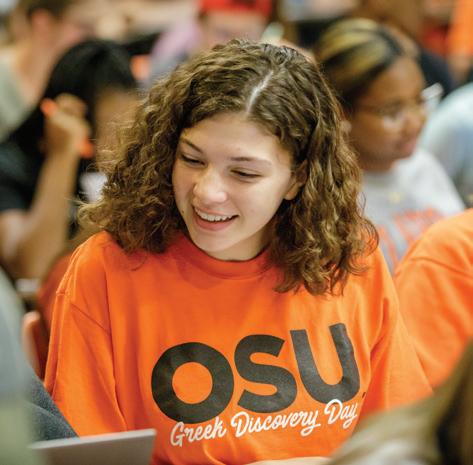
The $ 375 million Brighter Orange, Brighter Future campaign ensures no student at Oklahoma State University is alone in their pursuit of higher education by raising funds for need-based and meritbased scholarships, internship and study abroad opportunities, and programs that focus on overall student support.
At OSU, we dream as big as the sky, and we want our students to stretch their horizons in meaningful ways.
Before a student steps foot on campus, your generosity illuminates the way with the brightest of orange!
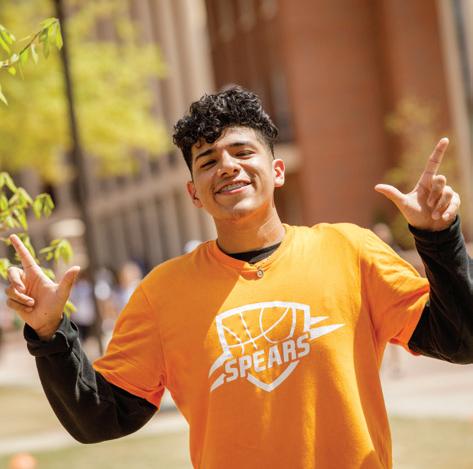
The Cowboy family is always there to help students stay on track, get back on course or navigate a new path to success.
No matter where you decide to make an impact, your gift ensures every student can feel the power — and hope — of having the Cowboy family behind them.
Visit brighter-orange.com to learn more about how you can make a difference.


gray matters
 STORY BY RYAN CAMERON | PHOTOS BY COURTNEY BAY
STORY BY RYAN CAMERON | PHOTOS BY COURTNEY BAY
FALL 2019 44
Forty-four seasons. 1,081 victories. Nine state championships.
Those hall of fame numbers would be unattainable without a few talented athletes along the way. And of all the gifted pupils
Skip Townsend coached on his way to reaching those marks, only one stands clear of Oklahoma State women’s basketball player Vivian Gray.
Right now, she is No. 2, and let me tell you who the girl is that is No. 1. She was not too shabby either. Her name is Shereka Wright . She was a prolific scorer and an awesome player,” Townsend said.
Wright was the consensus national high school player of the year and an All-American at Purdue before making her way to the WNBA and now the coaching ranks. With Wright having hung up her high tops, ample opportunity exists for Gray to close the gap on Townsend’s top spot having only reached the halfway point of her collegiate career.
“I have coached some All-Americans, and Vivian is ahead of the rest of them by far,” Townsend said.
What puts Gray in such elite company? The rare combination of ability, work ethic and basketball IQ.
“What I love about Vivian is her dedication, commitment and love for the game. That is why she works at it so hard. You can push her as far as you want to because she wants to be as good as she can be,” Townsend said. “She was fun to coach because she is coachable. She listens to what you say. She wants to be coached, and she wants to be a better player.”
“She is a coach’s dream.”
Gray had a hand in a third of Townsend’s championship total, helping Argyle (Texas) High School to a three-year mark of 108-8 and three consecutive titles after a runner-up finish her freshman season.
After cutting down the nets on championship Saturday, Townsend would give his squad the following Monday off, and each time Gray could be found in the gym playing with the boys’ team.
“She loves to play basketball. She is going to give it everything she has, and she has a lot to give. She has earned everything she has and earned it because she spent the time developing it,” Townsend said.
Both outstanding athletes in their own rights, Brandon and Lisa Gray excelled as soccer players, but steered their girls away from the pitch and toward the hardwood, with Gray competing on a team for the first time in fourth grade.
The decision would pay dividends as Gray’s prep career progressed. The list of accolades grew and so too did Gray’s stock. Ranking among the nation’s top 15 prospects in her class, she would go on to be named the Texas Class 4A Player of the Year twice, finish her career with 2,893 points and receive an invitation to attend the USA Basketball team trials.
It was the beginning of Argyle’s championship run when Gray landed on the radar of college coaches.
45 POSSE
The 6-foot-1 forward’s coming out party occurred during her sophomore year at the state tournament in San Antonio. After pouring in 36 points and grabbing 13 rebounds in the Lady Eagles’ semifinal victory, Texas delivered the first of countless scholarship offers to come her way.
Until that point, college basketball wasn’t on the radar. Shortly thereafter, Gray could name her destination with coaches clamoring for her services.
“I really didn’t even think about college until my sophomore year when I got my first offer. Throughout the whole recruiting process it didn’t even seem real that I would go to college,” Gray said.
While earning the distinction of being a five-star recruit, Gray did not necessarily enjoy all that accompanied it.
“It was overwhelming. I wasn’t a huge fan of the recruiting process. I didn’t really like it, and I didn’t take a lot of phone calls. I really didn’t even look outside the Big 12 and Fort Lewis,” Gray said.
As the time to make a decision drew near, the list was whittled to two — Fort Lewis College and Oklahoma State.
With a who’s who of suitors in pursuit, Gray made a decision based on the No. 1 priority in her life — family. With that thought, she generated national news by going against the grain and joining her older sister, Olivia, at FLC, a Division II program in Durango, Colo.
“Family is really, really important to me, and it always has been,” Gray said. “We were raised really close, and Olivia is my best friend. We have always been close. It is really important for me to have her around. We live together, and we aren’t going to be able to live together forever so it is just really cool to be able to be with her as long as possible.”
Townsend says anybody who knows Gray and has spent any time around her knew why she made the decision and did not question it.
“Basketball is very, very important to Vivian, but not as important as family. That is the most important thing to them,” Townsend said. “They are a very tight family. They live for each other, and that is the most important thing for her. The decision she made coming out of high school was what she thought was the best decision for her family.”
While opting to pass on Division I basketball left some scratching their heads, it ultimately set Gray on the path to her success as a Cowgirl.
“It was pretty difficult with everyone at school giving me their opinion,” Gray said. “A lot of family outside of my immediate family wanted me to go to a Division I school, and it was kind of difficult going against everything they said.
“I made the right choice. It helped me mature and then come here and do what I can.”
Getting to take the floor once again with her sister, Gray thrived during her freshman campaign for the Skyhawks. After leading the Rocky Mountain Athletic Conference in scoring with her 18.5 points per outing, she was named the league’s freshman of the year and a first-team all-conference pick.
However, not long after that decorated rookie season, a turn of events would make her first season her last in the Centennial State.
FLC would announce more than $4 million in operational cuts, including reduced operating funds for multiple budgets, general and athletic scholarships, as well as travel and tutoring. It created the avenue for Gray to make her way to Stillwater after all.
When Skyhawk head coach Jason Flores addressed the situation with the Grays, he presented two options: stay or go. With their opportunities constricted at FLC, and little desire to navigate the recruiting process again, the exploratory phase was brief, lasting two weeks and involving just one school.
The manner in which OSU head coach Jim Littell handled her recruitment, including her initial college choice, resonated with Gray when it came time to choose a new destination.
“The coaching staff was very welcoming and the best to deal with throughout the recruiting process,” Gray said. “I was one of those kids who didn’t want to talk on the phone every day or very long. They respected that, and I really liked that.
“OSU was my second option initially so when I realized I needed to leave Fort Lewis, it was an easy decision. I didn’t visit anywhere, and I only contacted OSU.”
Not only did the staff leave a favorable impression on Gray, there was a comfort and familiarity that emanated from the campus and the town.
“I like Stillwater because it is a big town that feels small, and I like the small-town feel. The people here are very similar to home,” Gray said. “That was important. It was my favorite out of all of the schools I visited.”
The fondness for Stillwater can be traced back to the sisters’ upbringing. Pay a visit to the family farm in Ponder, Texas, and you are likely to spot any or all of the family’s dogs, pigs, longhorns, horses, chickens, ducks or cats. Throw in the fact both Olivia and Vivian spent a portion of their time away from basketball showing some of the approximately 120 goats roaming the property, and it becomes clear Payne County was a logical fit.
She is very talented, but I think what makes her special is her makeup, work ethic and how she sticks to the process on a daily basis.
FALL 2019 46
—JIM LITTELL
Despite the disappointment of not landing Gray in his first attempt, Littell was mindful to not burn any bridges in the process. When the unexpected phone call came from Brandon Gray, Littell had the desired answer. Both Vivian and Olivia would be welcomed with open arms.
“It is a difficult decision for a studentathlete to make and one of the most important decisions of their life. I have always tried to be respectful of that, and Vivian made a decision based on family. Any decision that is based on family, I am a guy that can understand that,” Littell said.
The final hurdle was cleared when the NCAA granted a waiver for immediate eligibility due to the circumstances in Colorado, clearing the way for the Grays to take the floor for the 2018-19 season.
A single-digit scoring outing in her first road game as a Cowgirl would be Gray’s last as she would go on to log 25 consecutive doubledigit performances and finish as the Big 12’s second-leading scorer (20 points per game), a first-team all-conference player and as the league’s newcomer of the year. The ease of her transition and magnitude of her success impressed her veteran head coach, who has billed Gray as one of the best intermediate jump shooters in the country.
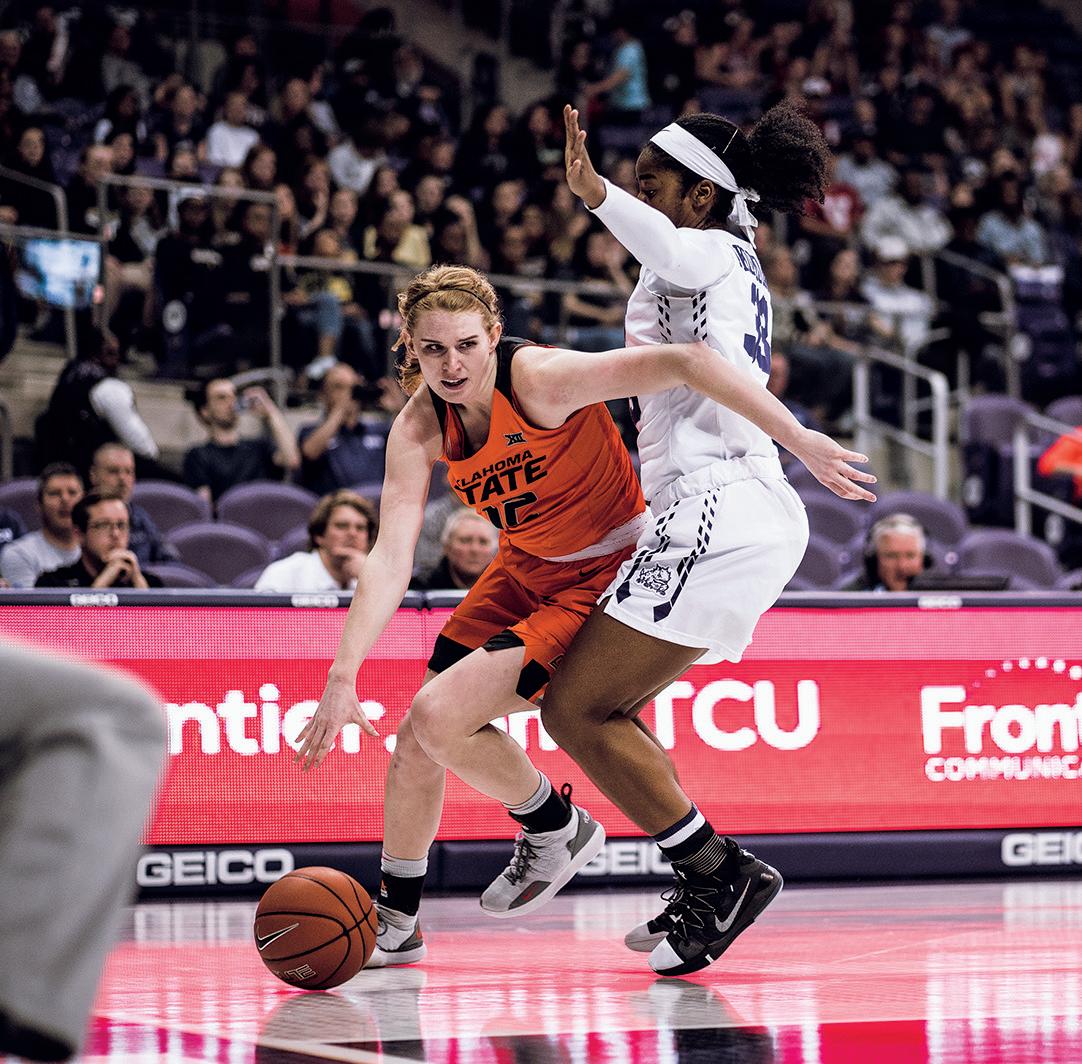

“Early in the year, she was trying to be perfect every time down, and that is not the nature of the game. We have talked about that, and she has continued to grow and get better in that area,” Littell said. “We knew she was a great player and was going to make her mark on our program and in this league, but I was still a little surprised.”

47 POSSE
PHOTOS ABOVE/BELOW BY BRUCE WATERFIELD
“That is pretty big jump up from DII to one of the best conferences in the country.”
Gray’s nearly seamless transition to the Division I level can be attributed to more than just ability. Work ethic travels, and the same mindset applied in Argyle and Durango led to one of the most productive seasons ever by a Cowgirl.
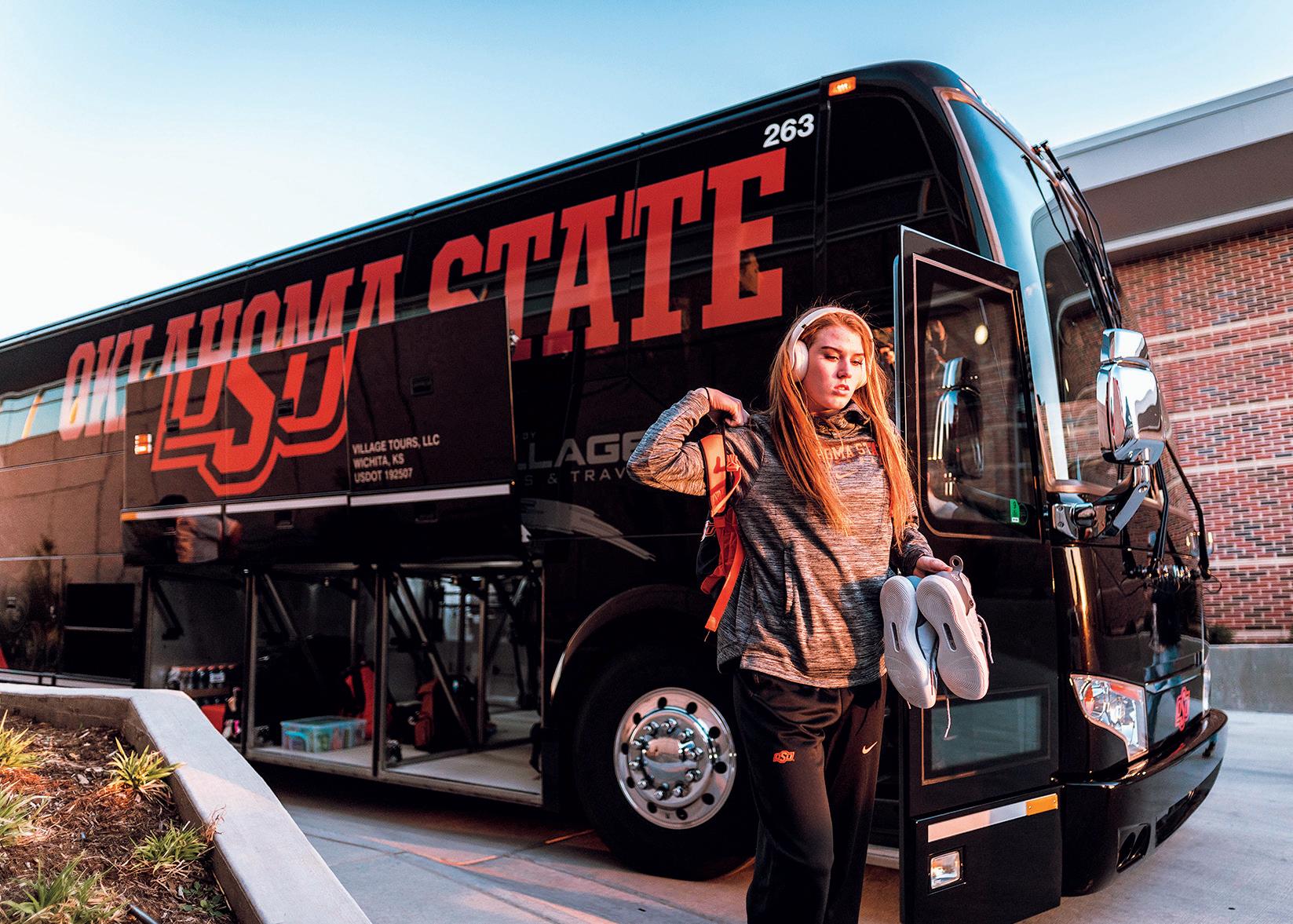
“For you to be a great player like Vivian, there has to be a consistency in your game and your approach. She is prepared not only for games, but she is prepared on a daily basis,” Littell said. “She is very talented, but I think what makes her special is her makeup, work ethic and how she sticks to the process on a daily basis. Her teammates respect her because she works harder than anyone.
“It is no accident that she is as successful as she is.”
Gray was selected as an honorable mention All-American and invited to attend the USA Basketball trials once again after becoming just the third sophomore in school history to score 600 points and average 20 points per contest. When the competition elevated, so too did Gray’s game, with her scoring average rising to 21.6 points per game against Big 12 opponents.
“When the game was on the line or we played somebody elite she always came up big,” Littell said.
A supremely gifted two-way player, Gray’s offensive prowess often overshadows her effort at the defensive end, which included a school record number of blocked shots by a wing.
“Look at Vivian’s stats at Oklahoma State, and she is one of the best players in the country, and she was the best defensive player on her team. She didn’t have to play defense at all to play one minute for us. We knew she was going to get 25, but she never took defense for granted,” Townsend said.
“I always had her on the best player, and she didn’t foul out. That is what I loved about Vivian is that she is unselfish and didn’t mind playing both sides of the ball.”
Ask Gray, and she credits her teammates with helping her acclimate quickly.
“I fit in very well with the team here, and I don’t think it would have been like that at other places,” Gray said. “It wasn’t that difficult coming from Fort Lewis to here because the team does get along so well and we are all friends.
“I don’t know that I was expecting that at a DI program.”
For Gray, competing on college basketball’s biggest stages suits her perfectly, and choosing to become a Cowgirl has eliminated the possibility of a what-if in the future.

“I like to have fun with the things I do and enjoy life. That is why I like playing in the games here. I think it is a cool experience playing in the big gyms with the big crowds and the atmosphere,” Gray said.
“It is fun to see how I size up, and I feel like I won’t have any regrets not knowing if I could play at this level.”
Many may have questioned the path Gray has chosen, but every stop along the way has been beneficial as she continues to blossom into one of the premier players in the country.
FALL 2019 48
“It has been different, but it has been really fun. I have met a lot of cool people and have gotten to experience basketball in different ways,” Gray said.
“At Fort Lewis, we played in smaller gyms and the competition wasn’t as fierce and the crowds weren’t as big. Here the Big 12 atmosphere is really fun to play in, and I am having a lot of fun with it. I really enjoyed playing at Fort Lewis. It was more like Argyle, but I have really enjoyed both of them.”
Gray begins her junior season as the centerpiece of an OSU team looking to rectify a disappointing 2018-19 campaign.

“It is pretty easy to build around somebody that is that talented, but they have to have a great work ethic and be a great teammate. You have to go above and beyond and do some things that other people don’t want to do. Vivian is the epitome of that,” Littell said.
“When you have the respect of your teammates, they will listen.”
Like Townsend, Littell has seen his fair share of talent throughout a storied coaching career and already categorizes Gray with elite company.
“I have put a lot of thought into it, and the two best practice players I have ever coached are Tiffany Bias and Vivian Gray.”
If you think Gray will sit back and bask in past achievement, think again. It simply is not woven into her fabric, and Littell has already seen her elevate her approach.
“The sky is the limit for her. She got all of those accolades a year ago, and a lot of people would get those awards and take a step back,” Littell said. “There was no change in Vivian and her approach to practice when we started working out again in the spring.
“There was another gear to her game. She is hungry.”
Sounds like somebody with eyes on overtaking the top spot on Coach Townsend’s list.
You have to go above and beyond and do some things that other people don’t want to do. Vivian is the epitome of that.
—JIM LITTELL
OLIVIA GRAY
49 POSSE
VIVIAN GRAY
AND A LEADER A TEAMMATE
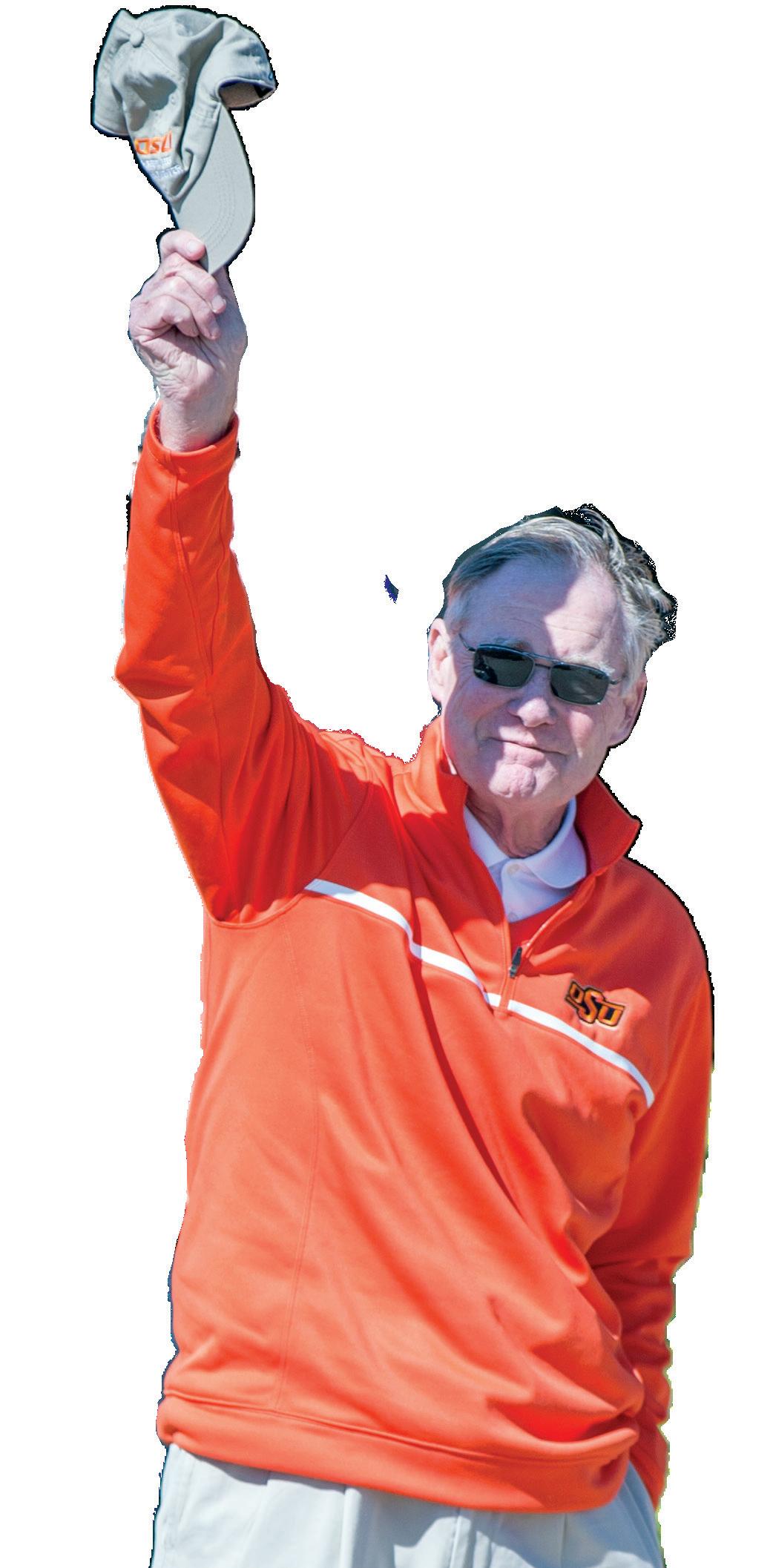
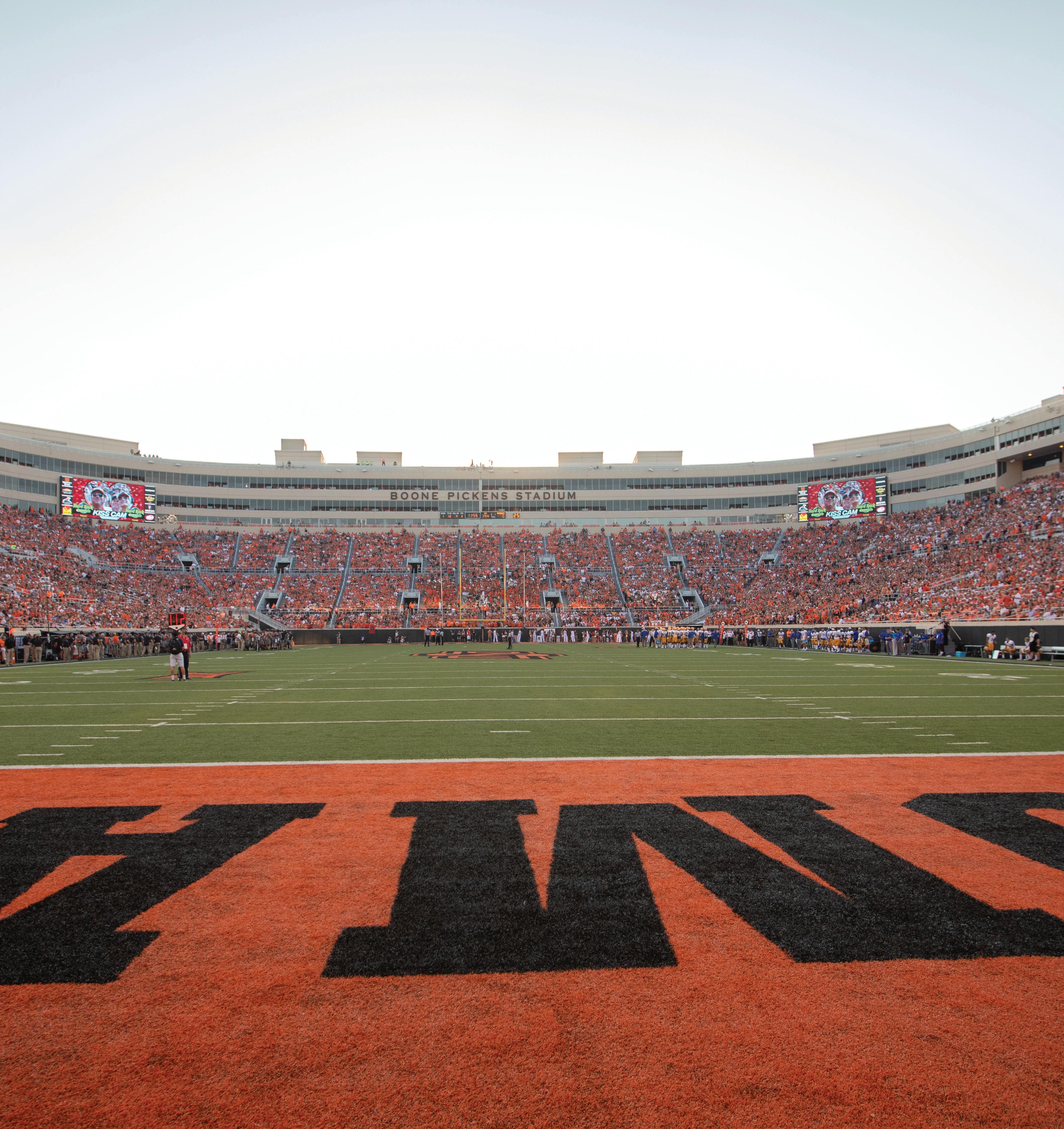 STORY
STORY
FALL 2019 50
BY JOHN HELSLEY
And it wasn’t an Oklahoma State communications intern at the controls, as often happens with busy executives. It was Hargis himself, pushing out a personal message to two dynamic former Cowboy golfers who helped shine a bright light on the university during their storied careers.
In character, too, for Hargis.
“I’m a sports fan,” Hargis said.
Oh, Hargis is a sports fan. And more. Much more.

Oklahoma State’s president, in his 12th year of a bold and historic reshaping of the university’s brand and landscape, happily places his finger on the pulse of OSU athletics. And his love of game doesn’t end there, as Hargis engages beyond campus, serving leadership roles on the NCAA Board of Governors, the NCAA Division I Board of Directors and the NCAA Division I Finance Committee. And that’s after previous stints as the chairman of the Big 12 and working on the BCS playoff committee.
“In some ways, it’s kind of hard to explain what the emotional attachment is to athletics,” Hargis said. “But I think athletics done right embodies all of the values and characteristics that we find admirable in people. You compete hard. You’re brave. You’re prepared. All of those things. “And the qualities that make you a successful athlete, make you a successful person.”

Burns Hargis took to Twitter over the summer, wishing Viktor Hovland and Matthew Wolff luck at the outset of their professional golf careers.
51 POSSE
HOME GROWN, WITH A VISION
“It’s amazing that Burns is only the second alum who’s been our president,” said Larry Reece, the famed “Cowboy voice” and OSU’s senior associate athletic director for development. “Especially when you look at athletics and all of the success we’ve had with our own leading programs.”
Indeed, OSU sports teams have thrived under alum coaches. Mike Gundy, John Smith, Josh Holliday, Alan Bratton. Athletic director Mike Holder is a former Cowboy golfer and golf coach.
Yet before Hargis, only one other OSU president — Oliver S. Willham from 19521966 — graduated from the school, and it was Oklahoma A&M at the time.
Willham made his mark, directing the move from A&M to OSU, seeing the OSU Foundation created and enjoying a near doubling of enrollment and the rise of 19 new buildings during his term.
Like Willham, Hargis’ impact at his alma mater is impressive. The accounting grad has guided OSU to record enrollment and
fundraising, overseen a construction boom that has transformed the campus both academically and athletically, and directed a general beautification across campus.
“So I love the fact,” Reece said, “that I get to introduce an OSU alum as the leader of the OSU system: ‘President Burns Hargis and the First Cowgirl, Ann Hargis.’
“It doesn’t get any better than that.”
Even before assuming the presidency in March of 2008, Hargis was impacting OSU athletics. Then serving on the OSU Board of Regents, Hargis accompanied Holder to Dallas for an early pitch to Boone Pickens, seeking life for the school’s fledgling stadium project.

At the time, OSU’s stadium was an eyesore and a recruiting liability, to the extent it placed a limited ceiling on success for the program. And fundraising efforts were stalling.
Today, the facility — Boone Pickens Stadium — is a college football palace, with Hargis and Holder, and eventually others, playing a role in prompting Pickens’ massive giving.
“Obviously, Mike Holder gets an enormous amount of credit for this, but Boone’s the guy who really made it take off,” Hargis said. “Boone was really worried in the early going, that if he gave these massive gifts, it would discourage others from getting involved in giving.
“Our counterargument was, ‘No, you’ll inspire people, because they’ll see this is really going to happen. Everyone likes a winner. And this project is going to be a winner.’ And fortunately, that’s what happened.”
Soccer and tennis are enjoying muchneeded new facilities, and in the spring Josh Holliday’s baseball squad will open O’Brate Stadium, the latest premium sports facility on campus.
OSU has upgraded across the board, and done it faster than anyone outside the university could have dreamed.
“I’m glad I’ve been able to be a part of this,” Hargis said. “I became a regent in 2001, so I’ve been privileged to be at the table all these years. I’m not taking credit, I’ve just been able to be there and watch it all happen. And it’s been a meteoric rise in almost every respect.
“We’ve still got some things to do on the academic side, and some things to do on the athletic side. And you’ve got to maintain these facilities. That’s the other aspect. The day you finish building them is the day they start deteriorating. So you’ve got to constantly have the budget to keep these things state of the art.”
“I’m not taking credit, I’ve just been able to be there and watch it all happen. And it’s been a meteoric rise in almost every respect.”
— BURNS HARGIS
FALL 2019 52
Burns Hargis and Barry Sanders, 2009 Homecoming
A SEAT AT THE TABLE(S)
Hargis stands as the leader of one of the nation’s most comprehensive land-grant university systems, an institution featuring more than 35,000 students, 7,000 employees, and campuses located in Stillwater, Tulsa, Oklahoma City and Okmulgee.
It’s a big job, to say the least.
And still, it’s not his only job.
There’s also dedicated work on the three different NCAA entities, where he and other school presidents and chancellors tackle the biggest issues facing the college model of amateur athletics. As the Big 12 representative, he’s also charged with reporting back to the heads of the other nine schools.
The man is busy.
“I like to be busy,” he said. “And I like variety.”
Hargis, too, likes having a seat at the table, for the good of the Big 12, but also for the good of Oklahoma State.
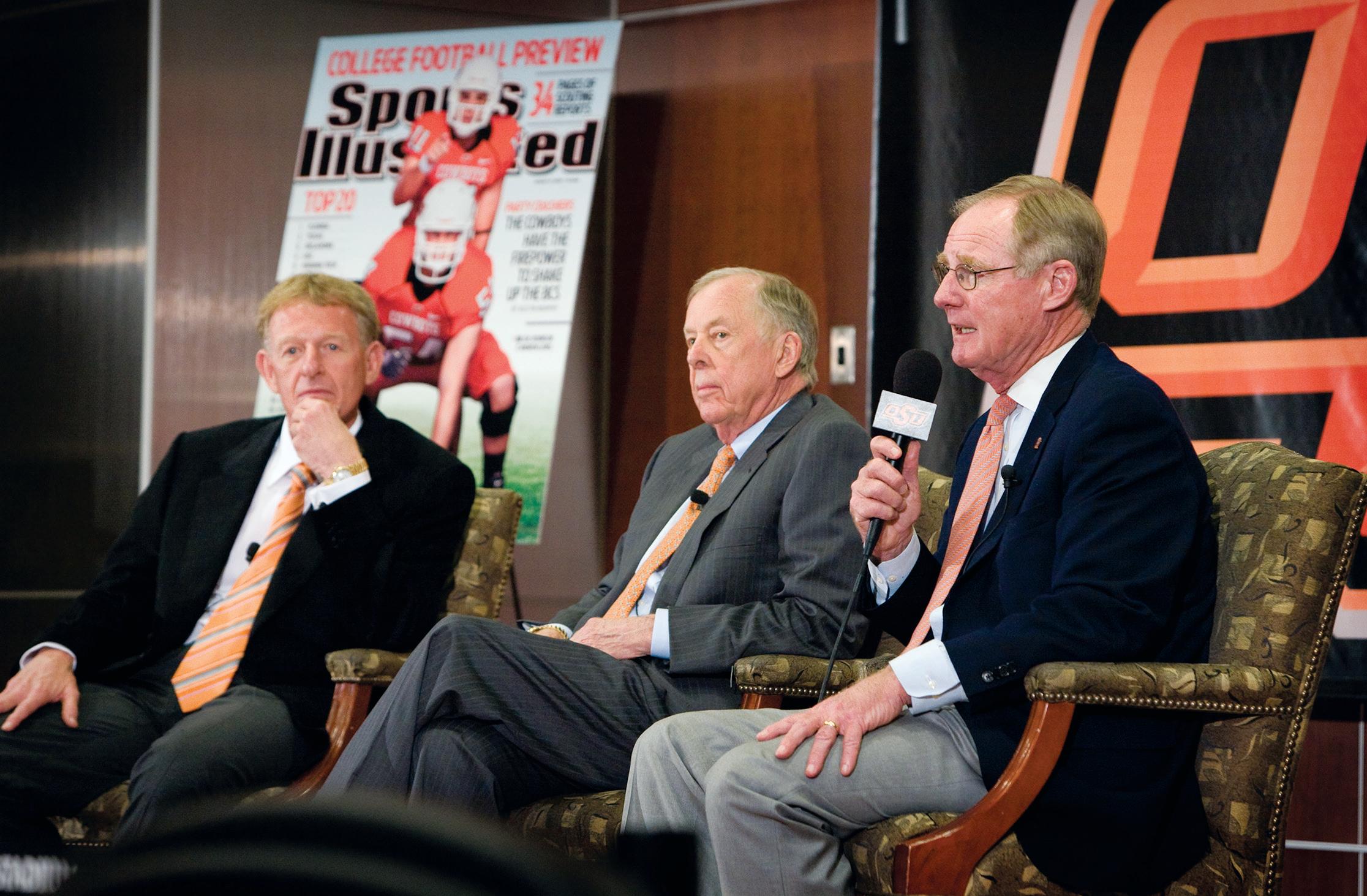
“You kind of have a natural conflict of interest, because my principal loyalty is to OSU,” he said. “And you come to the table and you have a fiduciary duty to the Big 12 as well. And sometimes those two don’t align perfectly.
“My judgment is that a healthy Big 12 is good for OSU. So I don’t see it as a concern. But there is a little bit of that when you’re talking about, are you going to give up some of your money for the good of the conference? And you’ve got to weigh those factors and decide whether it’s worth it or not.”
Hargis’ work with the NCAA covers an expansive job description.
Recently appointed to the finance committee, Hargis figures his accounting and banking background played a part in that assignment. But he said while finance committees can often be tedious, this work with numbers is anything but, centered on the analysis and distribution of revenue to NCAA member institutions.
“Nobody thinks they get what they should,” he said.
Then there’s the work on the two NCAA boards, where university leaders discuss major challenges, everything from television contracts to scandals to compensating studentathletes to a likely future of the potential
impact of widespread legalized gambling on college sports.
On the topic of TV contracts, Hargis said: “The big issue with the Big 12 is we haven’t had a network. So we’ve just announced a digital network. That may be the future. It’s a little complex in the initial going, as the Longhorn Network is one issue — ESPN has those rights to Tier 3 sports — and Fox has the rights with OU.
“So we’ll work through that.”
On the concept of paying players, with court cases ongoing that could influence the prospect of greater compensation: “We are hopeful that ultimately the courts will determine the principle of amateurism is an admirable standard and that it will endorse college athletics. I just can’t imagine what college athletics would be like if you paid players.
“We did go to full cost of attendance, which I thought needed to happen.
53 POSSE
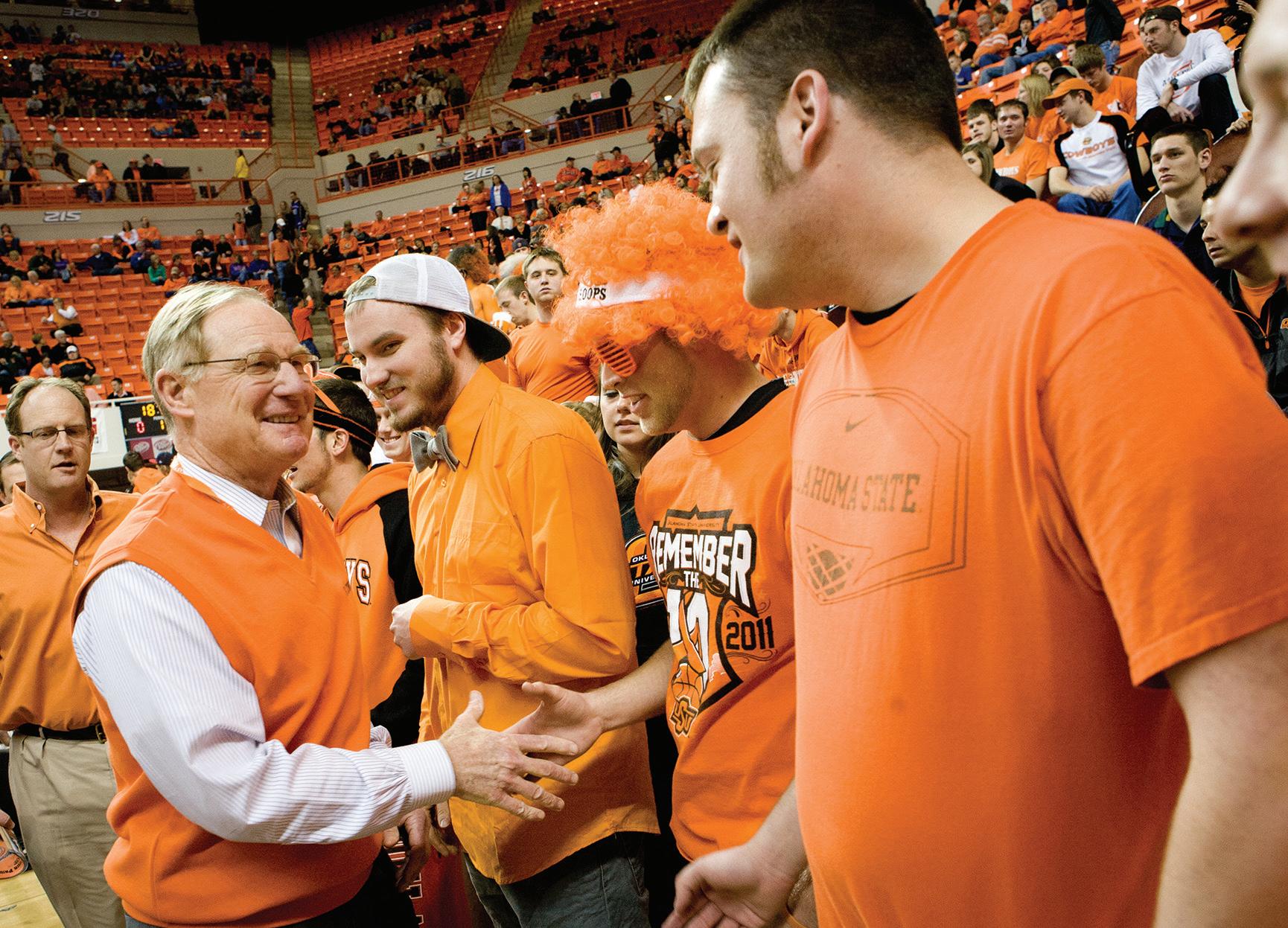
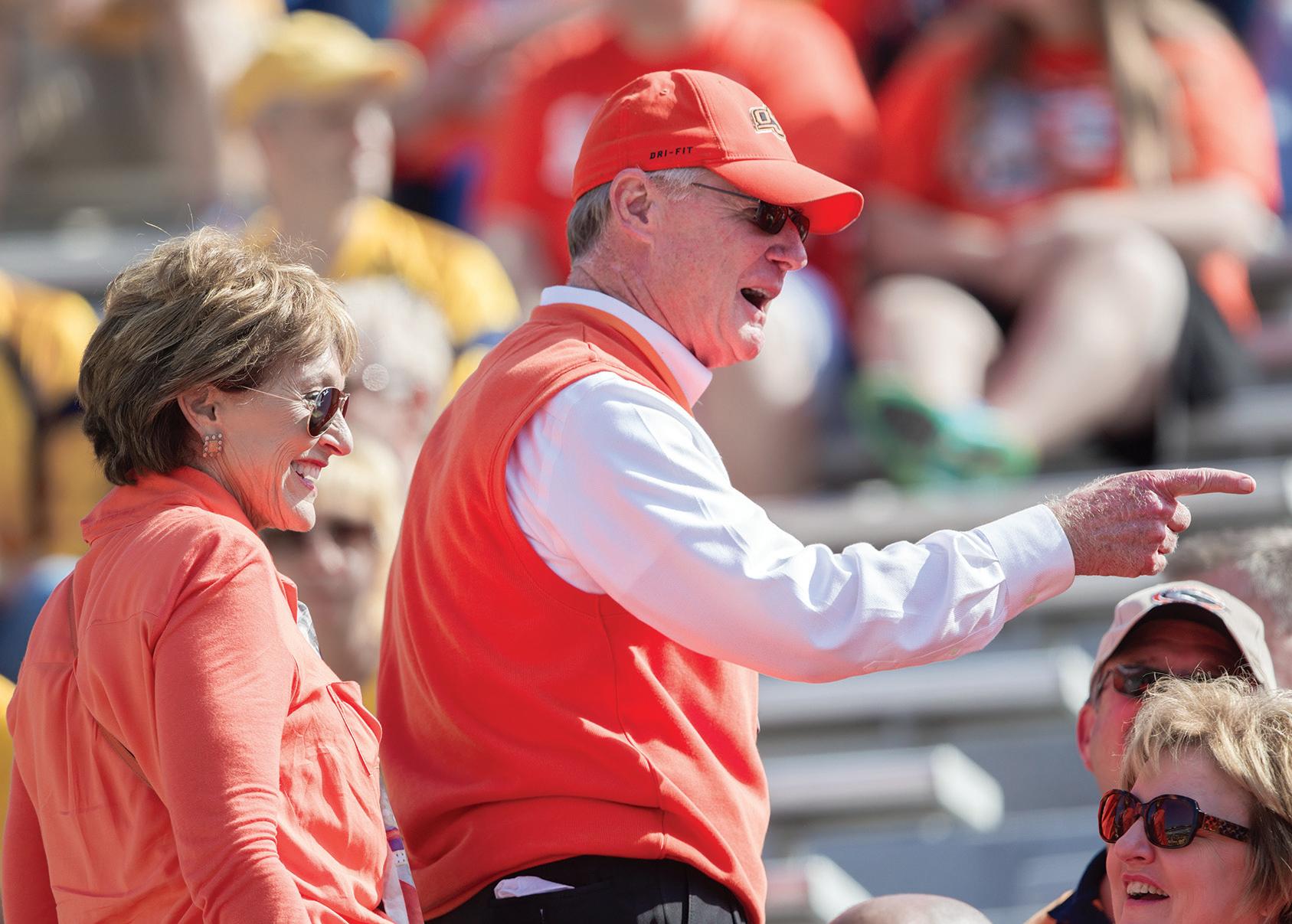

“It really is a tremendous advantage to have teams that do things the right way and that are competitive. So in that sense, as president of the university, I think it’s one of the key components to our success.”
FALL 2019 54
PHOTO BY BRUCE WATERFIELD
VALUING ATHLETICS
“In most of the sports, there’s not time for a job. I think our scholarship is worth about $22,000. The full cost of attendance that we publish is around $27,000, so a pretty good gap. So that’s an important move that we made.”
One issue of particular importance to Hargis: playing by the rules.
“The overarching rule in college athletics is institutional control. And institutional control resides with the president, or chancellor,” he said. “That’s why when the summer ends, I go over and talk to the entire athletic department and I tell them what I tell them every year: they’ve got to play by the rules, both on and off the field or the court.
“And understand, when you cheat, not only is it unethical, but it costs so much time and energy and money in trying to deal with an infractions case. It’s just not worth it.
“I think head coaches need to be sure that their assistant coaches are playing by the rules. It’s worse than just an infraction, it’s expensive. And I think it damages your reputation, which can translate to how many fans are in the seats or subscribing to your network.”
Those are big issues. And Hargis faces even more on campus, where there’s always work to be done, buildings to be built, and students to accommodate.
Good thing he likes being busy.
“I like having a seat at the table,” Hargis said. “This job, just generally, has so many angles to it. It’s different than anything in which I've been involved.
“As a banker, I was involved in a lot of civic stuff, so there was that. Here, you really have to pay attention, because the stakes are high. And everybody is watching and everybody cares. I’ve never been in a position where people care about what I think like I am now.
“You have to get it right. And I think generally we’ve done that.”
Clearly, Hargis is a sports fan. But he portrays a shrewd valuation of athletics in boosting the university. So shrewd, he directed one donor, who claimed to not be a “big football fan,” toward Boone Pickens Stadium instead of academics for initial gift giving, although with a calculated strategy.
“I was after him for a million dollars for an endowed chair, and Holder was after him for a suite,” Hargis said. “And the alum called me and said, ‘I’m not going to do both, but I’ll do whichever one you say.’
“And I said, ‘I want you to do the suite.’ He said, ‘Really?’ I said, ‘Yeah, it’ll get you back here, and you’ll get involved again.’
“That’s what happened. And he was here all the time. And now, we’re close to $10 million to the academic side of the house from him.”
Athletics, Hargis said, is a gateway to giving to athletics, but also to the university as a whole.


“I’m a sports fan, so that’s one thing,” Hargis said. “But I really do think that sports are very important for the university. I think it is, in many respects, the front door.”
Through athletics, many Oklahoma State people find a connection, a rallying point of pride. And from there, relationships grow, leading folks through the front door and onto the rest of the house.
“My flippant line always is, ‘It’s hard to get 60,000 people to show up for a math contest,’” Hargis said. “But time and time again, we’ve seen where the alums come back, they get excited going to the games, same for the fans. And maybe even start out supporting athletics.
“But slowly they’ll gravitate back to their roots, academy or leadership, activities on campus. It really is a tremendous advantage to have teams that do things the right way and that are competitive. So in that sense, as president of the university, I think it’s one of the key components to our success.”
PHOTO BY GARY LAWSON
55 POSSE
PHOTO BY BRUCE WATERFIELD
Over in athletics, they count Hargis as a key component to their success.
And OSU knows something about winning, with 52 NCAA national championship banners hanging from the rafters of Gallagher-Iba Arena. Those 52 rank fourth in the NCAA, with contributions from five sports.
It takes great athletes to win like the Cowboys and Cowgirls win.
Takes talented recruiters, too. Like Hargis.
“We use President Hargis in recruiting,” Gundy said of the football program, which coincidentally is enjoying the greatest run of success in program history. “He’s never turned us down, as long as he’s in town. And he’s going to spend 30 solid minutes with a young man we’re recruiting, and really be involved.
“He’s the highest-ranking guy on the campus. For me, I don’t think it would have mattered, I just liked playing football. I went to school so I could play football, but I knew I had to get an education.
“But some young men are smarter than that, and it’s a big deal to them and their parents if the president of the university sits down with them for 30 minutes. That’s a big deal.”
For OSU’s student-athletes, who see Hargis visibly and passionately offering support, it matters.

“If your president is rooting for you, that goes a long way, because he’s in charge of everything,” said Cowboys football standout Chuba Hubbard. “That’s a good feeling to know he’s on your side.”
It’s not just football, Hargis is willing to make the case for OSU to recruits in any sport. First, he requires some background information, on the player and their family — where they’re from, what the parents do for a living, what the athlete seeks to study.
Hargis insists on doing his homework and being prepared.
“He requires information,” Gundy said, “because he’s not just selling you something. He cares. “Other places I’ve been, the president didn’t take time to do all of that.”
But then, not all presidents are like Hargis. A diverse background and a comfort in the spotlight shine through as Hargis addresses a variety of audiences. He figures he’s the lone non-academic on the various NCAA committees, having come to his OSU presidency after a long and distinguished legal and business career, where he was active in civic and philanthropic leadership across many fronts.
He has served and chaired many boards, was a Republican nomination for Governor of Oklahoma in 1990, and in 2009 received one of the state’s high honors when he was inducted into the Oklahoma Hall of Fame.
So it’s easy to see why Hargis is so skilled at mixing and mingling.
“I think he’s like an old pair of jeans, he’s comfortable in just about any situation,” Holder said. “He can converse with anyone from the President of the United States on down.
“I can’t imagine having a better personality in the president’s office than Burns Hargis.”
Another Hargis fan is Kevin Klintworth, OSU’s senior associate athletic director for communications. Klintworth and the OSU football team watched Hargis from a Des Moines hotel on that Friday morning in 2011 when he addressed the media, and in essence a national television audience, the day following the tragic plane crash that took the lives of OSU women’s basketball coach Kurt Budke and his assistant coach Miranda Serna , along with Olin and Paula Bransetter
“It was such a difficult, difficult day,” Klintworth said. “There is no script to write for that kind of news conference. For me it was, I guess the word is comforting, to know that President Hargis was speaking for us and would be the face of the university during that tragedy. There are people who might be great with the media, but still not be able to handle that sort of environment. I’m sure it wasn’t easy for him, but I don’t think anyone could have done it any better.”
Touring new West End Zone of Boone Pickens Stadium, 2009
FALL 2019 56
PHOTO BY GARY LAWSON
CLOSING THE DEAL
Personality matters in recruiting, something not lost on OSU’s coaches.
“Within reason, I’m willing to do anything to help these guys recruit quality athletes,” he said. “And I enjoy meeting them. I enjoy meeting their families.
“I tease especially coach Gundy and coach Boynton, ‘I’m the straw that stirs the drink here.’ Of course, that’s ludicrous. But it really is enjoyable. It’s a nice aspect of my job.”
Maybe Hargis shouldn’t be so modest. Who better for a recruiting closer, that sort of ace in the hole?
“Who doesn’t Burns connect with?” Reece said. “It doesn’t matter if you’re a student, an alum, a donor, just a fan, he just really can connect with people. And he’s so quick-witted, it’s fun to have him at a speaking engagement, but it’s also fun to sit across from him at his desk and listen to things he has to say. He has so much history here and such a love for the university, I think there’s such a way he can connect.
“And when he can tell them, ‘Yeah, I went to school here. I love this place. And when I came back as president, when I was successful in business.’ I think that hits home with parents and it hits home with recruits.”
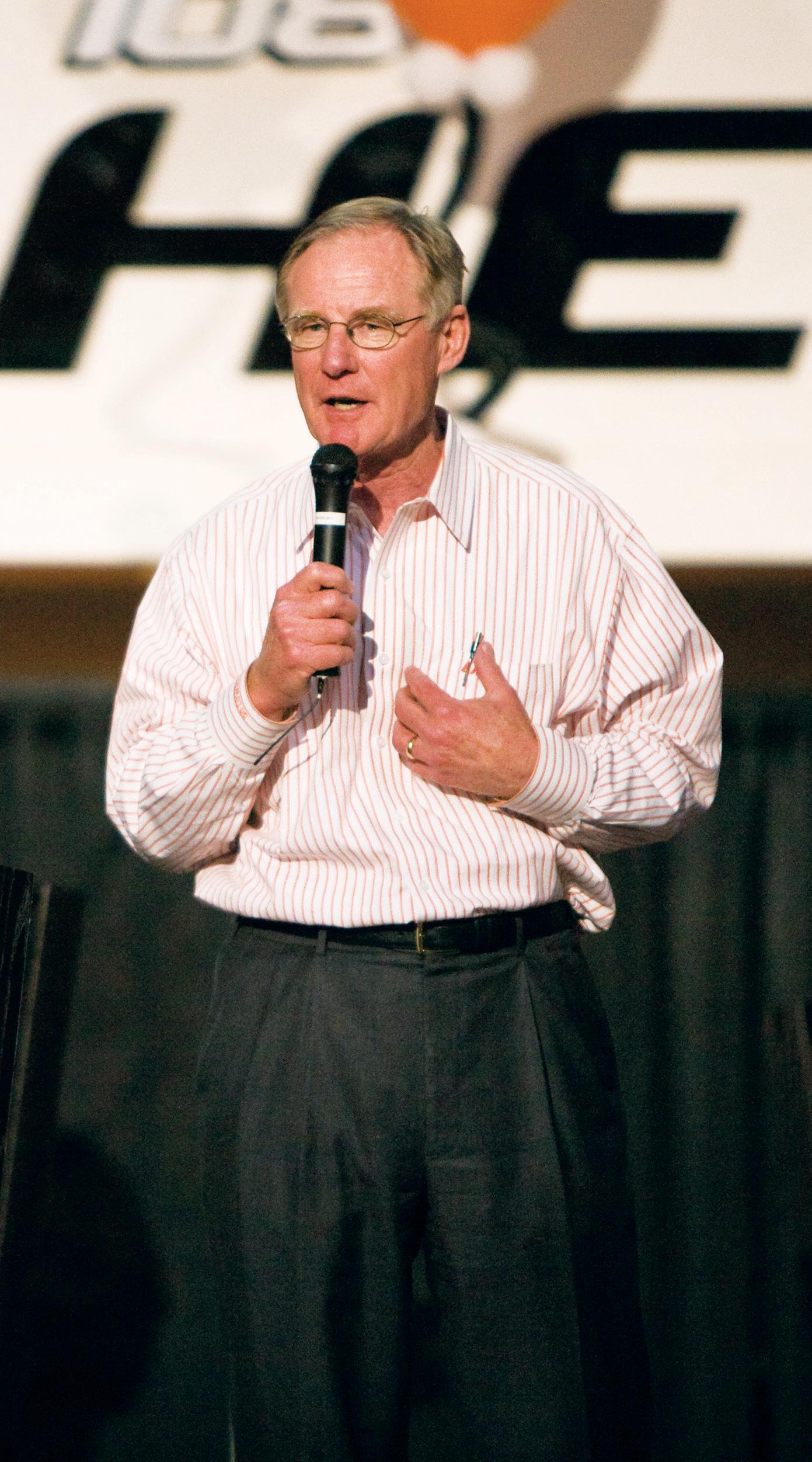
“I really do think that sports are very important for the university. I think it is, in many respects, the front door.”
— BURNS HARGIS
57 POSSE
PHOTO BY PHIL SHOCKLEY
A CAMPUS COMMITTED
TO YOU
OKLAHOMA STATE UNIVERSITY IS COMMITTED TO PROVIDING THE BEST EDUCATION AT AN AFFORDABLE COST.

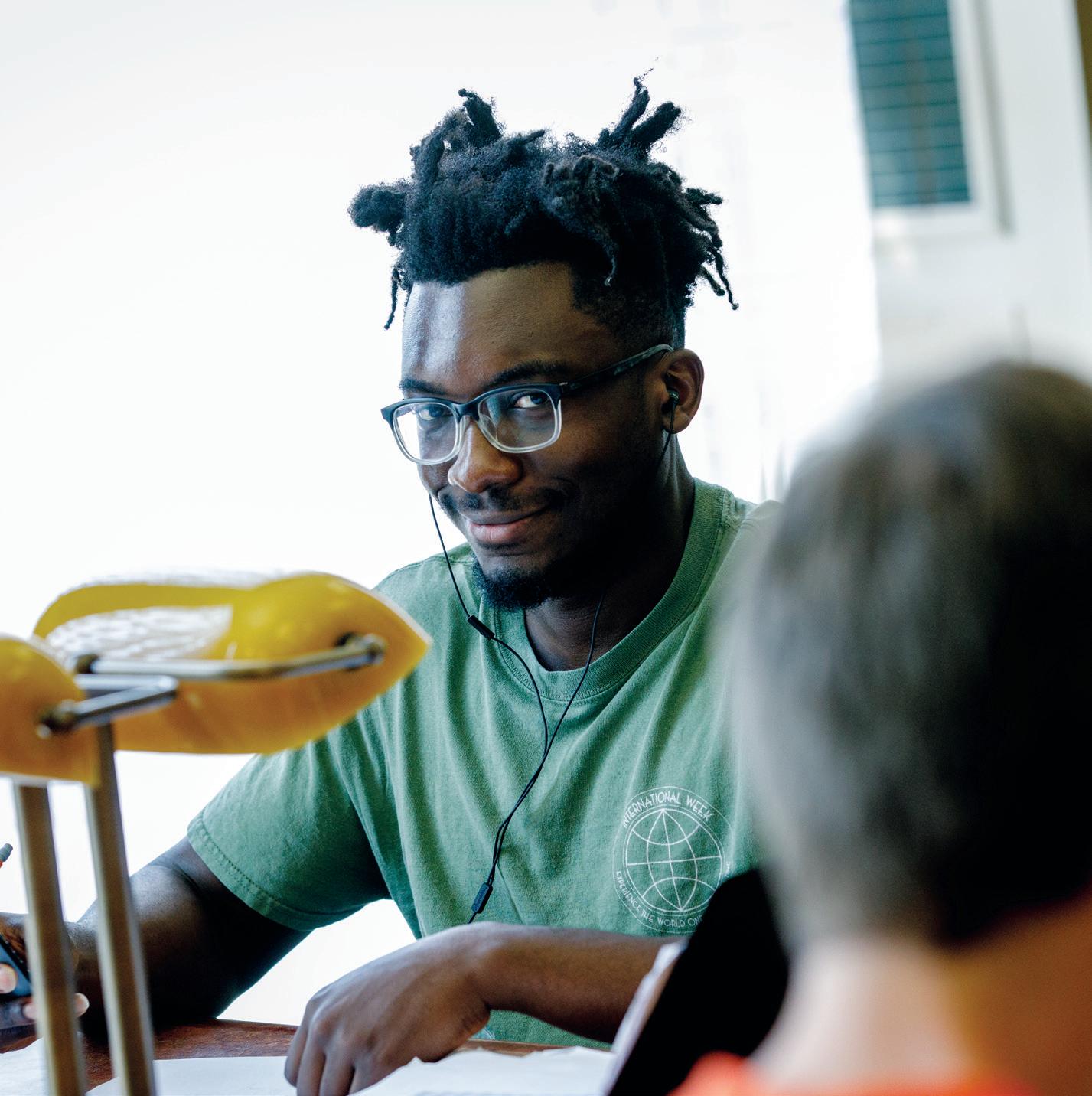
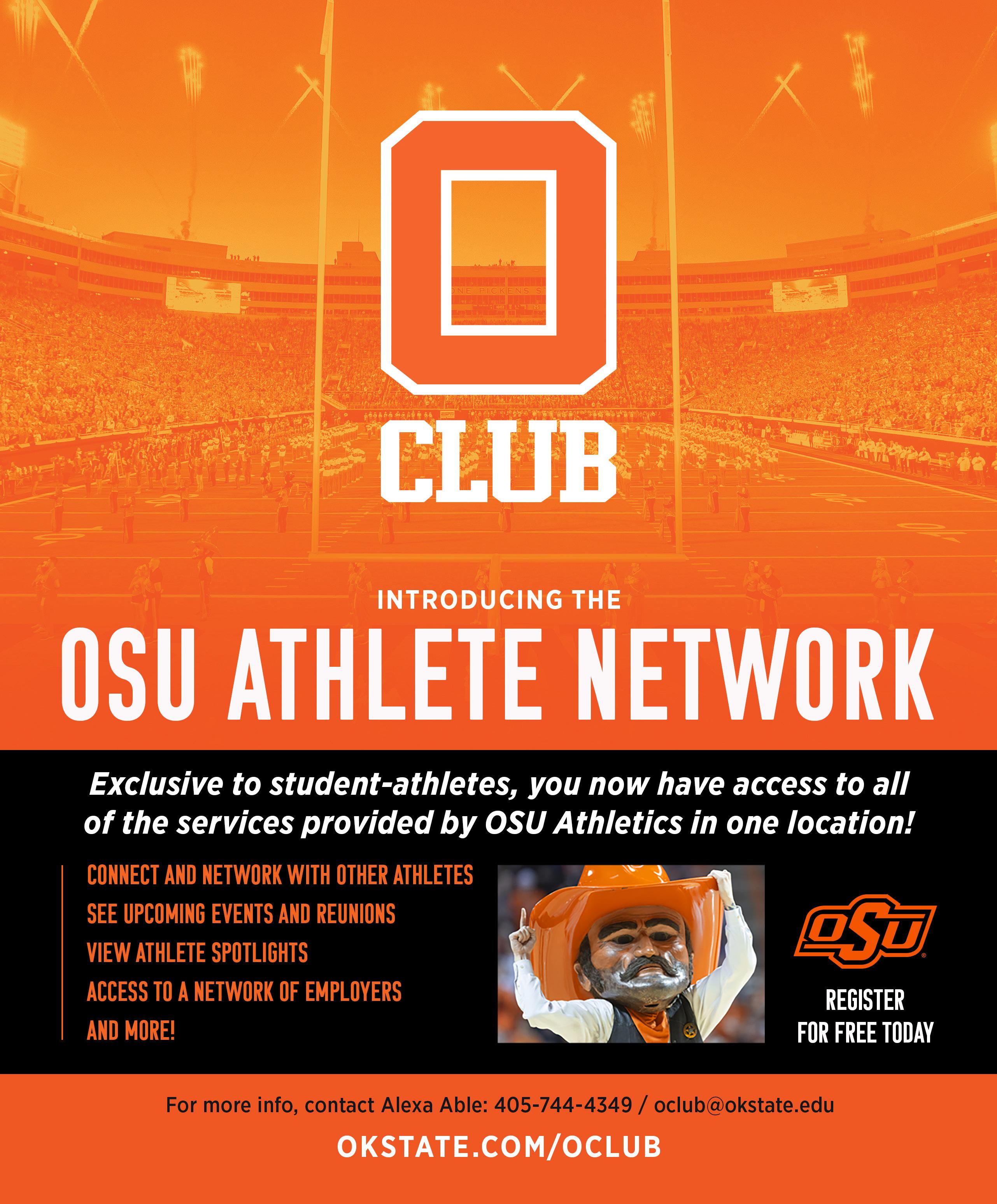
Our students have hands-on research opportunities as early as their freshman year and faculty who are leaders in their field.
Seniors, apply by the Feb. 1 Priority Scholarship Deadline for consideration for most OSU scholarships. Become a Cowboy today!
okla.st/apply



2 Malone & Amy Mitchell 3 William S. Smith 4 Patterson Family 5 Dennis & Cindy Reilley 6 John Clerico 7 W & W Steel, LLC 8 Michael & Anne Greenwood 9 Robert A. Funk 10 Ross & Billie McKnight 11 Karsten Manufacturing 12 A.J. & Susan Jacques 13 James & Mary Barnes 14 Anonymous #18 15 Vicki & Bob Howard 16 Helmerich Family 17 Harold Courson 18 Chesapeake Energy Inc 19 ONEOK, Inc. 20 Joe & Connie Mitchell 21 Simmons Bank 22 Ken & Jimi Davidson 23 Jack & Carol Corgan 24 Mike & Robbie Holder 25 OSU President's Office 26 Watson Family Foundation 27 Kent & Margo Dunbar 28 OSU Foundation 29 Chad Clay 30 Greg & Rhonda Casillas 31 Baloo & Maribeth Subramaniam 32 David & Tracy Kyle 33 OG&E 34 Vickie & Tucker Link Foundation 35 Waits Family 36 Richard & Barbara Bogert 37 Gary & Jerri Sparks 38 The Cobb Family 39 Russ Harrison & Natalie Shirley 40 Johnston Enterprises 41 Jerry & Rae Winchester 42 Calvin & Linda Anthony 43 RCB Bank 44 Anonymous #1 45 Bryant & Carla Coffman 46 Brad & Margie Schultz 47 Darton & Jamie Zink 48 Joullian & Co 49 Baab Legacy, LLC 50 Lambert Construction 51 Mike Bode & Preston Carrier 52 Jana Drummond 53 Flintco, Inc. 54 Anonymous #2 55 Wiese Family 56 Phil & Ruth Terry 57 Mark & Lisa Snell 58 Ed Evans 59 David & Julie Ronck 60 Barry & Roxanne Pollard 61 E. Turner & Cynthia Davis 62 American Fidelity 63 KNABCO Corp 64 Steve & Diane Tuttle 65 Anonymous #3 66 Jay & Connie Wiese 67 Sparks Financial 68 OSU Center for Health Sciences 69 Jameson Family, LLC 70 Z-Equpment, LLC 71 Pam J. Russell 72 Seventy Seven Energy 73 Joe & Vickie Hall 74 Jim & Vicki Click Jr. 75 Atlas Asphault Products 76 Bank of Oklahoma 77 Ed & Kathy Raschen 78 Chip & Cindy Beaver 79 Anonymous #4 80 Mark & Beth Brewer 81 Richard & Joan Welborn 82 Steve & Vicki Farris 83 Ike & Mary Beth Glass 84 Andy Johnson 85 Larry Albin 86 OSU Business Office 87 The Bank of America 88 John Groendyke AS OF OCTOBER 1, 2019 1
– 6,115,719 TOP 150 DONORS (BASED ON PRIORITY POINTS) FALL 2019 60
Boone Pickens
OSU ATHLETICS POSSE POINT SYSTEM
The Priority Point System provides a fair, consistent and transparent method of providing benefits to donors in exchange for their financial investments in OSU athletics.
Donors gain points three ways:
Contributions
All current and lifetime contributions (cash or stock) are worth 3 points per $100 donation. Planned (deferred) gifts in the new Leave a Legacy Endowment Campaign will receive 1 point per $100.
Commitment
Donors will earn one point each year for purchasing season tickets (one point per sport annually), as well as one point for each year of POSSE donations.

Connection with the University
Donors (or their spouses) who are OSU Alumni receive a one-time 10 point bonus, as do OSU faculty/staff and letterwinners.
Points never diminish and will carry over to subsequent years. Donors retain all previously earned Priority Points in their giving history. For questions about the POSSE Priority Point System, email posse@ okstate.edu or call us at 405-744-7301.
HOW DO MY POINTS RANK? as of OCTOBER 1, 2019
89 David Bradshaw 90 Fechner Pump & Supply 91 Henry Wells 92 Steve & Jennifer Grigsby 93 OSU Alumni Association 94 David LeNorman 95 Gary & Claudia Humphreys 96 BancFirst 97 Philip & Shannon Smith 98 Harvey & Donna Yost 99 Emricks Van & Storage 100 Southwest Filter Co. 101 MidFirst Bank 102 Jerry Marshall 103 Griff & Mindi Jones 104 Doug & Nickie Burns 105 Thomas & Barbara Naugle 106 Steve Tatum 107 John & Kaye Hull 108 Larry & Kayleen Ferguson 109 Bryan Close 110 Ron McAfee 111 AEI Corporation 112 Barber-Dyson Ford Lincoln-Mercury 113 Austin & Betsy Kenyon 114 Sandra M. Lee 115 Vionette & John Dunn 116 Brent & Mary Jane Wooten 117 Bob & Mary Haiges 118 Mike & Glynda Pollard 119 Fred & Janice Gibson
Points 6,115,719 240,559 65,660 39,704 32,228 25,934 18,680 10,297 5,190 2,469 802 222 76 52 Rank 1 5 25 50 75 100 150 250 500 1,000 2,500 5,000 7,500 8,500
120 Lon Kile 121 Robert & Sharon Keating 122 Chris & Julie Bridges 123 Randy & Pati Thurman 124 Jerry & Lynda Baker 125 Bill & Marsha Barnes 126 Brad & Leah Gungoll 127 Terry & Martha Barker 128 Harrison Investments 129 K.D. Greiner 130 Byford Auto Group 131 Prosperity Bank 132 Johnsons of Kingfisher 133 Drummond Investments 134 Stan & Shannon Clark 135 Crossland Construction 136 Jon H. Wilson 137 Russ & Julie Teubner 138 Jack Bowker Ford-Lincoln 139 Malzahn Family 140 Mike & Judy Johnson 141 Gary & Mary Ellen Bridwell 142 James H. Williams 143 Bruce & Sheryl Benbrook 144 The Oklahoman 145 A-Cross Ranch 146 Donielle & Lindel Larison 147 Chandler USA, Inc. 148 Scott & Kim Verplank 149 Mustang Fuel 150 Bill & Karen Anderson 61 POSSE
PHOTOBYBRUCEWATERFIELD

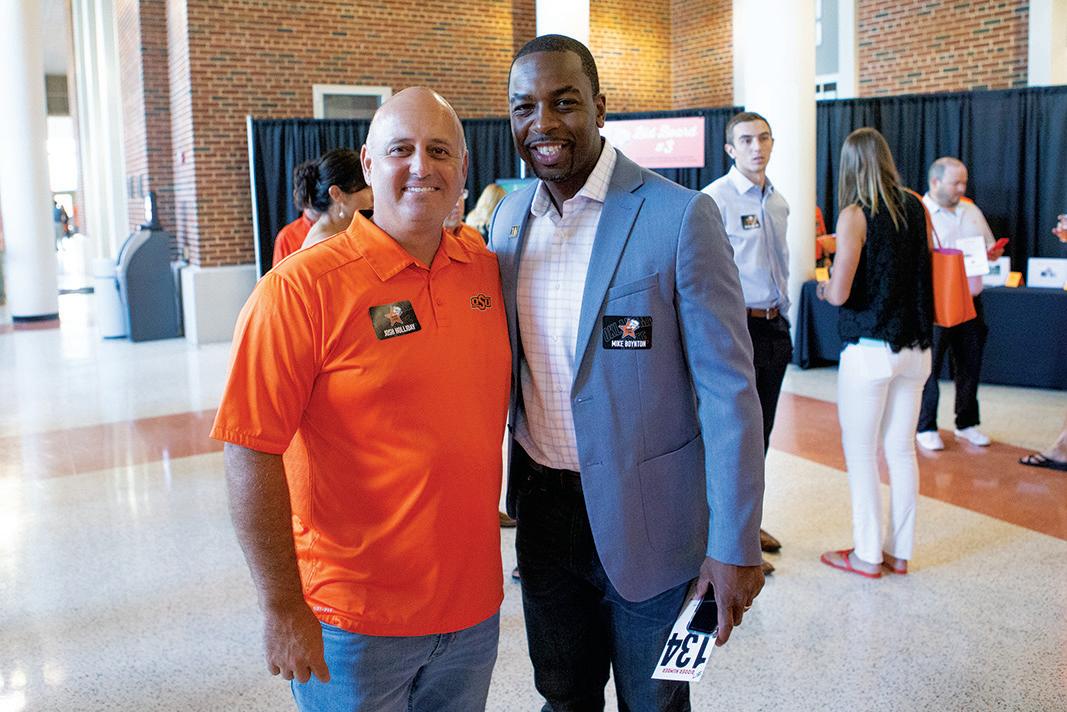

FALL 2019 62
UP ‘FORE’ BID
The 2019 POSSE Benefit Auction celebrated the 1995 NCAA golf champions while raising more than $335,000 for student-athlete scholarships. At left, Trip



63 POSSE
Kuehne, Kris Cox, Leif Westerberg, Chris Tidland and Alan Bratton.
FIELD OF DREAMS
Captured remotely from an Orange Power Studios drone, this incredible aerial view of O’Brate Stadium and the OSU campus as seen from the north shows off Cowboy Baseball’s magnificent new home, opening March 20, 2020.

PHOTOBYBRUCEWATERFIELD
FALL 2019 64

65 POSSE

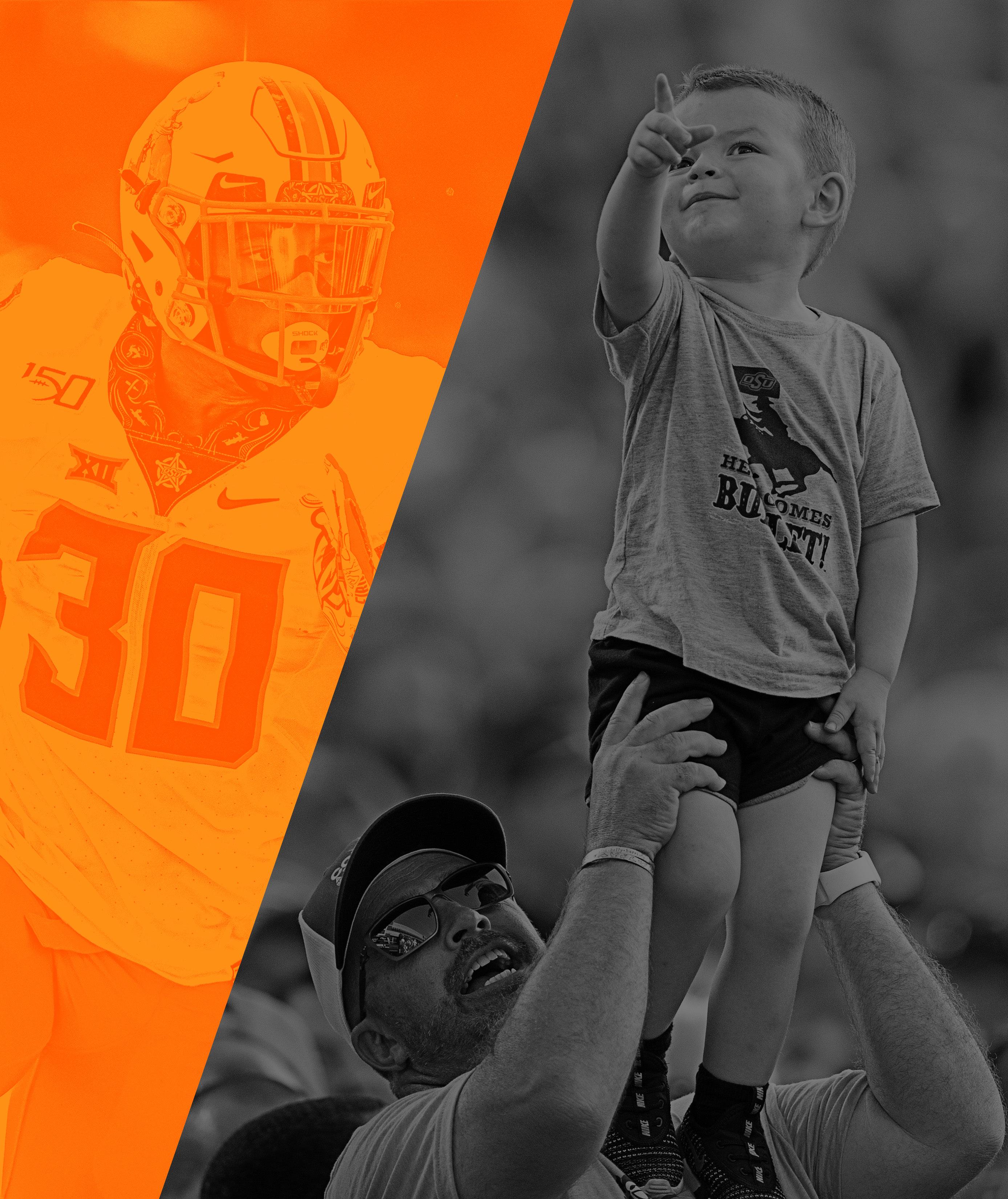
Fill Your Suitcase With Orange


Bowl Games. Tournaments. Championships. If the Cowboys or Cowgirls are there, so are we. Find official travel packages for OSU Athletics with options to suit every fan’s needs at OKStateFanTravel.com

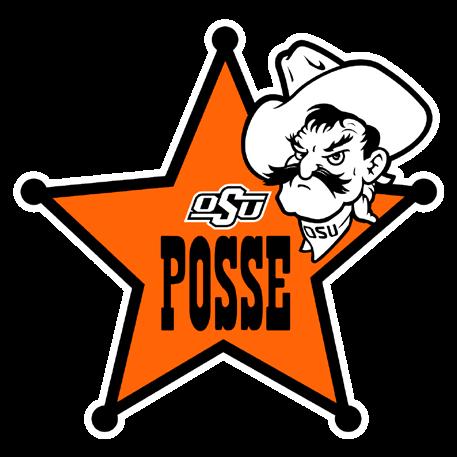



SALUTE TO BOONE
The OSU Spirit Rider honored the late Mr. Pickens each time Bullet took the field as the Cowboys defeated Kansas State on September 28.
PHOTOBYBRUCEWATERFIELD

FALL 2019 68

69 POSSE

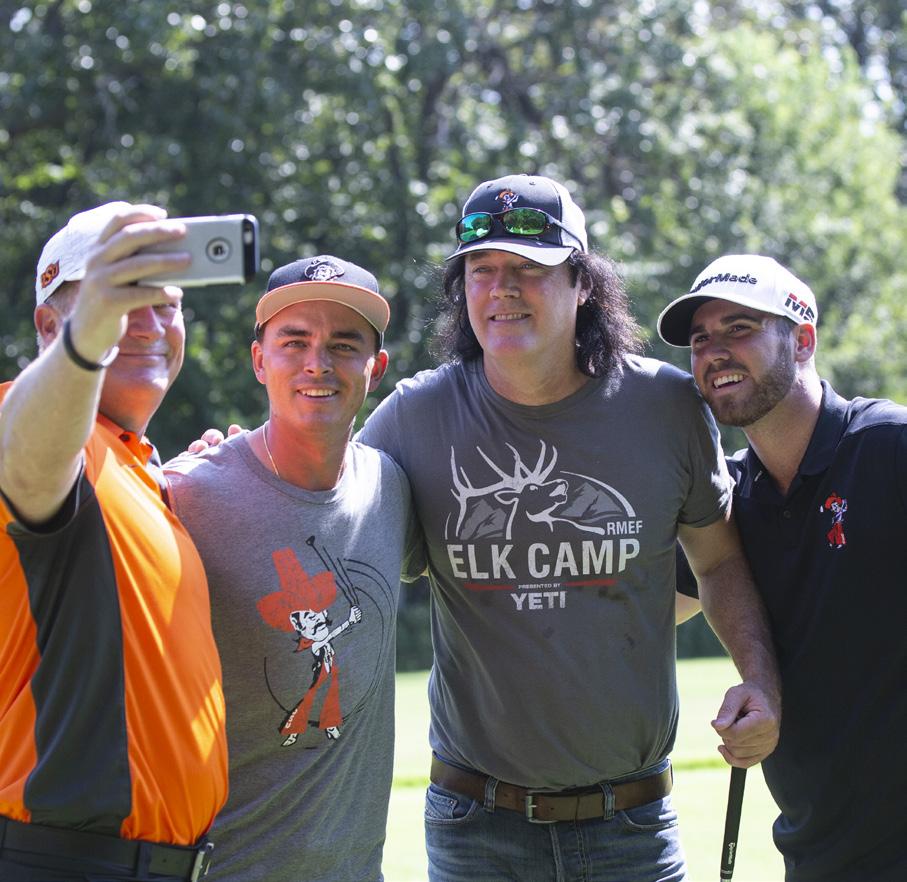

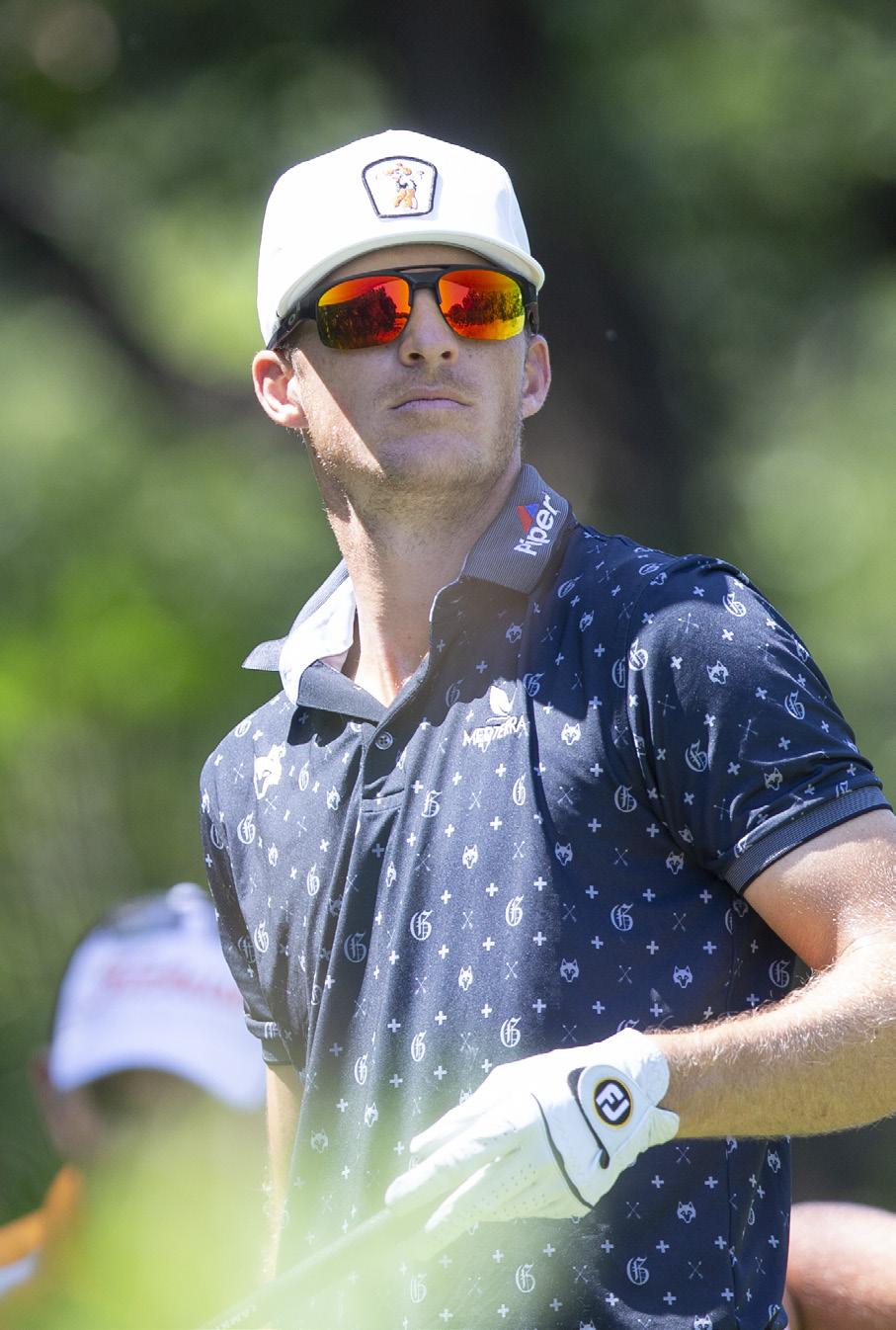
FALL 2019 70
DRIVING CHAMPIONSHIPS
Held for 47 consecutive years, the Cowboy Pro-Am serves as a fundraiser for OSU Golf as well as an informal reunion for players past and present and an annual opportunity to celebrate one of the most storied programs in all of college athletics.




71 POSSE
PHOTOSBYBRUCEWATERFIELD
When OSU announced its scholarship endowment initiative, the athletic program was last in the Big 12. Now, more than halfway through the 10-year program, OSU leads the conference.
But we’re not finished yet.
OSU awards 229 full scholarships to studentathletes each year at a cost of $4.5 million. Each dollar freed up through endowed scholarships goes back into our programs. Better equipment. Better facilities. Better support. Each dollar has a direct impact on the lives of our student-athletes.
“Each scholarship we endow secures the future of OSU athletics and provides more opportunities for our student-athletes on and off the field,” says Mike Holder, Vice President for Athletic Programs and Director of Intercollegiate Athletics.

This is the list of all the generous supporters who have helped to provide a bright orange future.
They are our Honor Roll.
Baseball 10.25
Full Scholarship
Dennis and Karen Wing (2) | Hal Tompkins
Sandy Lee | Jennifer and Steven Grigsby
Mike Bode and Preston Carrier (2)
David and Julie Ronck
Half Scholarship
Sally Graham Skaggs
Quarter Scholarship
Bryant and Carla Coffman
David and Grace Helmer | Jill Rooker
Martha Seabolt | Dr. Scott Anthony
John and Beverly Williams
Richard and Lawana Kunze
Equestrian 1.25
Full Scholarship
Baloo and Maribeth Subramaniam
Quarter Scholarship
David and Gina Dabney
Football 33.0
Full Scholarship
Bob and Kay Norris
Bryant and Carla Coffman /
The Merkel Foundation
David LeNorman | Dennis and Karen Wing (2)
Dr. Mark and Beth Brewer
Jack and Carol Corgan Football Scholarship
Jim Click | John and Gail Shaw
Ken and Jimi Davidson | Leslie Dunavant
Mike and Kristen Gundy
Mike and Robbie Holder
Ron Stewart | Ross and Billie McKnight
Sandy Lee | Tom and Sandra Wilson
Wray and Julie Valentine
James and Mary Barnes
Half Scholarship
Cindy Hughes | Donald Coplin
Doug Thompson | Ed and Helen Wallace
Greg Casillas | Ike and Marybeth Glass
Jim and Lynne Williams / John and Patti
Brett Mike and Judy Johnson | Sally Graham
Skaggs State Rangers | Tom Naugle | Nate Watson
Quarter Scholarship
Al and Martha Strecker
Arthur “Andy” Johnson, Jr.
Arthur Couch | Barry and Roxanne Pollard
Bill and Ruth Starr | Brad and Leah Gungoll
Brian K. Pauling
Bridgecreek Investment Management LLC
Bryan Close | David and Cindy Waits
David and Gina Dabney | Dr. Berno Ebbesson
Dr. Ron and Marilynn McAfee
FALL 2019 72
PHOTO / BRUCE WATERFIELD
Eddy and Deniece Ditzler | Flintco
Fred and Janice Gibson | Fred and Karen Hall
Howard Thill | James and LaVerna Cobb
Jerry and Lynda Baker | Brent Wooten
Jerry and Rae Winchester | John P. Melot
John S. Clark | Ken and Leitner Greiner
Kent and Margo Dunbar | Paul and Mona Pitts
R. Kirk Whitman | Randall and Carol White
Roger and Laura Demaree | Shelli Osborn
Steve and Diane Tuttle
Tony and Finetta Banfield
General
1.25
Half Scholarship
Terry and Martha Barker
Quarter Scholarship
David and Judy Powell
Kenneth and Susan Crouch
Sally Graham Skaggs
Graduate Athlete
0.75
Quarter Scholarship
Bob and Joan Hert | Neal Seidle
Tom and Cheryl Hamilton
Men’s Basketball
23.25
Full Scholarship
Baloo and Maribeth Subramaniam
A.J. and Susan Jacques
Bill and Marsha Barnes
Brett and Amy Jameson
Calvin and Linda Anthony
Chuck and Kim Watson
David and Julie Ronck (1.25)
Dennis and Karen Wing (2)
Douglas and Nickie Burns
Griff and Mindi Jones
James and Mary Barnes | Jim Vallion
Ken and Jimi Davidson
Kent and Margo Dunbar | KimRay Inc.
Sandy Lee | Mitch Jones Memorial
Half Scholarship
David and Julie Ronck
Dr. Mark and Susan Morrow
Jay and Connie Wiese | Sally Graham Skaggs
Stan Clark | Billy Wayne Travis
Holloman Family
Quarter Scholarship
Dr. Scott and Lynne Anthony
Gary and Sue Homsey
Michael and Heather Grismore
Rick and Suzanne Maxwell
Robert and Sharon Keating
Steve and Suzie Crowder
Terry and Donna Tippens
Men’s Golf
5.25
Full Scholarship
David and Julie Ronck
Dennis and Karen Wing
Jack and Carol Corgan Men’s Golf Scholarship
Baloo and Maribeth Subramaniam
Half Scholarship
Simmons Bank
Quarter Scholarship
Bob and Elizabeth Nickles
Garland and Penny Cupp
Richard and Joan Welborn
Men’s Tennis
0.25
Quarter Scholarship
Tom and Cheryl Hamilton
Men’s Track
0.75
Quarter Scholarship
Dr. Mark and Susan Morrow
Susan Anderson | Ken and Leitner Greiner
Soccer
1.0
Full Scholarship
James and Mary Barnes
Softball
0.25
Quarter Scholarship
Tom and Cheryl Hamilton
Women’s Basketball
6.5
Full Scholarship
Brad and Margie Schultz
Ken and Jimi Davidson
Mike Bode and Preston Carrier
Half Scholarship
Baloo and Maribeth Subramaniam
Don and Mary McCall
John and Caroline Linehan
Calvin and Linda Anthony
Quarter Scholarship
Bill and Roberta Armstrong
Bill and Sally Cunningham
Donald Coplin | Jill Rooker
Richard and Linda Rodgers
Jo Hughes and Deborah J. Ernst
Women’s Golf
2.0
Full Scholarship
Baloo and Maribeth Subramaniam
Half Scholarship
David and Julie Ronck
Quarter Scholarship
Amy Weeks | Kent and Margo Dunbar
Women’s Tennis
0.25
Quarter Scholarship
Jamie Maher
Wrestling
10.75
Full Scholarship
A.J. and Susan Jacques
Bruce and Nancy Smith
Chuck and Kim Watson
Lon and Jane Winton
OSU Wrestling – White Jacket Club /
Gallagher Endowed Wrestling Scholarship
OSU Wrestling – White Jacket Club / Myron Roderick Endowed Wrestling Scholarship
OSU Wrestling – White Jacket Club / Ray Murphy Endowed Wrestling Scholarship
OSU Wrestling – White Jacket Club / Tommy Chesbro Endowed Wrestling Scholarship
The Cobb Family
Half Scholarship
Mark and Lisa Snell
Bobby and Michelle Marandi
Quarter Scholarship
Danny and Dana Baze / Cory and Mindy Baze
John and Beverly Williams | R.K. Winters
To learn more about scholarship opportunities and how you may contribute, please contact:
Larry Reece (405-744-2824)
Matt Grantham (405-744-5938)
Shawn Taylor (405-744-3002)
73 POSSE
ALL-AROUND COWBOY
STORY BY GENE JOHNSON

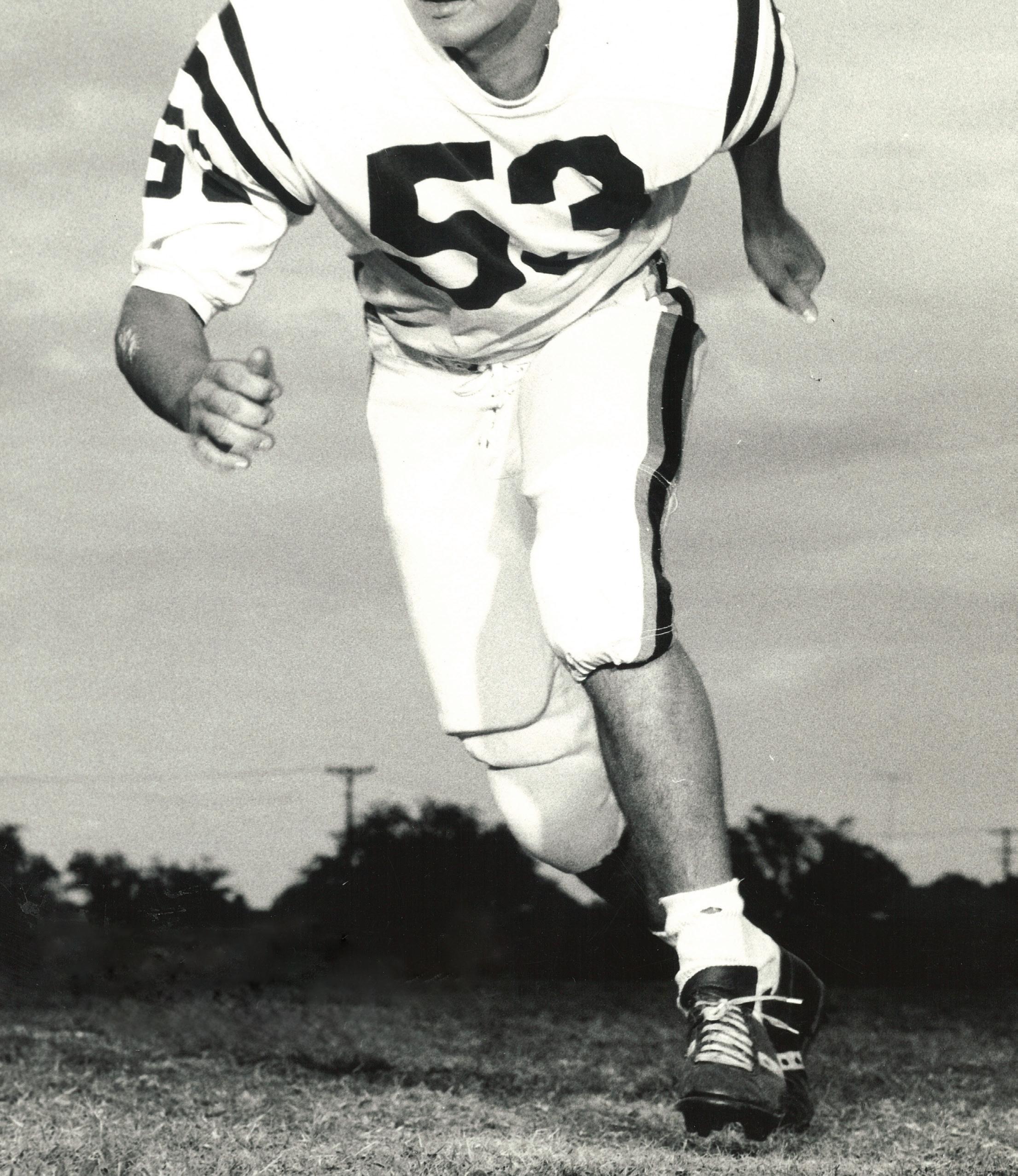

FALL 2019 74
HAVE YOU EVER ATTEMPTED SOMETHING THAT WAS TOUGH — AN EVENT THAT WAS CHALLENGING BEYOND IMAGINATION?
Something you didn’t know was achievable? Something dangerous or painful? Something like swimming across the piranha-infested Amazon River or maybe walking barefoot across a bed of hot stones?
This story is about a young man and his teammates who found themselves in a predicament that stretched them physically and mentally — and unmercifully.
Some 56 years ago, Cowboy footballers endured a situation they recall as a living hell!
Scores of those who began the challenge quit within a few weeks and weren’t shamed by those who continued. Those who survived felt somewhat better for the journey traveled, possibly earning, in their own eyes, a badge for valor and perseverance.
On the flip side, have you ever met a guy who impresses you? Positive, personable and humble. Always smiling, encouraging, generous. Persevering, strong work ethic, fierce competitor. Charming, a high achiever and a person you can’t help but like?
Jim Click possessed these qualities as a college sophomore and still does today, according to his OSU teammates, Larry Elliott and Charlie Durkee.
They were all survivors.
The year was 1944. It was the year future movie star Jimmy Stewart flew his 12th combat mission over Berlin. It was the year the British Royal Air Force dropped 2,300 tons of bombs on Germany, and it was the year ‘Jim’ Harley Click Jr. was born.
Jim’s father, born in 1915, was only three when hs father passed away. Jim Sr. and his siblings went to live with his mother's family, the Tuttles.
In 1923, hard times fell on the Tuttles and they were forced to move off the family property. Holmes Tuttle, Jim’s great-uncle, went to work for the Ford Motor Company in downtown Oklahoma City, earning five dollars daily. In 1926, Mr. Tuttle hitchhiked to Los Angeles and was hired by Elliott Cook Ford, who operated the only Ford dealership that didn’t go broke during the depression.
“Following World War II, after years of working diligently in the auto business, Mr. Tuttle was awarded a Ford dealership by Mr. Henry Ford,” Click said. “It was located between Beverly Hills and Los Angeles. Later, Holmes Tuttle became a close friend, confidante and adviser to Ronald Reagan, convincing him to run for governor of California. And the rest is history. Mr. Tuttle was one of a kind. He loved America.”
Following high school graduation in 1933, Jim’s father joined the Marines and spent three years in Shanghai, China.
According to Jim, “Dad always said he got his education from abroad. He loved being in China. When he returned home he met my mom, and shortly thereafter, they got married. When WWII broke out, dad enlisted in the Army. He was commissioned as a captain and soon shipped out for France to fight the Germans. I was born while dad was overseas.”
Returning from the war, Jim’s dad pumped gas and, after a couple of other jobs, eventually became a successful Chevrolet dealer in Altus. Jim Click grew up in Altus a stone’s throw (west or south) from Texas.
“Growing up in Altus was one of the best things that ever happened to me,” Jim said. “We rode our bikes everywhere. The schools were great, good kids, fine experience for me. I loved it. I didn’t play basketball or baseball, only football, swimming and golf. I was a fair golfer, OK as a swimmer and a good student but had to work at it.”
In Jim’s junior year, Altus advanced to the state playoffs. As a 180-pound linebacker and center, he was named all-state.
Larry Elliott, a 5-foot-8, 150-pound halfback from Elk City, was a fellow all-state player and a bitter rival of Altus.

“My junior year we were undefeated, ranked No. 1 and Altus beat us,” Elliott said. “Next year, they were ranked No. 1, and we beat them. Funny, but Jim and I ended up being roommates at OSU and became really good friends, as we are today.”
“My Uncle Holmes encouraged me to apply to Stanford, which I did, and they turned me down,” Click said. “In the meantime, OSU head coach Cliff Speegle sent down assistant coach Dorsey Gibson, who offered me a full scholarship. I was happy to accept! A few weeks later, probably due to some prodding from my uncle, a second letter from Stanford arrived. I didn’t like its tone, something like, ‘You can come, but we really hope you don’t.’ Going to Stillwater was the best decision, besides marrying my wife Vicki, I ever made. This year we celebrate our 50th wedding anniversary.”
75 POSSE
In 1963 OSU’s athletic cabinet hired a new head football coach, 43-year-old Phil Cutchin , from Alabama. Cutchin had been a top assistant on Bama’s 1962 national championship team coached by legendary Paul “Bear” Bryant
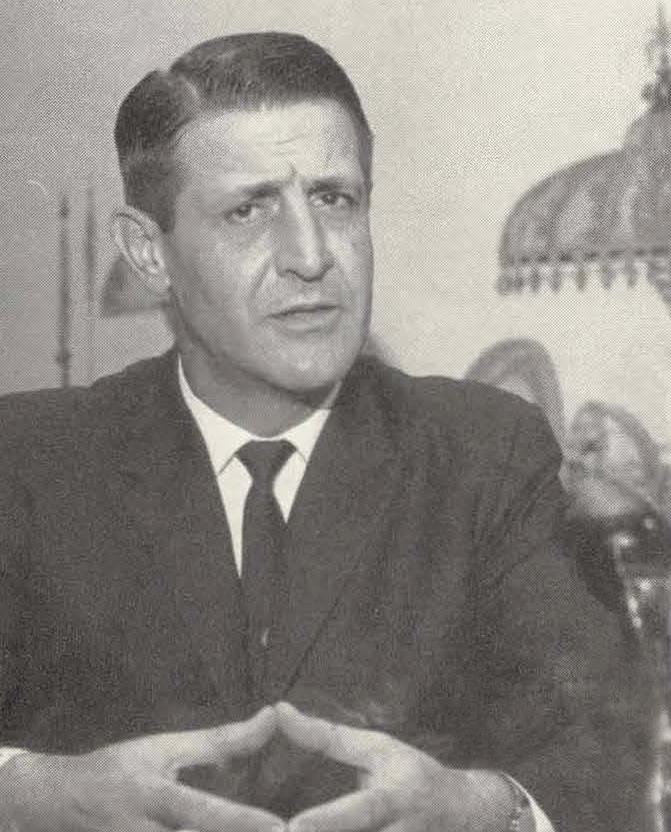
When Cutchin began his duties at OSU, there were more than 130 hopeful young men out for varsity football. They were sorry to see Coach Speegle depart but excited about having a coach who’d been part of a successful program. They were in for the surprise of their lives. According to Click and his teammates, “Cutchin’s practices were brutal. Beyond believable. Cruel.”
THE FORMER OSU TEAMMATES FORMED THE FOLLOWING CONSENSUS ABOUT THAT FIRST YEAR UNDER CUTCHIN.
Traditionally, conditioning drills began after Christmas break with none of the coaching staff present, but this time the new coaches were not only in charge, but in attendance. Conditioning exercises took place in the basement, or bowels, of Gallagher Hall, or the dungeon as it was appropriately named by the players: a dirt floor, poor lighting, no airconditioning or ventilation, always hot, smelly and humid.
For two nonstop hours, players rotated to three stations and spent 20 minutes at each stop. They performed agility drills, ran wind sprints or did isometric exercises (an athlete, with all his strength, pushes against a thick unbendable steel rod) and then it was upstairs to the wrestling mats for 12 minutes against a similar-sized teammate. Coaches constantly ridiculed the players, exhorting them to give more than maximum effort.
Following 120 minutes of non-stop activity, the players, past exhaustion, zombie-like, dripping with sweat, smelly and dirty, drag themselves upstairs to the showers, some needing help to undress.
Leland Slack , a lineman, recalls those bygone days.
“Within a week, physical, mental and emotional stress takes its toll,” Slack said. “Players drop like flies, three or four at a time, leaving at night, without a word to anyone, quitting the team. None of us could blame them.”
“Click talked himself, along with 10 to 12 other teammates, into quitting one evening, and they all walked out the front door,” Elliott said. “Only Jim changed his mind and strolled back in through the rear entrance. We kidded him that he went up about three notches on the depth chart. If there was anybody who didn’t need to stay on the squad and go through all that stuff, it was Click, or ‘Clicker’ as Walt Garrison called him.”
“I absolutely decided to quit and was walking out of Bennett Hall one evening to leave,” Click recalled. “I got to the head of the stairs when I figured I should call my dad and tell him. I was crying.”
“Dad said, ‘Son, I understand. Things are real tough around here, too. I’m having a tough time meeting payroll, can’t collect any money from people who owe me. Economy is bad, not selling any cars. What would you think if I quit on your mom, brother and two sisters?’ I paused, reconsidered and then told him if he wouldn’t quit, I wouldn’t either.”
“One day in the dungeon teammate David Whitfield and I were doing isometrics next to each other. It was a terribly hot and muggy day,” Click said, shaking his head. “Both of us, at the same time, passed out. The coaches let us lay there until, slowly, we started to move and then the trainers gave us a little water. Another thing — those wrestling matches — I never won one, couldn’t whip anyone. Sometimes I had to wrestle fullback Walt Garrison, a real stud, or maybe fullback/linebacker George Thomas, and you know what a great athlete George was. Super strong, built like a rhinoceros.”
FALL 2019 76
PHIL CUTCHIN
“On the constructive side, my freshman and sophomore years, seniors Bob Howard and Mike Miller were great influences. Terrific individuals and encouragers. Those guys meant a lot to me.
By the time spring ball came around in April, there were approximately 45 of the original 130 players on the roster. Twelve weighed 200 pounds or more, but the heaviest tipped the scales at 220 pounds.
Seven players on the spring roster went on to play in the NFL, most notably Garrison, who won a Super Bowl with the Dallas Cowboys, and Charlie Harper, who spent eight seasons with the New York Giants.
“School and practice started in early September,” Elliott said. “But seems like we were a little used to it. We did have challenges. One day five guys passed out during practice. We just practiced around them until the trainers were allowed to give them water and did their best to revive them.
“If a guy playing your position thought he ought to play ahead of you, he could make a challenge, and the two of you would get in an open dirt pit and I mean get after each other. If the challenger won, he took your position and the loser dropped on the depth chart. Jim beat several guys bigger and stronger than him. He was extremely tough, determined and competitive and would give it all he had. To me, that was impressive. I always admired him for that.”
“One teammate I’ve always admired is Frank Shidler, the only walk-on who survived,” Jim said. “Not a big guy, he took a beating every day in practice but stayed after it — a tough little guy. Years later, Frank wrote me the nicest letter, I still have it. I like that guy.
“Also, Jack Jacobson, another one of 130 original guys, tough as a piece of old leather. Harper, a great Christian guy, sends me an inspirational e-mail every morning, and we talk frequently. Hugh McCrabb, dear friend, heck of a player, passed away some years ago. I could go on and on.”
Asked what was extra special about the bond with the 12 players that were in Jim’s class, he replied, “We liked each other, stuck together, suffered together, cried and laughed together, celebrated together and had fun. We have a close camaraderie, a band of brothers.”
The Cowboys were 1-8 that first season with a surefire win against Kansas State cancelled due to President Kennedy’s assassination. It was a tough year.
Players continued to quit and a few suffered injuries so that for the season finale, won 34-10 by the Sooners, only 28 bodies (including Jim) suited up for the Pokes.
Twenty-eight survivors.
Their journey in 1963, albeit a living torment, will never be forgotten. Some participants have difficulty believing they persevered. Others possess a deep sense of pride being there for that final game, their connection with each other thicker than kin.
To paraphrase Socrates, “It’s not always the results that count, but the process and how you respond.”
Kicker Charlie Durkee recalls the Nebraska game the following season.
“The Huskers had this huge defensive lineman, listed at 6-4 and 300, a rarity in those days. We’re getting ready to attempt a 30-yard field goal, and this guy lines up over Jim’s nose. Jim bends down and looks at me through his legs. ‘Durkee, I’m not sure I can hold this big son-of a-gun out very long so you better hurry and get the kick off!’
“I was laughing hard but managed to get off a wobbly kick, which I believe went through. Jim weighed a maximum 180 to 185. Every time he took the field he was outmanned, both with his strength and size, but he had excellent technique, was a smart player and tough — and above all, a terrific competitor.”
Jim’s junior year, the Pokes went 4-6 but were competitive, losing four games by five points or less, including a 14-10 setback to that season’s national champion, Arkansas, led by future notables Barry Switzer, Jimmy Johnson and Jerry Jones

“My favorite tackle I ever made was against Kansas,” Jim said. “We punted the ball, and their All-American and future NFL Hall of Fame halfback, Gayle Sayers, was back to receive. I nailed him just as he caught the ball. Perfect timing, I nailed him good! Only drawback was that Sayers had signaled for a fair catch, and we got penalized. But our coaches loved it, and I graded out real well on that game. It’s still a favorite memory of mine.
“Games were a break for us players, much easier than our ‘journey through hell’ practices. But, you know, Cutchin ran off some terrific football players, notably superb linebacker Marcus Hendrix, the Upton brothers from Stillwater, Mike and Mickey, and a slew more. That really hurt us.”
77 POSSE
JIM CLICK
In Jim’s senior season, the Cowboys went 3-7, with three close losses, but pulled a shocking 17-16 upset win over the Sooners, ending a 19-year drought. Durkee, who went on to spend four years with the New Orleans Saints, provided the razor-thin margin of victory with a gamewinning 35-yard field goal. Long suffering Poke fans were much relieved and considered the season a dramatic success.

Able to breathe once again following this tortuous interval, Cowboy fans joyfully shouted at their brethren to the south: “Poor Sooners! Poor Sooners!”
“There was nothing like the feeling after we beat OU,” Jim said. “OU missed a potential game-winning field goal into the north wind, from about 35 yards. We got the ball back and ran out the clock; absolute chaos broke out! Our fans tore down one of the goalposts. A lot of hurrahs. A wild celebration, well deserved. Pandemonium at its best.
“Our players got to ride back to Stillwater in cars with family and friends, probably drinking some beer. Back in Stillwater, after Spav’s bar closed that night at 2 a.m., we went to an all-night bar in Edmond. On Monday, the administration let school out, and the cheerleaders organized a rowdy pep rally, a huge deal. That afternoon, I’m walking into the Student Union trying to conceal a pitcher of beer behind my back and run into Mr. Iba, who walks up to me, sticks his
finger in my face, has a scowl on his face and says, in that deep baritone voice of his, ‘Son, we’re not going to have any drinking on this campus.’ I answered, ‘Yes sir.’
“I got put on some kind of probation for several weeks and was hoarse for a week, couldn’t talk. But nobody went to jail. Something I’ll never ever forget.”
With his football career over and having earned a general business degree, graduating with honors, Jim headed west to work for his Uncle Holmes, selling cars.
“After a few weeks, I hadn’t sold a single car and was extremely discouraged, really down; I didn’t think I was cut out to sell cars,” Jim said. “So I called my dad and told him I’d rather move back to Altus and run Click Chevrolet than stay in California. Dad said, ‘That’s fine if you quit, and you can move any place you like, but you can’t come back home.’ I loved my mom and dad. That week dad wrote me a wonderful letter, part of which said, ‘Son, there’s no shortcuts to success, no substitutes for hard work; treat every customer fair and they’ll automatically go to work for you by saying good things about your dealership.’
“Where would I be today if I had quit football and the car business? I sold my first car a few days later to a friend of a friend and never looked back. My years in Stillwater were four of the best of my life, even with my Cutchin experience. It helped me grow up. I know that.”
Today Jim is in partnership with his cousin, Robert Tuttle (Holmes’ son), as owners and operators of 15 auto dealerships, with 10 in the greater Tucson area and five in Orange County, California. Last year this operation accounted for over 24,000 vehicle sales, new and used.
“Jim’s success was no surprise to any of us,” Elliott said. “He was smart, determined, focused and had the people skills to do well. One thing that impresses us is that Jim runs in some pretty high circles with powerful people. But when we players get together, he’s the same old Clicker we all knew. He is not one bit different in how he behaves or treats us. He’s the constant. He’s the glue that keeps us former players together. He’s just one of us, and that says a lot. He e-mails us all the time, updating us on former teammates or whatever. Plus, over the years, he’s hosted several reunions in Stillwater and elsewhere, including the 2015 OU game, the 50th anniversary of our 1965 victory.
“Then, there was the ranch reunion, when he flew 12 of us from Jim’s class on his private plane. Expenses paid for four fantastic days at his Idaho ranch. All we had to do was to make it to Oklahoma City and catch the plane.
“In 2012, two years before most of us turned 70, Jim hosted a big reunion in Tucson, inviting back all the players that were on Cutchin’s squad that first year, including those who quit. Jim knew what those guys had been through. The event was held at an upscale golf resort. Jim did it right, first-class all the way, and paid the majority of expenses. Some guys would not have been able to attend if Jim hadn’t paid their way. One of our guys, happy to be included, broke down and cried.”

FALL 2019 78
Jim Click (front, second from right) and Cutchin's Cowboys
“Burns Hargis and Mike Holder showed up at an event for an evening hamburger cookout,” Jim said. “The following afternoon, Boone Pickens attended a reception at the Jim Click Hall of Champions on the University of Arizona campus.
“Cutchin came to several reunions. One time he told a funny story. It was my sophomore year, and Cutchin was riding to a Big Eight Conference meeting in Kansas City with Stillwater alum Jack Griffin, who asked coach about this kid Click from Altus. Cutchin thought, then replied, ‘Jack, if we have to play Jimmy Click, we are in deep, deep trouble.’”
Jim let out a belly laugh.
“Another thing that Jim won’t tell you is that for the past two years he’s entertained about a dozen Wounded Warriors for four days at his ranch in Idaho on the Teton River,” Durkee said. “He takes them fishing on the Snake River with guides, feeds them great food and arranges other activities for them — a nice relaxing four-day weekend for those well-deserving guys to have some fun. On one occasion there weren’t enough beds for everyone so Jim slept in a bedroom above the barn. That tells you something about the guy.”
Jim’s family has endowed two OSU football full scholarships, one for a center and the other in memory of Jim’s good friend and former teammate, McCrabb, a defensive lineman. They also generously underwrote the Click Family Alumni Hall in the ConocoPhillips Alumni Center on the OSU campus.
Said Charlie Durkee, “Jim is really, really, really a good guy!”
Jim’s younger brother, Joey, is a retired musician and resides in Norman, older sister Jill King splits her time between California and Oklahoma and younger sister Janet is deceased. Joey and Jill are both OSU grads. Carrie and Christian (Chris), Jim’s children, live in Tucson.
“I have one grandchild, only one, 11-year-old Sophia, and she is beautiful; loves to be outdoors, good with horses, snowboarding, has the Click spirit. Smart and energetic,” Jim said. “Two years ago I took her up to the Idaho ranch for the first time. When she saw the ‘S’ on the entrance sign, her eyes lit up and she asked me if that stood for Sophia and would the ranch some day belong to her. I told her yes. She got all excited and told me she wanted to move up here right after high school. I informed her she’d have to earn it, and the first step would be to graduate from college. She thought that would be okay. Today she tells everyone they should move to Idaho because it’s so pretty. I’d love to live long enough to see her graduate and get married. Best job in the world is being a granddad.”
Asked what he’d like on his headstone, Jim thought for a few seconds and then replied, “That I care about people, love people, also like to help people with disabilities. Remembered as a guy who loves my family, and I really do.”
JIM CLICK
SURVIVED THE WRATH OF PHIL CUTCHIN AND HIS STAFF, BEAT OU, BECAME LIFELONG FRIENDS WITH TEAMMATES AND TAKES PRIDE IN KEEPING THIS GROUP CONNECTED.

He is generous, perseverant, a successful businessman, has a heart for and reaches out to the disabled, is deeply fond of his OSU heritage, gives nothing less than 100 percent effort, loves his family and, according to Elliott, is the same guy today as he was in 1963 when he first entered the dungeon.
Author welcomes questions/ comments at: osu52johnson@ yahoo.com or 405-922-0096
“He is not one bit different in how he behaves or treats us. He’s the constant. He’s the glue that keeps us former players together. He’s just one of us, and that says a lot.”
79 POSSE
— LARRY ELLIOTT
FLYOVER STATE
Vintage World War II era fighter planes provided a dramatic flyover for the Homecoming National Anthem. The "War Birds" are part of the Spirit of Tulsa Squadron of the Commemorative Air Force.

FALL 2019 80

81 POSSE
WATCH IT OR FEEL IT?
Brothers took aim at brothers. Fathers fought against their own sons. Some families were torn apart by geographic lines, others by political ones. Either way, very little civility existed inside the Civil War — the bloodiest and worst military confrontation in which a not-so-united group of states ever engaged.
Every life lost was an American one. As a reunited country tried to heal, reconstruction became a word many people used but few understood. There were deep scars for which even time might never be a salve. A nation searched, perhaps unwittingly, for something to cinch itself up and may have found an answer in something children do — play games. It seems a game of one type or another can bring people together. Not just in terms of mass, but also in minds.
On a cool November 6, 1869, the first college football game was played. One hundred people, none of them season ticket holders, watched. The College of New Jersey (now known as Princeton) played against Rutgers. The final outcome of the game pales in comparison to the effects of a seed planted in a rich but warravaged soil.
150 years later, today's game is different. No more sandlots. No more offenses aimed at three yards and a cloud of dust. Massive, ornate cathedrals have been raised for the best programs in the country. Spread attacks produce hundreds of more yards per game than were amassed 20 years ago. Television money and a host of other revenue options have made the college game more popular now than it ever has been. ABC, CBS and FOX have put virtually every game, every week, into the living rooms and man caves of millions of fans. The behemoth ESPN has so changed the game, many fans watch uninterrupted three hours of ESPN “Gameday” programming before the sleepy-eyed east coast teams can even complete warmups.
But nothing can replace the surreal experience of attending a home game in person. It's where thousands of families have introduced their children to Cowboy football. They settle into their seats with a hotdog, Pepsi, some popcorn and an impressionable mind. All of the sounds, sights, smells and traditions are passed on to them without any specific strategy to do so. They just know they are having fun and are surrounded by passionate people who care about them.
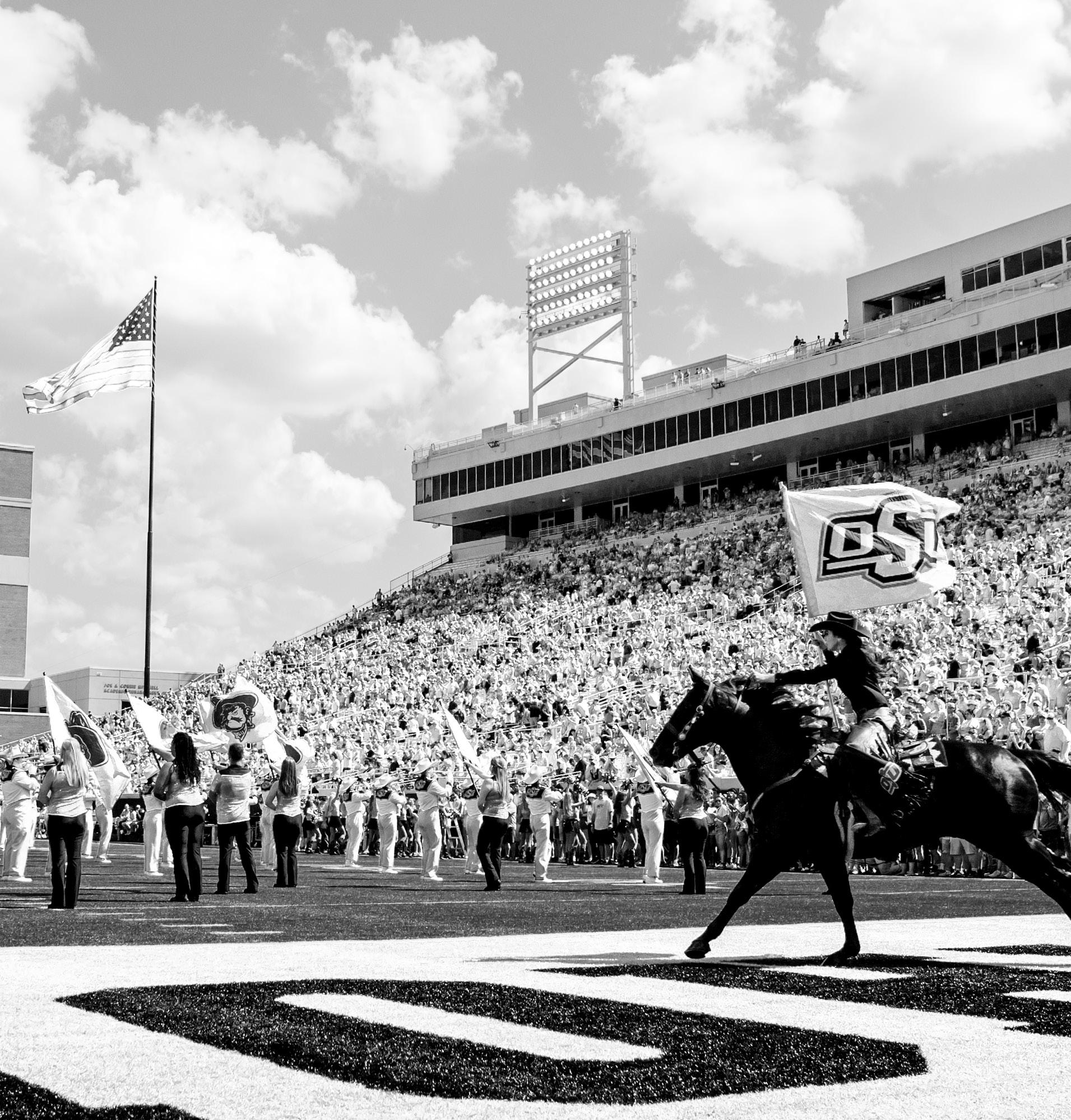
We’re lucky. Our cathedral is as shiny as anyone’s. Our traditions are special. Grab your friends and family and join us in making some memories … SOME BRIGHT ORANGE ONES.
KYLE WRAY Vice President Enrollment & Brand Management
 Kyle Wray OSU @KyleWrayOSU
Kyle Wray OSU @KyleWrayOSU
POKES!
GO
FALL 2019 82







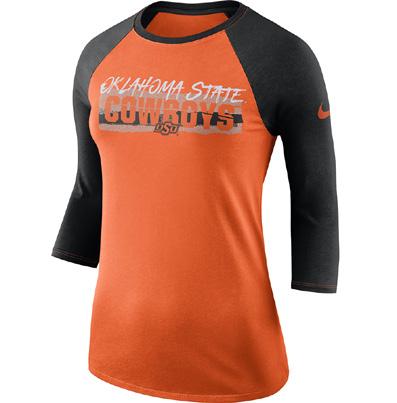

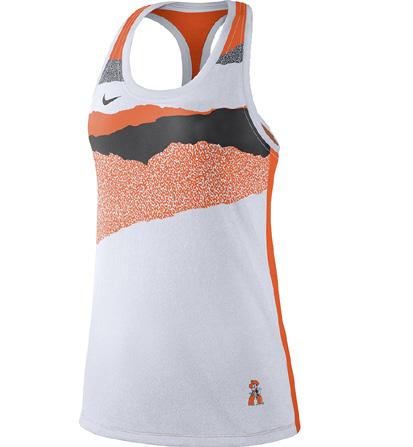
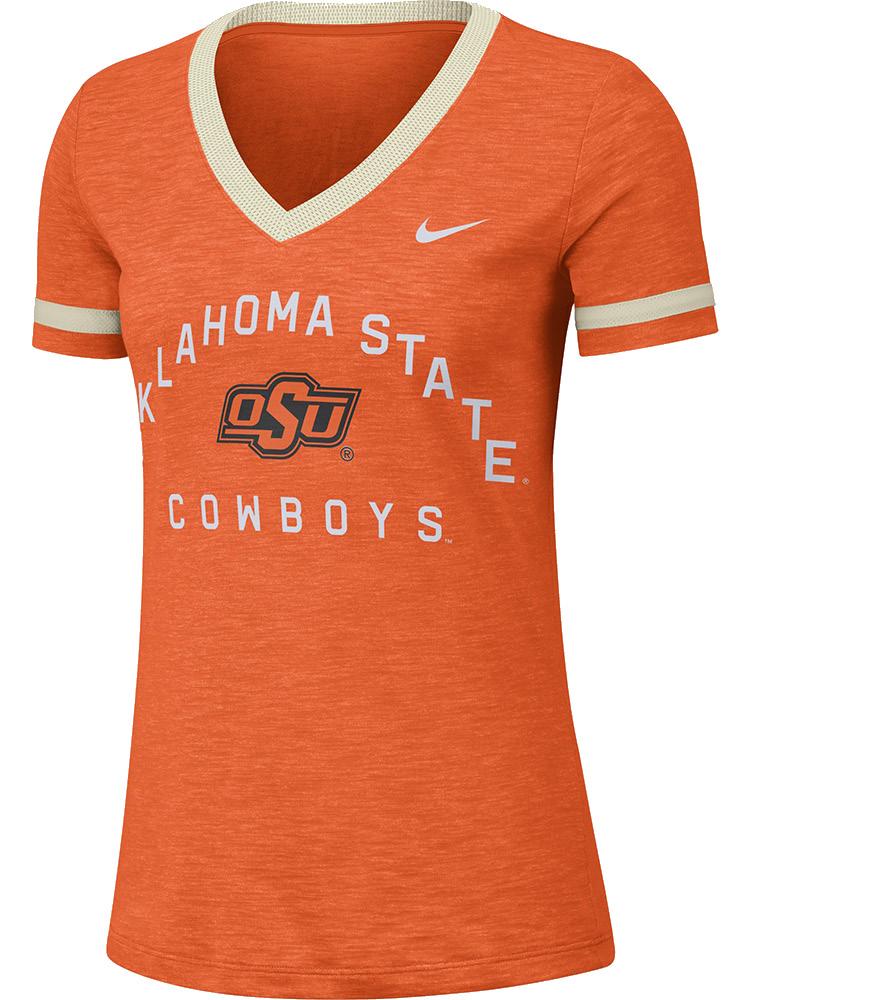

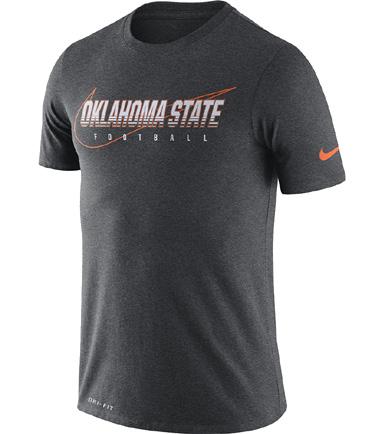



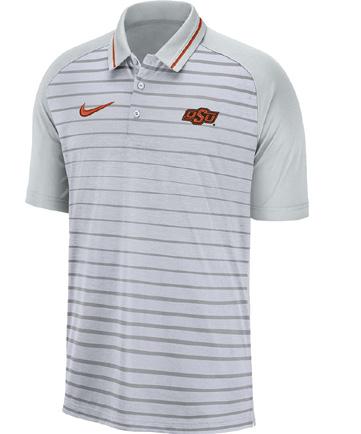
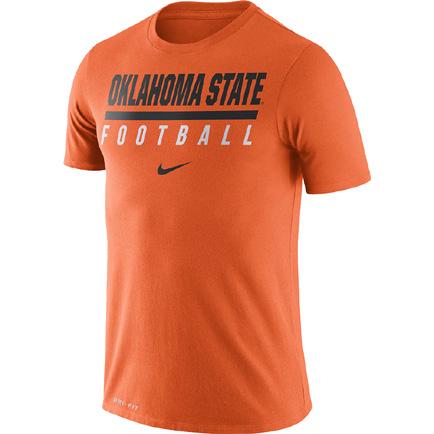

I Nike Orange Slub V Neck Ringer Tee XS-XXL | $35 J Nike White Dry
Tee XS-XXL | $35 K Nike Aero Sideline Visor $28 L Nike Black Dry Crop Top XS-XXL | $35 M Nike White/Orange Dry Blend Racerback
S-XXL | $35 N Nike Orange/Black 3/4 Raglan Sleeve S-XXL | $40 O Nike Badge Football Cap $23 P Nike College Breath Color Blocked Tee XS-XXL | $35 A Nike 2019 Facility Tee S-3XL | $30 B Nike Dri-Fit Polo 2019 S-3XL | $60 C Nike 2019 Icon Wordmark Tee S-3XL | $30 D Nike Go Pokes Tee S-3XL | $30 E Nike #1 Jersey S-3XL | $100 F Nike College Breathe Polo S-3XL | $75 G Nike Vault Brand Dri Cotton Tee S-XXL | $30 H Nike Orange Power Tee S-3XL | $30 SUBSCRIBE AT SHOPOKSTATE.COM TO RECEIVE 10% OFF YOUR FIRST ORDER!
Slub
Tank




the Live Music
the Traditions
America’s Friendliest College Town!
Crowd #FlySWO direct on American Airlines!
Experience
Experience
Experience
STILLWATER V isit and Join the



























































 STORY BY RYAN CAMERON | PHOTOS BY COURTNEY BAY
STORY BY RYAN CAMERON | PHOTOS BY COURTNEY BAY







 STORY
STORY










































 Kyle Wray OSU @KyleWrayOSU
Kyle Wray OSU @KyleWrayOSU









































